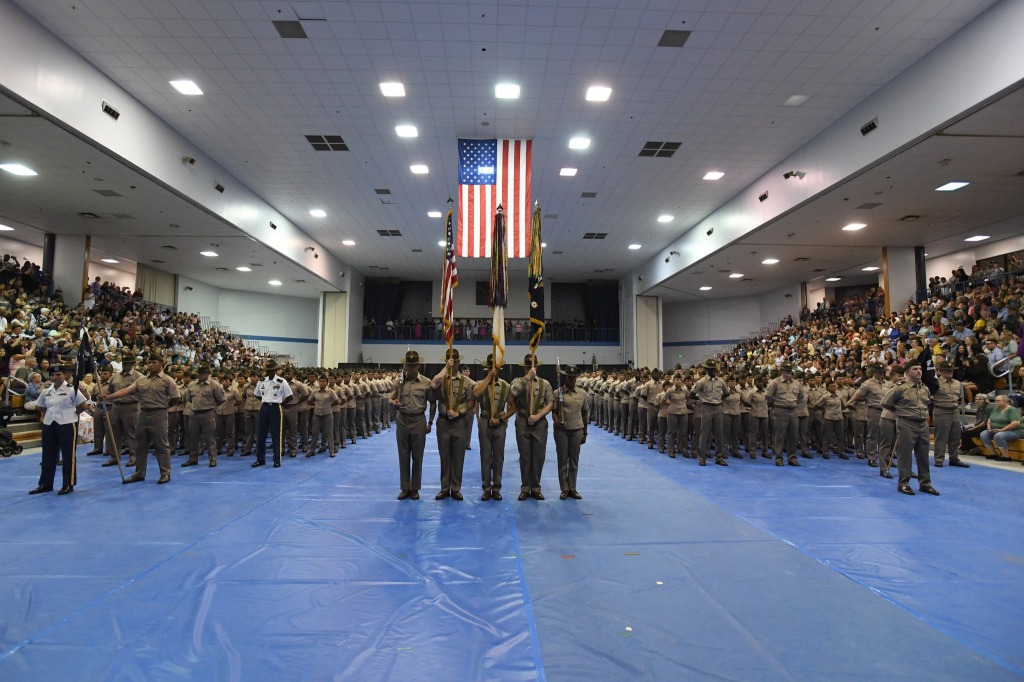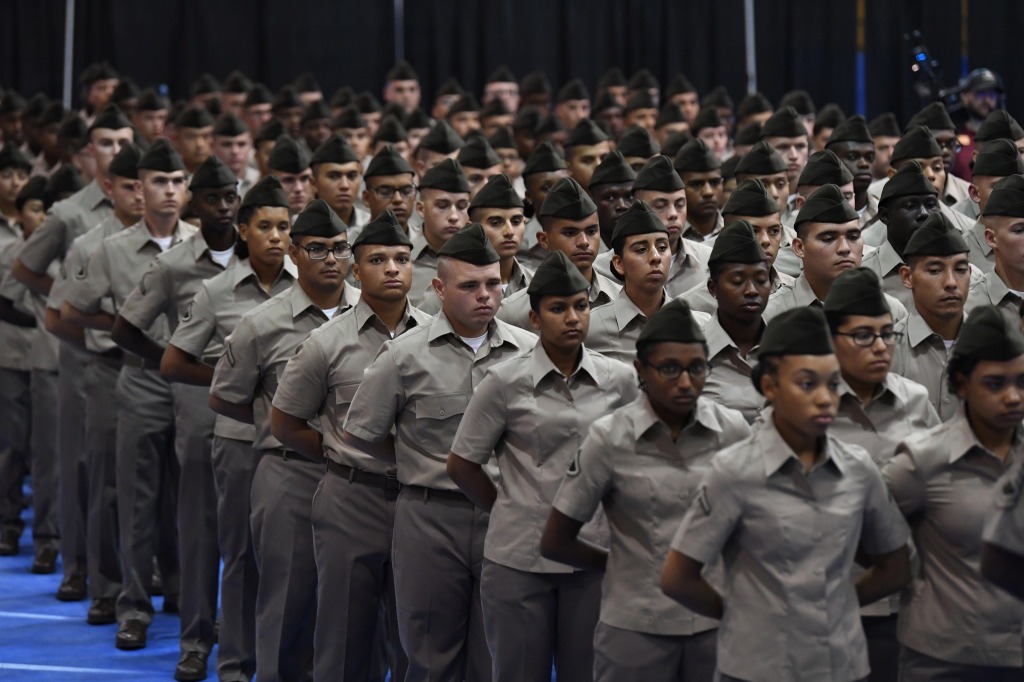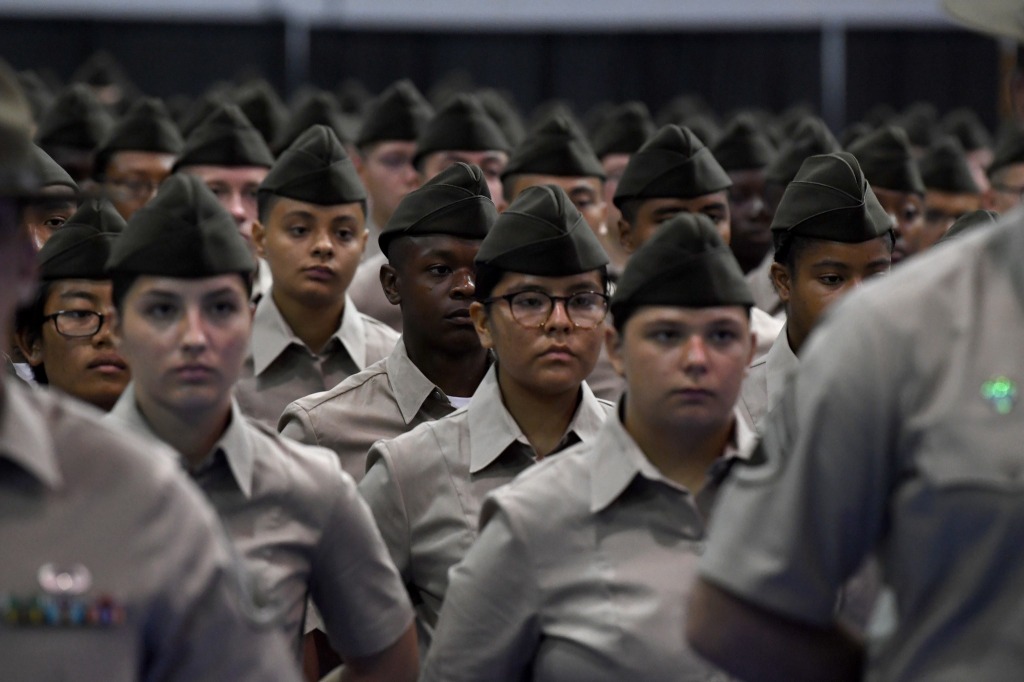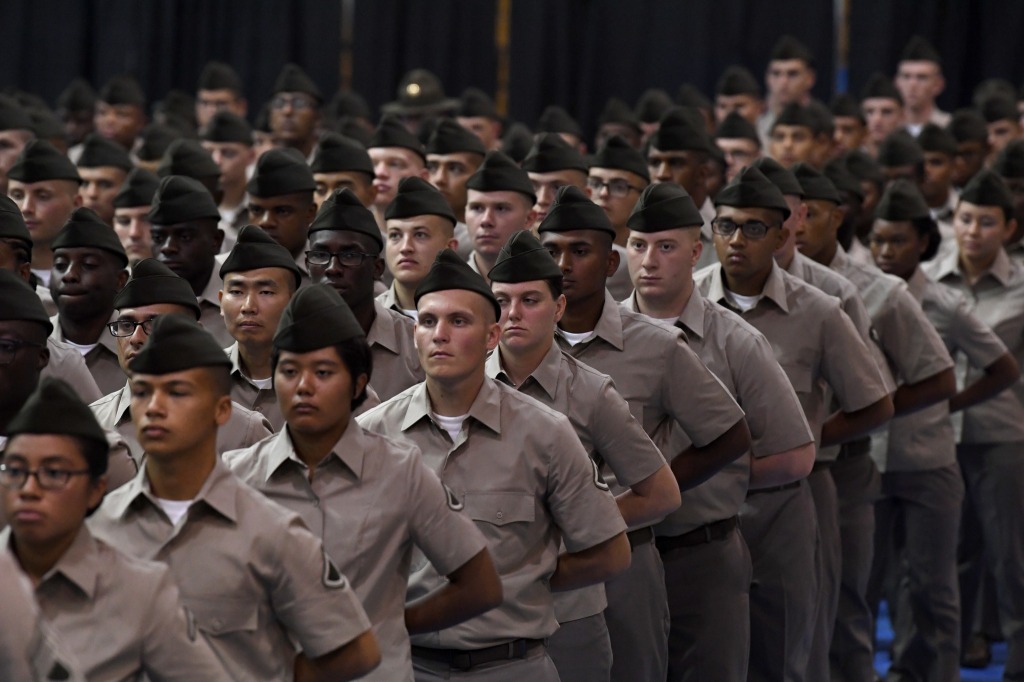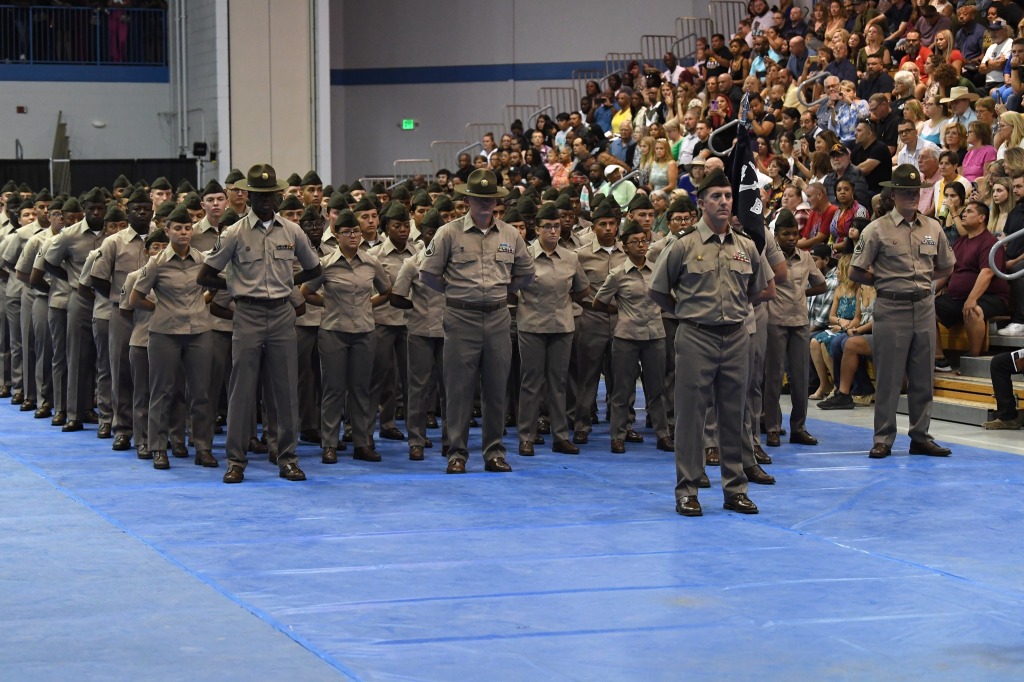In September 2023, I was in conversation with an intelligent business man, who had no experience with the military. He said that a person who said that he “trained soldiers for combat” at Fort Leonard Wood, Missouri, told him that trainees could hold up a card “if you were too mean to them” and you had to back off, and that basic training was so easy now that it is a joke. The businessman told me that his 17 year old son could probably benefit from military service, “like it used to be”, but not now, that he would never recommend his son going in the army, in the shape it is now. It was like a slap in the face. His perception is that the US Army is currently easy and undisciplined almost slovenly.

IN THIS ARTICLE:
First; The flash cards.
Second: Some history. The “old” army. How tough was it? What were the standards?
Third: What’s not being told about the army holistic health and fitness program, the new marksmanship program and the new basic combat training.
Fourth: A complete pictorial look at a basic training cycle this past summer, 2023, at Fort Jackson, South Carolina.
Civilian perceptions:
The “old army” was tougher. Yes – sometimes it was, but sometimes only if you think personal abuse, harassment and unwarranted punishment made people tougher. [The standards were higher] . No – they weren’t. They weren’t tougher 60 years ago, 40 years ago, 30, or 20, or 10.
Basic Training is so easy now, it is a joke. Not true. Army Basic
Combat Training is now as physically demanding as it has been since WWII, and the trainees learn a hell-of-a-lot more now than anytime in the past.
If those are the lies, what is the truth?
I retired after 21 years in the army, it was the high point of my life. I follow the army daily, but what is the news of the army?
What is the news about the army? The past few years Fort Hood, Texas (now named Fort Cavazos) has had murders, kidnappings, prostitution rings and other disciplinary problems on the national news. The army conducted a big investigation and fired several soldiers, starting with a two star general, but neither the US Congress nor the American people will allow a “General Patton” to go in and clean up the place. The country simply will no longer allow a hardcore, butt kicking commander to operate with enough freedom to be effective. A couple years ago the army announced that army-wide it was eliminating the “shark attack” by drill sergeants on the day trainees arrived at their basic training company and the national news reported that the army was going “soft”.
Congress is grilling military and civilian defense leadership that the military is going “woke”, promoting inclusiveness over merit. That the most qualified are being passed over in favor of the most diverse. In many of those incidences I don’t have an argument. There is now a Defense Office for Diversity, Equity and Inclusion, and an Army Equity and Inclusion Agency. Administrations have used the US Army for social experiments, in the past. The army experienced some serious racial tensions toward the end of the Vietnam War. It was an unpopular war fought by draftees who didn’t want to be there. Plus, McNamara’s 100,000 (which became 350,000) morons didn’t help. The army conducted mandatory race relations classes called HUFF and NUFF. Honkey up front and Ni…r up front. You can imagine how those were accepted.
So the news is not good. What about the troops on the line. The “low rent district” as we used to call ourselves in an infantry rifle company. Away from the generals and secretaries defending DEI (Diversity, Equity, and Inclusion) before congress in Washington, DC. There are many comments posted by veterans who left the service because of poor leadership. Happiness in the military depends on leadership. Life in two companies in the same unit can be very different because of the different commanders. That is life in the military.
First: The Flash Cards;
Knowing that the card flashing wasn’t true, but having heard the rumor over 30 years ago, I dug into the story.
The trainee flash card story appears to have started in the 1990’s. “We are the Mighty” is a veteran digital publishing organization that dug into the rumor and published a story titled “The truth behind basic training “Stress Cards””, in December 2022. In the 1990’s, the Navy issued a “Blues Card” to trainees telling them how to get help if they were depressed.
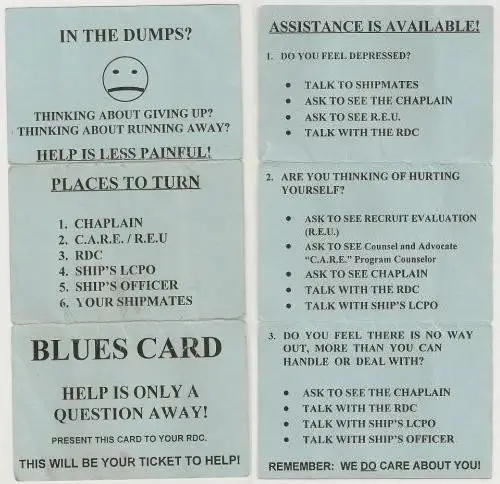
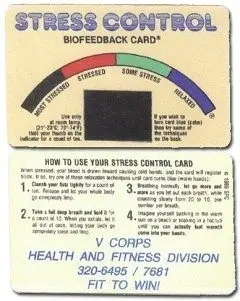
History; How the army arrived at now.
World War II is considered the birth of the modern Army. When WWII started each branch (Infantry/Cavalry/ Artillery, etc) prescribed the training for that branch. There was no basic training and then skill training. Combined basic/Infantry training went from 8 to 12 to 13 to 15 to 17 weeks at the start of 1944, and it fluctuated from post to post. Trainees were graduated at 15 weeks as a result of the Philippine invasion in the summer of 1944, then it went back to 17 weeks, then the Battle of the Bulge casualties brought it back to 15 weeks.
When the draft started in September 1940 all men age 21 to 35 were required to register, as the war went on that increased to 18 to 65. Initially the requirements to be accepted were; Be over 5’0” tall and weigh at least 105 pounds. Not have flat feet, hernia, or venereal disease. Be functionally literate. Have at least 12 teeth. Have vision correctable with glasses. Initially about half were rejected for one reason or another. Almost 20% because of literacy, they couldn’t read or write. As the war continued men under 5’ tall were accepted, those who had VD were treated with penicillin and inducted, they could be toothless, be missing ears and fingers just so they had a thumb and a trigger finger on one hand. The literacy requirement settled at being able to read and write at a fourth grade level. My uncle, on my mother’s side, was blind in one eye. He was inducted and served in an engineer unit.
The training was physically hard and intense. There was very little pure harassment to get their attention. Most were draftees and everyone knew they were going overseas to the war. Getting in good enough physical condition to withstand the rigors of combat and learning soldier skills might save their life. Harassment wasn’t necessary. My father was 27 when he was drafted in July 1944 and sent to Camp Robinson, Arkansas just outside Little Rock, for seventeen weeks of basic/infantry training. He wrote to my mother almost everyday. Upon arrival, he wrote about the homesick young boys who would do anything to get out of there and back home. One said that he was going to throw a fit when they were outside the next day, to see what they would do. One wet the bed at night, the doctor “gave him hell” about it and he didn’t do it anymore. He wrote about the runs and the four or five mile hikes at night. He wrote about their rifle weighing 9 pounds and the helmet 7 with a total load of about 65 pounds, before water and ammunition. He wrote that the sergeants had all been overseas and knew what it was like, and that they were “really good fellas”. He said that their lieutenant did everything that they had to do. Leading by example.
The physical fitness test in WWII was called the AGFT (Army Ground Forces Test). If the test was conducted indoors, the shuttle run and squat thrusts were substituted for the 300 yard run.
WWII Fitness Test Scoresheet
| Points | Pullups | Squat Jumps | Pushups | 2-MIN Situps | 300 Yard Run | Indoor Shuttle Run | 60 SEC Squat Thrusts | |
| EXCELLENT | 100 | 20 | 75 | 54 | 79 | 44 | 41 | 41 |
| Good | 74 | 12 | 50 | 39 | 62 | 47.5 | 44 | 35 |
| Fair | 58 | 9 | 39 | 31 | 51 | 50 | 46 | 31 |
| Poor | 42 | 7 | 30 | 26 | 41 | 52.5 | 48 | 27 |
After the war basic training was separated from individual skill training. It settled in at 8 weeks, and stayed at 8 weeks through the Vietnam War. Combat soldiers, infantry, artillery, armor, combat engineers, went to a “second eight” and training for support jobs varied. The “second eight” was and is still called Advanced Individual Training (AIT).
Immediately after WWII the United States went from 12,000,000 men in uniform to around1.5 million in the space of about a year. The army “kicked back”, basic was easier as was all training, if training was conducted at all. Units polished their vehicles, including tanks and basked in the glow of victors. They had “whipped the world”, the war was over. Then in June 1950 North Korea invaded South Korea and we went to help – totally unprepared. Troops weren’t trained, units weren’t trained, equipment wasn’t ready and the supply system didn’t work. It was a rout, the US Army retreated, some units were overrun. Morale was nonexistent. When the 3 star general commander on the ground was killed in a vehicle accident, the army sent a new 3 star, Matthew B. Ridgway. In just a matter of weeks he turned the situation around and started on the offense. To do so he fired colonels, one, two, and three star generals and replaced them, but this time (unlike WWII) he was told to keep it “low profile”, just move them to another job. Army leadership was afraid congress would get upset at the firings.
Basic training became more intense during and after Korea, but then was standardized throughout the training bases and again became more relaxed.
I went through basic training in September and October 1961 at Fort Knox, Kentucky. The 6th Armored Cavalry Regiment was reduced to cadre strength (just officers and sergeants) and given the mission of conducting basic training. There weren’t drill sergeants then, just sergeants assigned to the job of long hours and no extra pay. They weren’t bad sergeants, but at that time, it was a bad job. It seemed that the only fun they had was coming in after lights out and a few drinks, getting us up and dumping our foot lockers then telling us to be ready for an inspection in the morning. That happened once. Our Platoon Sergeant was a Sergeant First Class with a Staff Sergeant and a Sergeant as assistants. The staff sergeant and sergeant came in drunk around midnight, dumped our foot lockers and told us those lockers would be inspected at first call – 04:30. After our Platoon Sergeant heard about it, it never happened again. The army fitness test then was called the Physical Combat Proficiency Test (PCPT). It consisted of a 40 yard low crawl, horizontal ladder, dodge-run-jump, and 150 yard man carry or a hand grenade throw.
Some pages from my basic training class book, graduating November 3rd 1961.
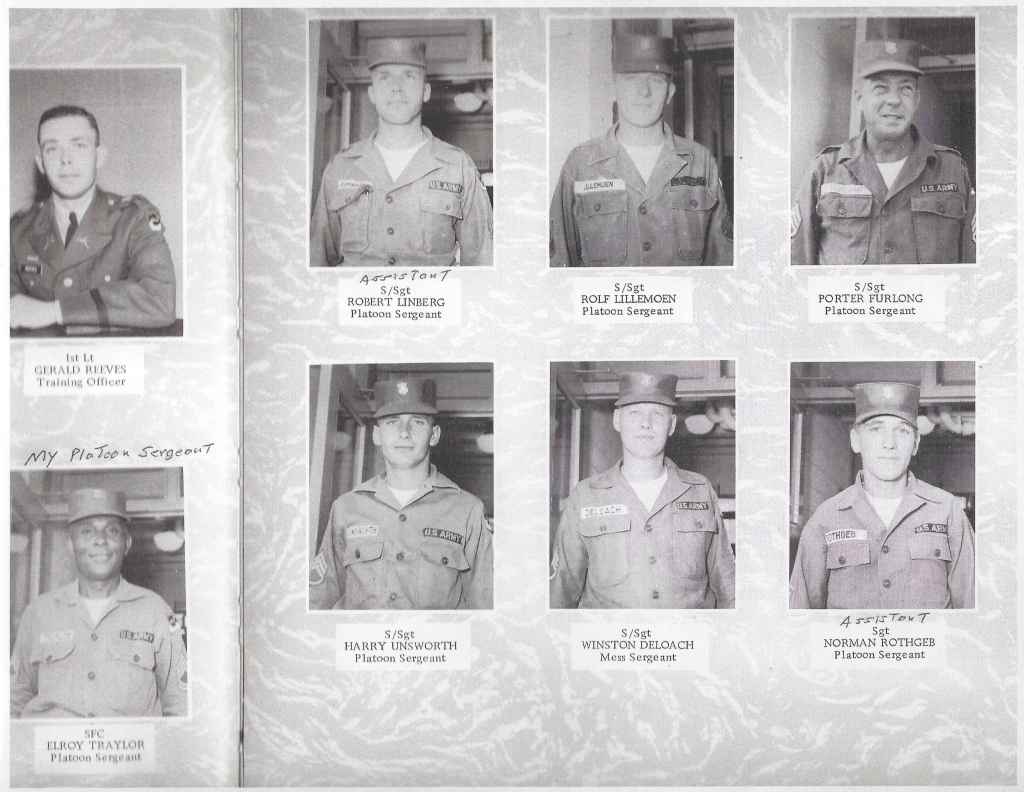
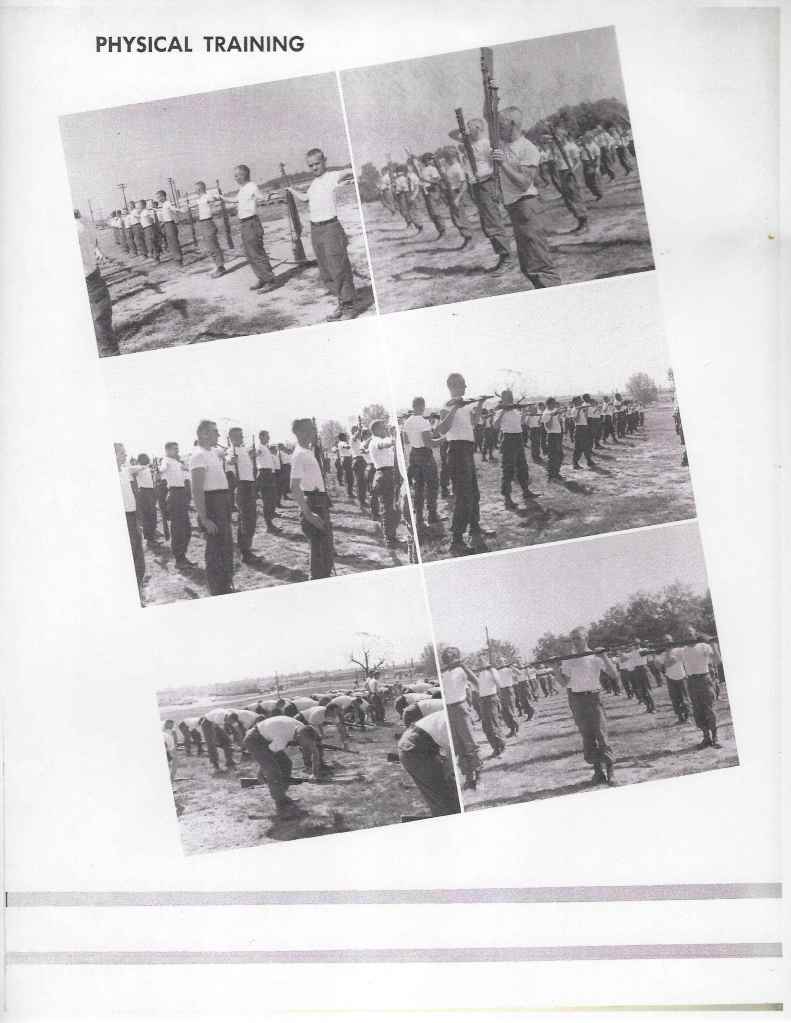
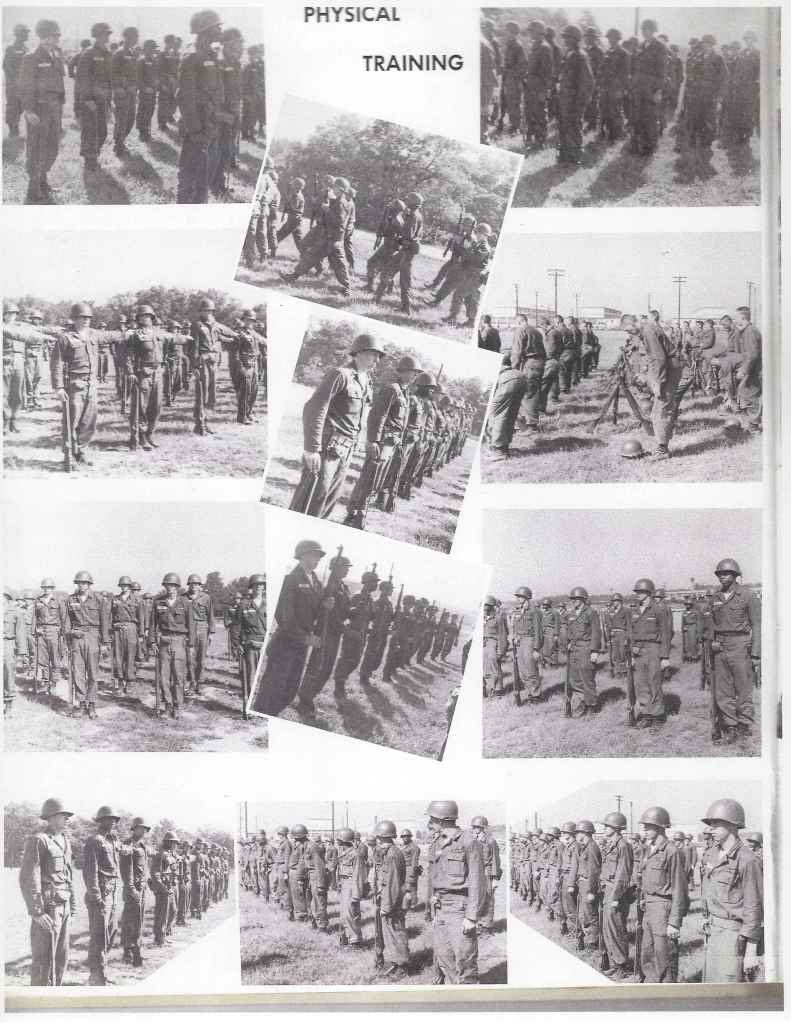
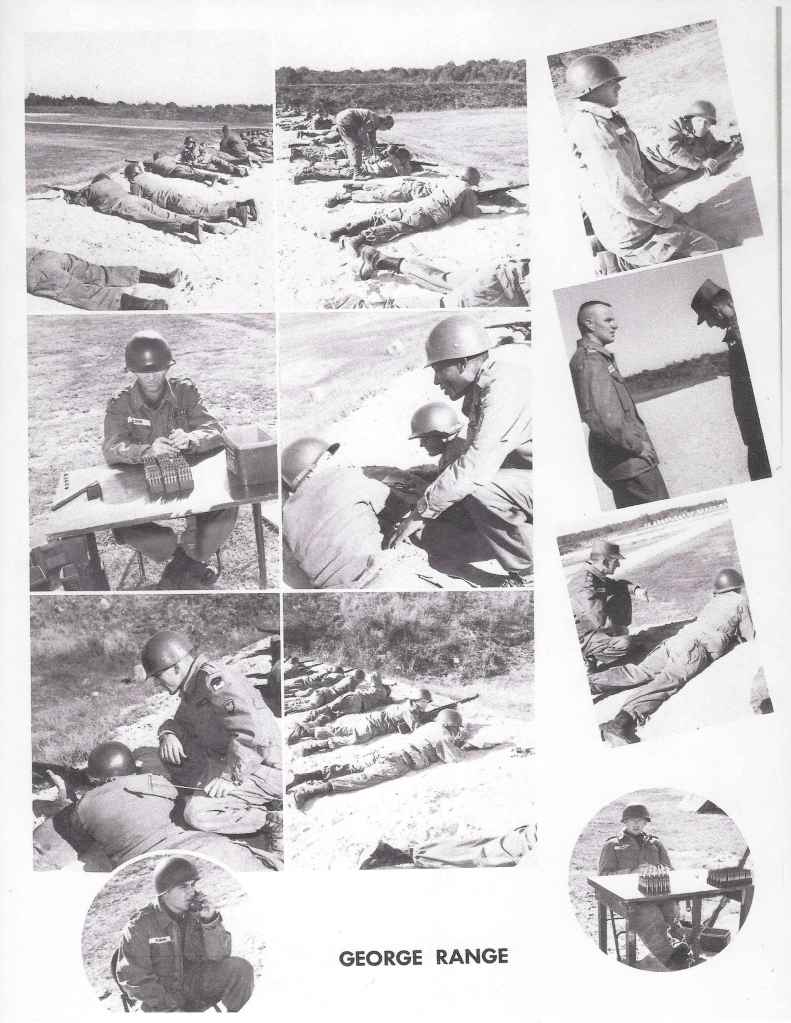

The following is from the artofmanliness web site where they have a good article on the test. It was started in 1959, made mandatory once a year in 1965, and codified into a field manual in 1969.
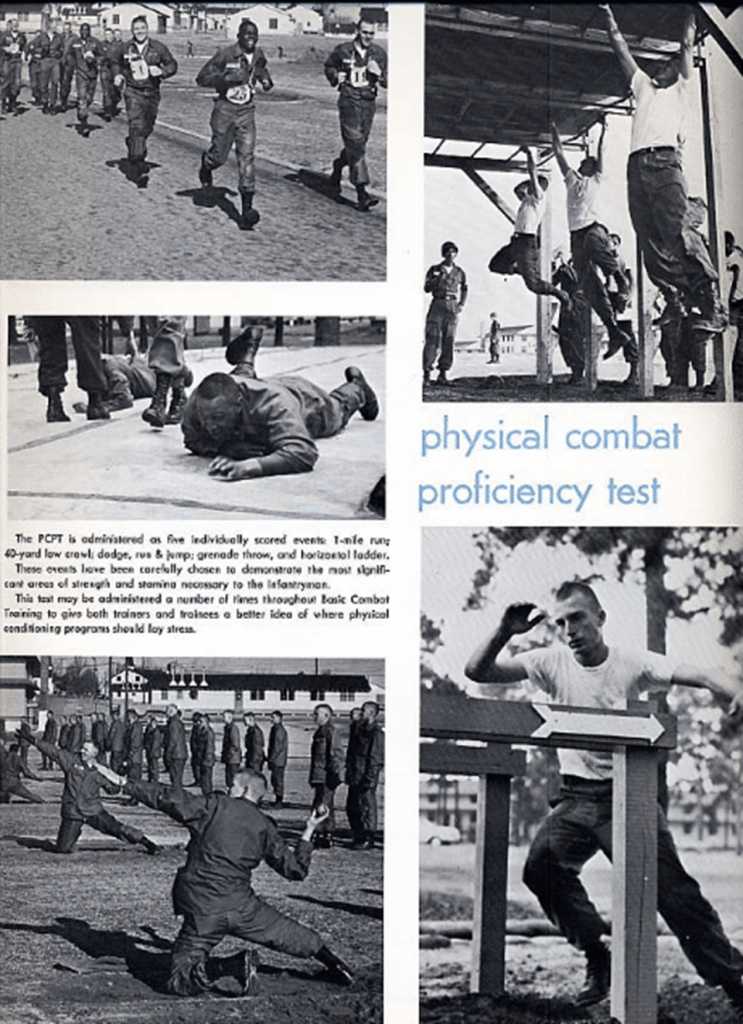
I then went to Fort Gordon, Georgia for eight weeks of infantry training. Most of the sergeants had just returned from Europe or Korea and didn’t really want to be pushing trainees. Sometimes it would be too cold to do PT (physical training) in the morning (Augusta, Georgia). I think we spent as much time drinking beer at the PX on the other side of the parade field as we did in any kind of physical exercise. We were overweight and out of shape when we graduated from infantry school in January 1962.
Drill Sergeants were created in 1964 with the first Drill Sergeant School established at Fort Leonard Wood, Missouri. That was also the start of the build-up for the Vietnam War. When the casualties started piling up in Vietnam and the draft increased, army basic training changed. Unlike WWII there was nothing popular or assumed necessary about the war in Vietnam. Public protests against US involvement in the war became more frequent and violent. Most of the incoming trainees were draftees and did not want to be there. Drill Sergeants “attacked” trainees, establishing dominance, when they arrived at their company and didn’t let up for about three weeks. The message was “talk back to a drill sergeant and go to jail”. At that time, most army posts still had a correctional confinement facility called the post stockade.
Harassment and abuse was accepted as necessary tools to break the civilian mentality, create a unit/platoon mentality (mass punishment does that), and to weed out those who won’t make it. The training also changed during Vietnam. Less time was spent on drill, inspections, uniforms and military courtesy so more time could be spent on how to “pop smoke” and not step on a pungi stick in the jungle. The physical requirements to complete basic training were not that hard. The requirement to pass basic training was pass the PCPT, qualify with the M-16 rifle on a slowly controlled pop-up target range, and pass the end of course tests. There were recycles and retests until the trainee passed.
Jeff Morgan, who was drafted in June 1966 and went through basic training at Fort Dix, New Jersey, wrote; “My worst memory is watching the DI’S take the overweight recruits out to the track behind our barracks and making them run extra laps so they would lose weight and pass the PT tests They would curse, kick and punch them until some of them would cry. Many of them were draftee’s and didn’t want to be in the Army anyway and now they were being mistreated.”
The Vietnam War literally destroyed the US Army.
General Bruce Palmer Jr., who was a three star corps level commander in Vietnam, said; “We didn’t understand the Vietnamese or the situation, or what kind of war it was. By the time we found out, it was too late.”
The US sent units to Vietnam to stay but the soldiers only had to stay for one year, so when their individual year was up they went home, and a new replacement was assigned. That created constant turmoil in combat units with experienced soldiers leaving and being replaced by inexperienced replacements. Company and battalion commanders were changed every six months, to the minute, to give more officers war time command experience. Drugs were not only readily available, but rampant, supplied by the enemy. Many who were drafted, put through training, then sent to Vietnam and did a good job, were promoted to sergeant as they left Vietnam. Units in the states received those sergeants, who were drug users and had six months left in the army. Units forwarded weekly lists of suspected drug users up the chain of command to higher headquarters.
Another large contributor to the destruction of the army in Vietnam was McNamara’s Project 100,000. That was a department of defense program initiated, during the Vietnam War, by Defense Secretary Robert McNamara to allow 100,000 enlistees and draftees who did not meet the minimum standards into the US military. Some had physical shortcomings or impairments, but most scored far too low on the Armed Forces Qualification Test (AFQT) to be admitted, some to the point of being mentally handicapped. There were almost 350,000 actually admitted under that program, 71 percent of them to the army. Not only were they three times more likely to be killed in combat, they were difficult to train, 7 to 9 times more likely than their peers to require remedial training, 11 times more likely to be reassigned, and far more likely to be disciplinary problems in their units, many were administratively discharged from the service. They were called “McNamara’s Morons”. The program was promoted as a vehicle to lift some out of poverty. It did not. It has been described as a cruel social experiment, many were unemployable after leaving the service. After being processed into the service they went into the normal training pipeline with all others.
The commander in Vietnam from 1964 to 1968, General William C. Westmoreland, was considered by many peers to be “not that smart”. In the fall of 1972 when General Creighton Abrams, who had replaced Westmoreland in Vietnam, was awaiting confirmation as Army Chief of Staff, was told by a general friend, “Your army is on its ass”. As Chief of Staff General Abrams initiated an “Expeditious Discharge Program”, which gave commanders authority to administratively discharge drug users, gang members and general troublemakers. Over 2,500 were discharged in Europe alone.
Also at the same time, because the defense budget was cut due to the withdrawal from Vietnam, the army conducted a “reduction in force”. Many officers who did not have very outstanding records were released from active duty (kicked out). Some who had been commissioned through Officer Candidate School reverted back to an enlisted rank. Morale, according to army slang at the time, was “lower than whale dung”.
The last men drafted into the military was in December 1972. The draft officially ended June 30th 1973, creating the “all voluntary” army. Also in the early 1970’s the Women’s Army Corps was discontinued and women were integrated into the regular army in all non-combat units and jobs. With the influx of women and the all volunteers, basic training got easier. That wasn’t Department of Defense policy, it was just individual commanders and drill sergeants trying to figure out how to train those new young, smart volunteers, and especially the women. A drill sergeant’s job is to turn civilians into soldiers, to train them and get them through basic training, not run them off, so discipline did suffer, as did training. The Army slipped basic training to six weeks. They sometimes called it seven or six and a half weeks, but it was six weeks. I did eleven cycles as a Drill Sergeant 1979 – 1981, it was six weeks. Ten of those cycles were one fourth or one half women. On road marches and runs I put the women up front, and they set the pace. In October 1981 basic training went back to eight weeks.
Ah, but that was the “old army”, where was the “old army” of low crawls around the barracks at night, cleaning the latrine (bathroom) all night with a toothbrush, falling outside in formation with your foot locker then back in for an immediate inspection. It was still there, – selectively. Until very recently sergeants chosen for drill sergeant duty were not screened for their education, ability to communicate, personal morals and character. They were just selected, as were recruiters. In the 1970’s and 80’s being selected to go on recruiting duty was considered a career death sentence. I volunteered to be a drill sergeant rather than be picked up for recruiting duty. So, in the mid to late 1970’s most army drill sergeants had come into the army during the Vietnam War, had been through “Vietnam War training”, and had at least one usually more tours in the war, and now they were to train all volunteers, including women, who wanted to be in the army. Sometimes it didn’t work out so well.
In June 1978 two Drill Sergeants, at Fort Jackson, South Carolina unloaded a bus load of new recruits and had them run around and around on a steep sand covered hill carrying all of their clothing and gear, in over 100 degree temperature, for over an hour. Two collapsed and died. One drill sergeant was convicted of involuntary manslaughter and one of negligent homicide. Drill Sergeants, the Drill Sergeant School, and the entire program underwent intense scrutiny. It was not uncommon to see the Commanding General (CG) of Fort Jackson step out of the shadows during early morning formations or PT (Physical Training). Training companies were commanded by a Captain, with a Lieutenant executive officer, often it was the first job of a new 2nd lieutenant. One morning, in early 1979 at Fort Jackson, during their first week, trainees were practicing the hand salute. One wasn’t holding his hand correctly, so a lieutenant physically adjusted his hand. The Post Commanding General was standing within hearing distance. The lieutenant got a royal butt chewing for not telling the trainee that he was going to physically touch him, before adjusting his hand.
In 1980 the army started the Army Physical Fitness Test (APFT), consisting of pushups, situps, and a two mile run, with scoring adjusted for gender and age. Pushups, Male, Minimum – 60 points – 42, Max 100 points – 71; Female, Minimum 60 points – 19, Max 100 points – 42. Situps, Male, Minimum – 60 points – 53, Max 100 points – 78; Female, Minimum 60 points – 53, Max 100 points – 78, 2 mile run, Male, Minimum 60 points – 15:54, Max 100 points – 13:00. Female, Minimum 60 points – 18:54, Max 100 points – 15:36.
Also, in 1980 the department of defense initiated the Joint-Service Job Performance Measurement/Enlistment Standards (JPM) Project. The largest coordinated study of job performance ever. It involved millions of dollars and hours and thousands of people. Correlation between ASVAB scores and job performance were measured, physical condition and performance, social well being (criminal record) and performance, education, and performance, etc. Within that study, in 1983 a Committee on the Performance of Military Personnel was formed to provide an independent technical review of the research and measurement issues involved in (1) the development of hands-on job performance tests for jobs of first-term enlisted personnel, (2) the collection and analysis of data from test administrations, and (3) the linking of resulting performance scores to military enlistment standards as defined by scores on the Armed Forces Qualification Test (AFQT). In 1989, the Committee on Military Enlistment Standards was established to oversee the technical issues concerning the development of a cost/performance trade-off model for use in setting enlistment standards. The project concluded in 1994 when current enlistment standards were established.
In 1996 three Drill Sergeants at Fort Leonard, Missouri were charged with having sex with female trainees. One was eventually acquitted, two went to prison. Five days after that scandal made the news, the biggest sex scandal the Army would suffer occurred at Aberdeen Proving Ground, Maryland. There was sexual harassment, sexual abuse, and multiple counts of plain rape. All twelve Drill Sergeants and the Company Commander, in a training company were charged. Four went to prison, including the Captain, the others were discharged or received non-judicial punishment. The Post Commander, a Major General, received a letter of reprimand and was allowed to retire. Three other senior officers received letters of reprimand.
In 1998 the Army went to a nine week basic training and started teaching Army values. Loyalty, Duty, Respect, Selfless Service, Honor, Integrity, and Personal Courage are taught and reinforced in all army entrance schools. If you wear the uniform those are your values.
When the Iraq and Afghanistan wars cranked up again many “soldier things”, like drill and ceremonies and spit shine inspections were again given only cursory attention or dropped entirely, in favor of preparing for “the war”. Basic trainees were taught about convoy’s, how to conduct a convoy and how to react to an attack on a convoy. Mock Afghanistan villages were set up and basic trainees were taught how to deal with Afghani civilians. In 2007 the Army was not happy with the soldiers graduating from basic training so it was increased another week, to 10 weeks.
Drill Sergeants changed their approach to young people coming into the army, young people who have not experienced much, if any, discomfort in their lives. Many high school classrooms are similar to college classrooms, with open discussions. Most have never been yelled at, and many are raised with few rules, at home. They question orders and they want to know why, so Drill Sergeants adjusted. The Army tried not to make basic easier, but the result was it did. Also, during that time, the Army took Drill Sergeants out of AIT and replaced them with AIT Platoon Sergeants. Same job, same hours, no extra money, and wearing the same hat as the trainees.
Things got so bad that major commanders were complaining to Army Headquarters that new soldiers were arriving at their first unit with a sloppy appearance and undisciplined attitudes. Then the Army conducted a survey of 27,000 commissioned officers, warrant officers, and non-commissioned officers (NCO’s) (sergeants). They observed a trend, which was getting worse, of new soldiers fresh out of training displaying a lack of obedience and poor work ethic as well as being careless with equipment, uniform, and appearance. The number one thing that was asked for five-fold or five times as much as any of the other categories was discipline.
In 2015 the Secretary of the Army and the Chief of Staff of the Army directed a complete rewrite of the basic training program and training schedule. Strict discipline, drill, marching in formation everywhere, inspections, new PT test with higher standards, more realistic combat training exercises, more emphasis on basic skills, such as first aid, hand and arm signals, and shooting rifles with iron sights (apparently everything had gone to scopes), and more time in the field. The new curriculum was to add two more to weeks basic training, but budget restrictions prevented the extension of basic, so the new curriculum was instituted within the present 10 week time frame. The result was longer days, six days a week.
What the army has been doing, that people don’t know about.
The US Army Holistic Health and Fitness Program.
About the same time that the new basic training curriculum was being developed, a new physical fitness program was being instituted. One obvious slap in the face to army leadership was that the American soldier was not in good enough physical condition for sustained combat in the heat of Iraq or the mountains of Afghanistan. Regular Army PT (Physical Training) was not preparing soldiers for the physical rigors of combat. Also, during those wars, especially Afghanistan, soldiers in many support jobs found themselves in combat on convoys and at small outposts, so the army created a “Combat Action Badge” for soldiers other than infantry who engaged the enemy. There were a lot of combat veterans, in the Army, when the discussion started about how to evaluate soldiers’ preparedness for combat. As the new Army Combat Fitness Test (ACFT) was being developed, a much more radical change in physical training was also being developed. This was not just a change in physical training, but a program that holistically encompasses the soldiers’ life, physical, sleep, nutritional, spiritual, and mental. The study on physical fitness began during the Afghanistan War and was several years in development.
The driving force behind all this was readiness. In February 2019, more than 56,000 soldiers were non-deployable. Also, more than 21,000 were on a temporary injured list, and more than 15,000 had some kind of permanent injury. Almost half of all soldiers are injured at some point, and 71% of those injuries are lower extremity micro-traumatic musculoskeletal “overuse” injuries. In 2018, more than 12% of soldiers had some form of sleep disorder and 17% of active duty soldiers were overweight. Also, included in this conversation, was active duty suicide. How ever many, it’s tragic, traumatic, and too many. For the Army to be able to field a healthy, fit, lethal force, soldiers’ lifestyle had to change.
The Holistic Health and Fitness program was developed. The Army calls it the H2F Program. In 2017, the Army identified a few battalions to run pilot H2F programs. Several sergeants from those battalions were sent to the Master Fitness Trainer school. Civilian Athletic Trainers, Strength Coaches, Physical Therapists, Occupational Therapists, and Dietitians were hired and placed under the supervision of those Battalion Commanders, who were tasked with implementing the program and identifying any bugs. The medical people and the Chaplain and Chaplain Assistant, were also brought into the H2F Team. Chaplains are not part of the program to preach, but monitor unit morale, and help with personal problems. There is a rule in the Army, anyone can go see the Chaplain anytime. Chaplain’s and their assistants are presented with all kinds of problems.
On October 1st, 2020, the Army published Field Manuel (FM) 7-22, Holistic Health and Fitness. That made the program command policy, army wide. The H2F staff, for each brigade, is under the direction of the Brigade Commander. The H2F Program Director is a civil service GS-13. Under the Program Director, is a Captain, Nutrition Director, with civilian and military dietitians, a Captain Injury Director/Provider, with military and civilian physical therapists and a contracted civilian athletic trainer for each battalion, a Captain Combat Enhancement Director, with civilian and military occupational therapists. There are also civilian strength coaches advising the professional military physical trainers. My personal observation is that an actual life style conversion of soldiers is going to take a few years, but will eventually happen, if the army can keep it going.
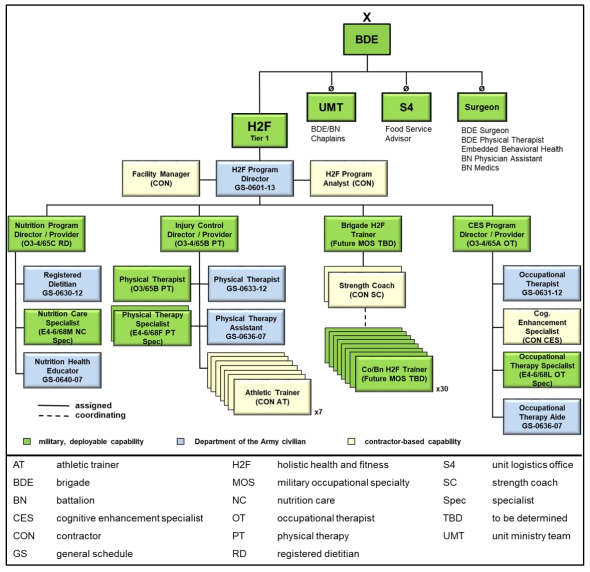
Also initiated in October 2020 was the new Army Combat Fitness Test (ACFT), which was designed in conjunction with H2F. It is a six timed event test. Initially, there was to be no point adjustment for age or gender. It was, “how capable is this soldier of performing in combat”. As soon as it was made public, Democrat Senator Kristen Gillibrand of New York, who is on the Senate Armed Services Committee, complained to the Secretary of Defense that the army had created a physical test that women couldn’t pass. One event, “the leg tuck”, was replaced with the “plank”, and scoring adjustments for age and gender were implemented. The annual National Defense Authorization Act (NDAA) in 2023 contained a provision requiring the army to implement an age – gender neutral fitness test for combat jobs only. The army said, we are already doing that and made no changes. As of this writing the approved senate version of the 2024 NDAA scraps the ACFT completely and requires the army to go back to the old pushups, situps, and run PT test. The house of representative version again contains an enhanced requirement that the army have a gender-neutral fitness test for combat jobs only. The two versions will have to be resolved in the coming weeks.
The army values the physical fitness of a soldier above many other characteristics. Physical fitness is considered in assignments, schools, and promotions. The higher the fitness score, the more promotion points. Aside from job performance, physical fitness, rifle marksmanship, and civilian education are the three big items considered in soldier promotions.
Minimum passing score on the ACFT is 360 points, 60 on each event. The scoring below is for the 17 to 21 age group.
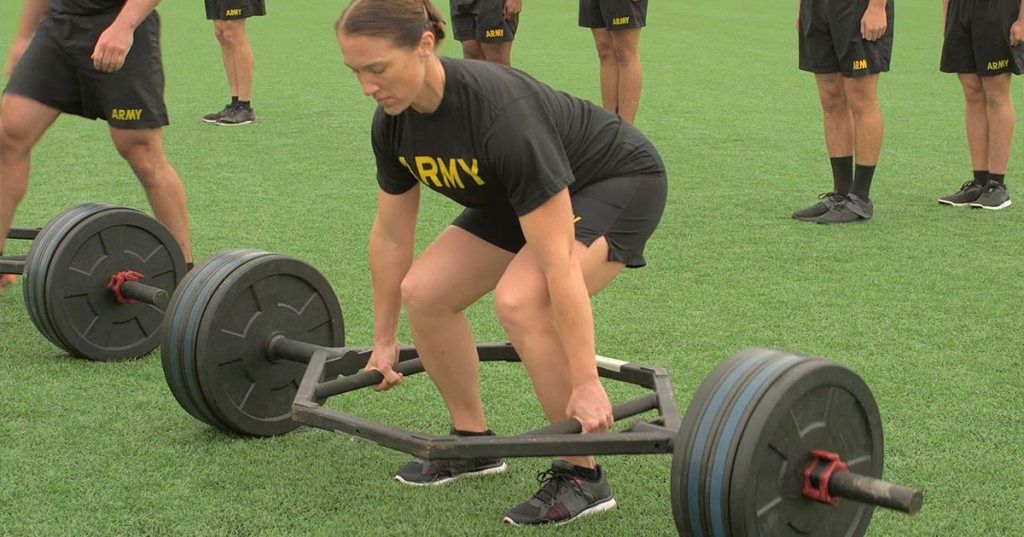
After weight lifting, it is on to the Standing Power Throw..
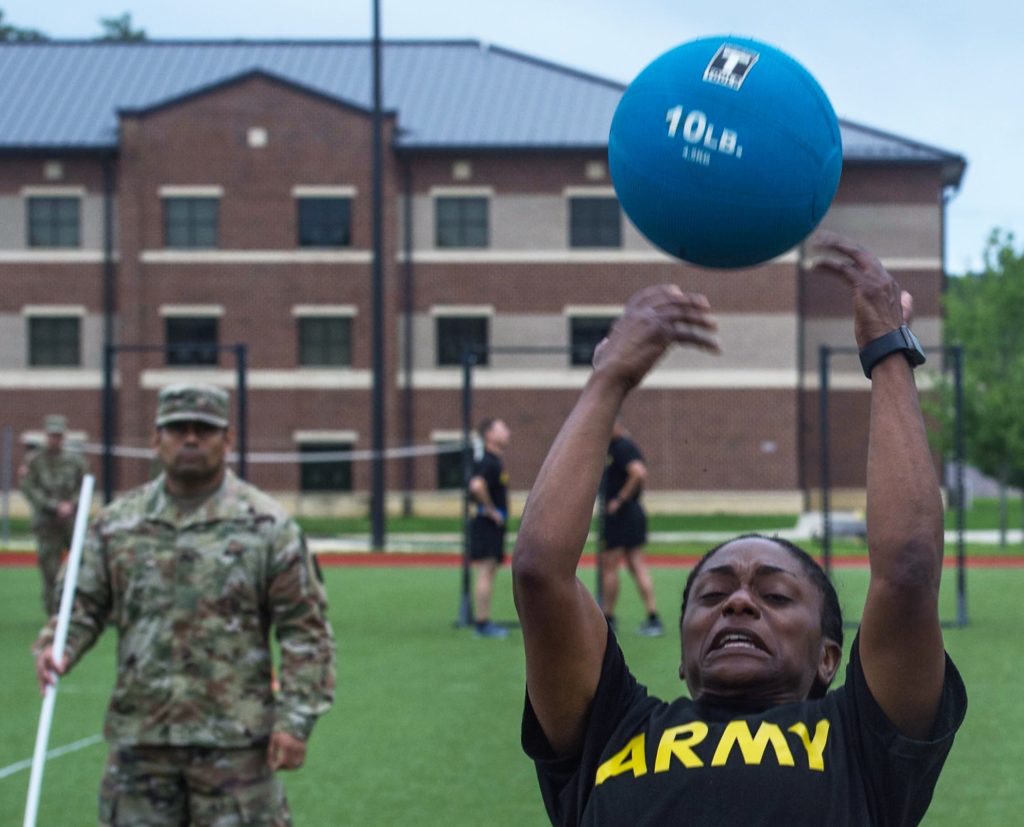
Minimum 60 points – Male – 6 meters, female – 3.9 meters. Max – 100 points Male – 12.6 meters, female – 8.4 meters.
Then to the Hand Release Pushup.+
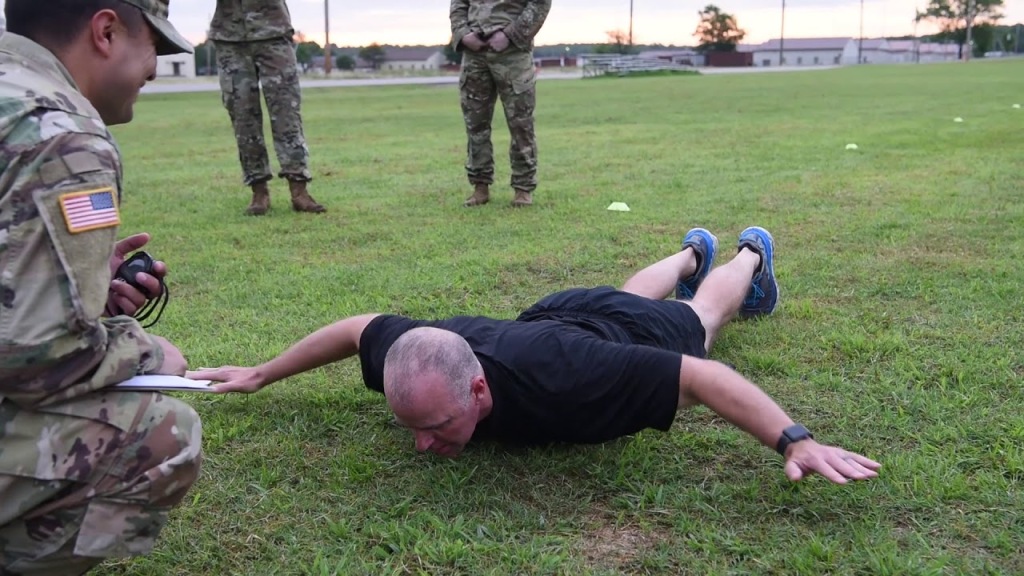
After the Hand Release Pushup is the Sprint, Drag, Carry.
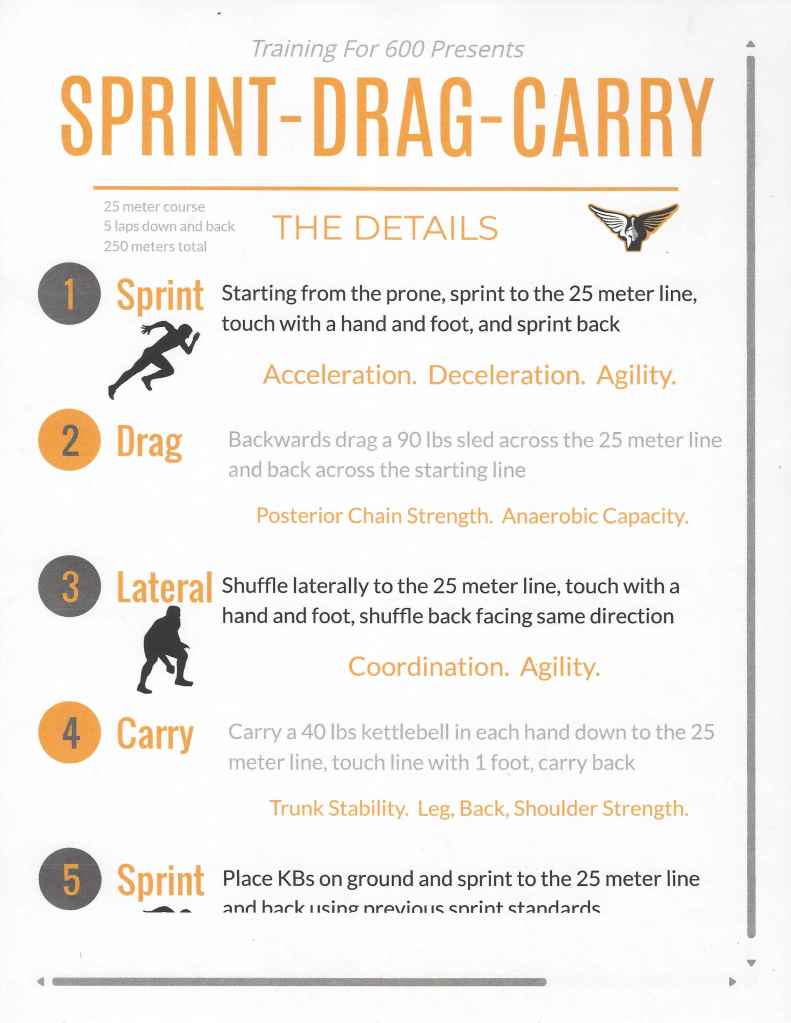
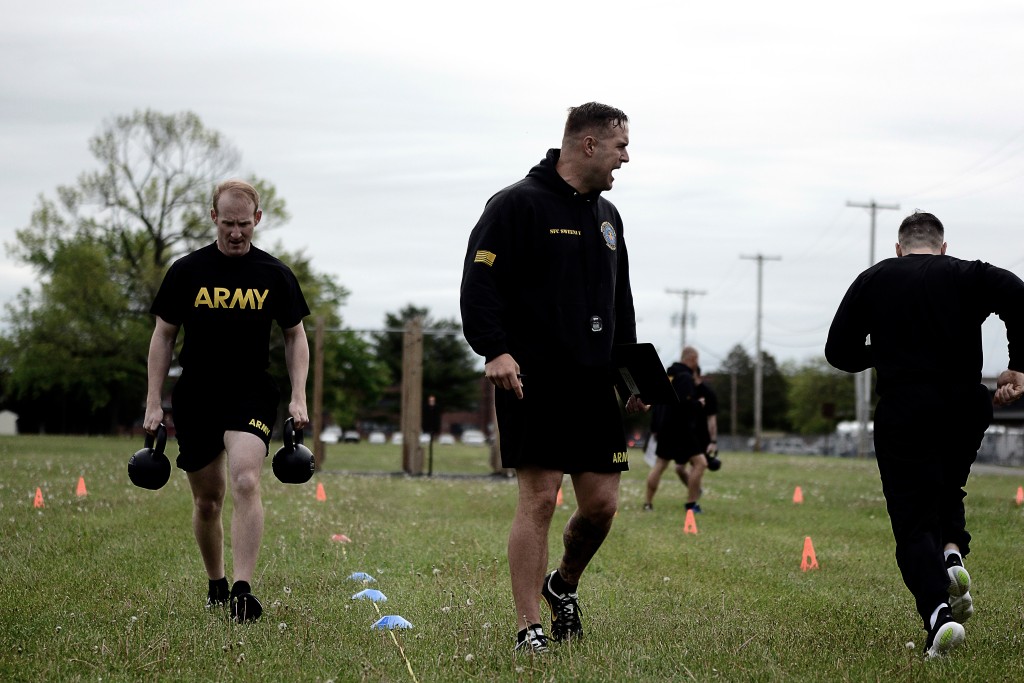
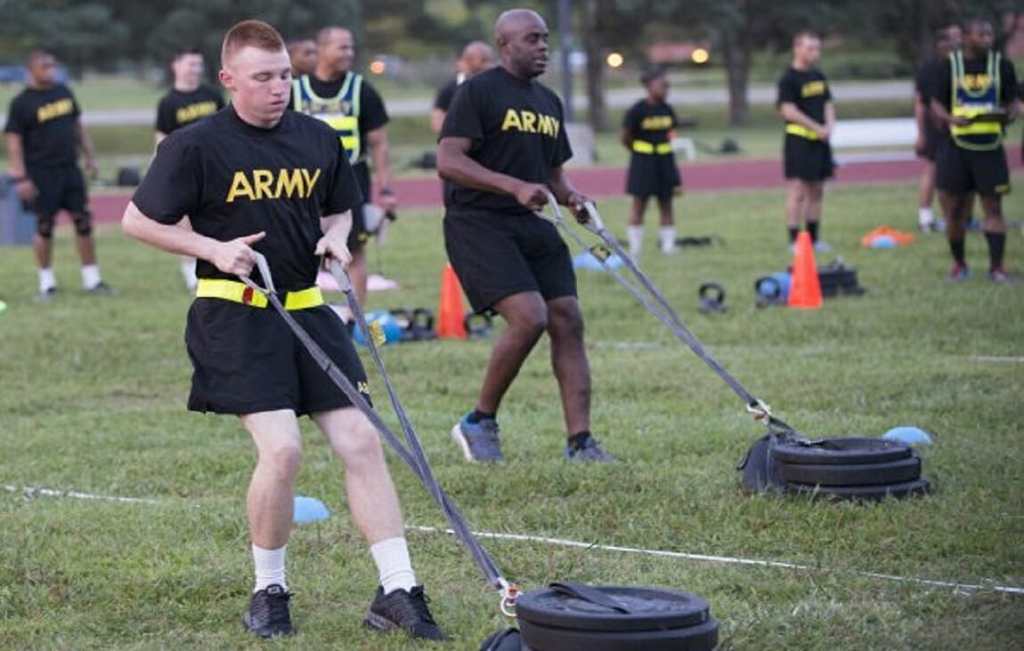
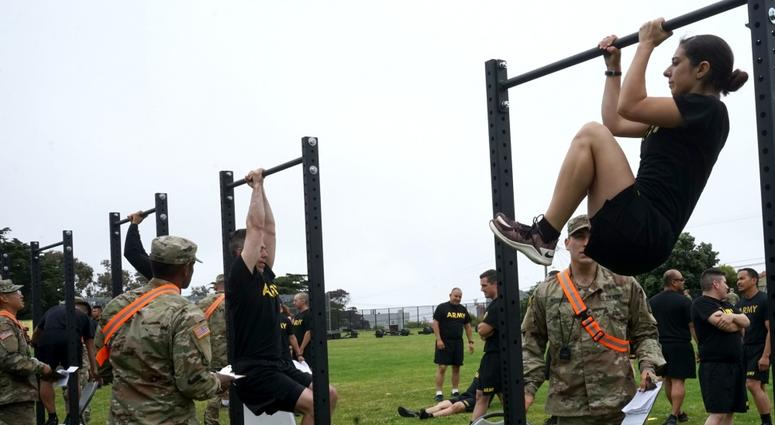
Under pressure from congress the ACFT Leg Tuck (Hang on the bar, bring the knees up to touch elbows, as many times as you can, was replaced with the Plank.
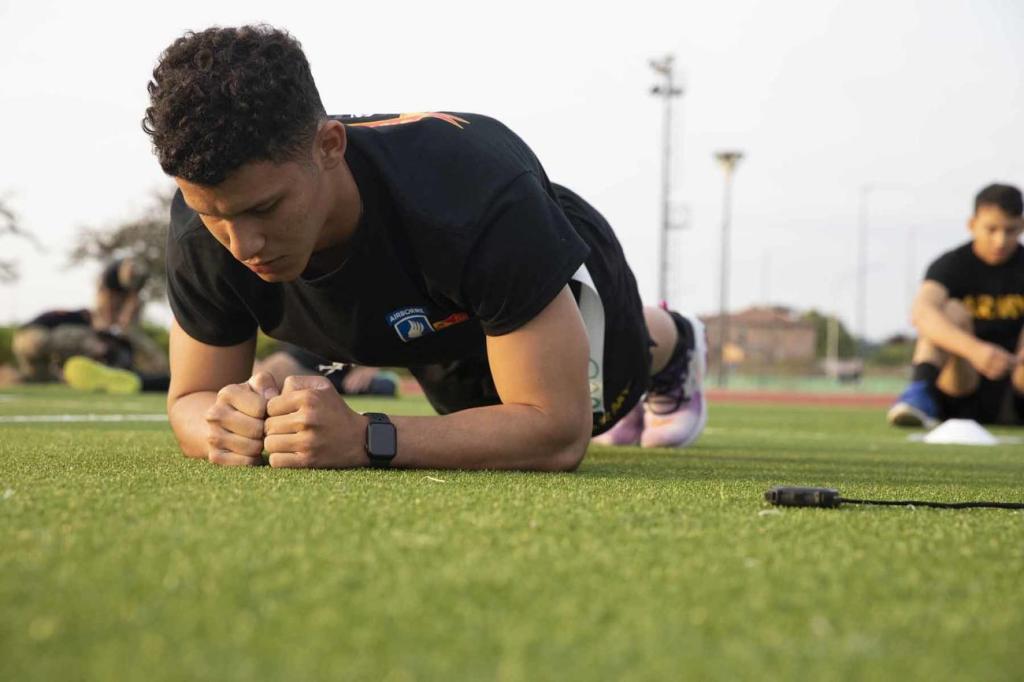
And last, the two mile run;
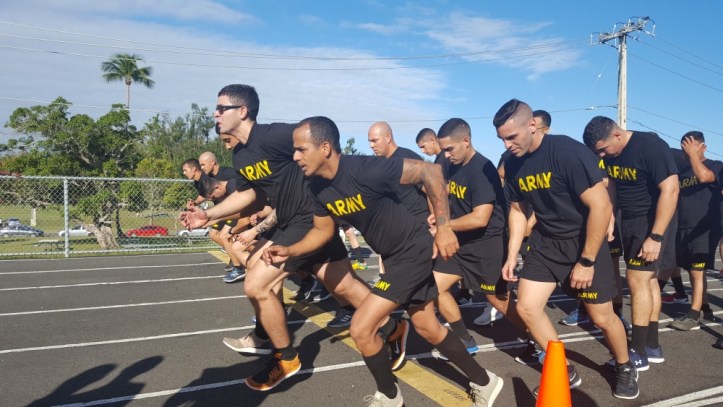
Another new army thing the people don’t know about.
The new Rifle Marksmanship Program.
In 2019 there was another big change in basic training and throughout the army when a new marksmanship program was established. Under the old program, for the previous 50 years, all soldiers, once a year, drew their rifles, went to the range, zeroed the rifle on a 25 meter range, then went to the qualification range. Qualification firing was from a supported foxhole, with four magazines, each containing 10 rounds, stacked in front of the shooter. After 10 rounds were fired at the pop-up targets, the command “change magazines” came from the range control tower, then shooting resumed. If a shooters’ weapon malfunctioned, during firing, and he or she couldn’t immediately correct it, the shooter held up his hand and claimed an “alibi”, which caused a range cease fire until the weapon was functioning. When I was a Drill Sergeant, before the trainees moved onto the range, the drills would grab a rifle and go “knock down” the targets, to make sure they all worked. We all could hit 40 out of 40 targets. Someone once said that a drunk monkey could qualify as an expert, if given enough time on the range.
On July 30th 2019 the Army published TC (Training Circular) 3-20.40 Training and Qualification – Individual Weapons. It is 800 pages of specific guidance for weapons qualification, to be followed by every unit in the Army, regardless of the type of unit, including in basic training.
Now all army units, regardless of the type, are mandated to conduct the same annual weapons qualification program. It starts with classes on how to properly zero their weapon.
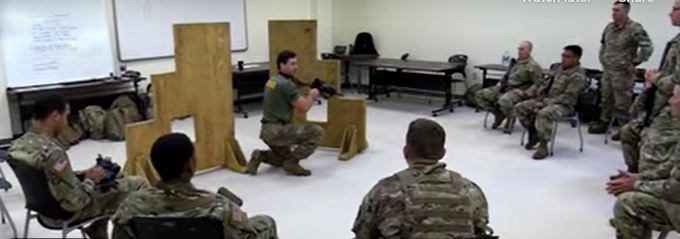
After which, the soldiers must pass a written and a hands-on test before moving to the next phase, which is firing with the simulator. The simulator is the army’s Engagement Skills Trainer, which is an elaborate, indoor, laser based unit with a large screen 26 feet from the firer, displaying terrain and targets, with feed back hits and misses. The rifle is of the same weight, producing sound and recoil very similar to the real thing. After successfully firing on the Engagement Skills Trainer they go to the actual range for dry drills.
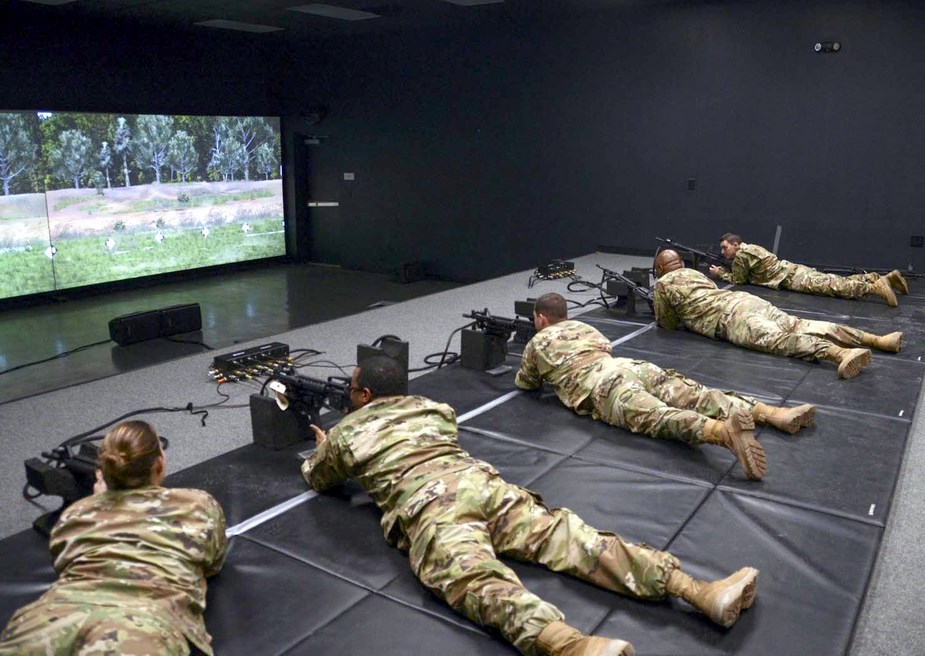
The dry drills are of how they will fire for qualification, which is not all in a rested foxhole, but in prone, kneeling, standing supported, and standing unsupported, and quickly moving between firing positions, just as they would do in combat, and with their ammunition magazines in their pouch, not laid out, and changing magazines automatically, not on orders from the tower. In fact, there are no orders from the tower, except, begin, and there are no alibies. If a weapon malfunctions, get it going or lose shots, because now instead of one target at a time popping up, as many as four pop up at one time. The old way took about 20 minutes to fire 40 rounds, this takes about four minutes.
After the dry drills, they go to the zero range and zero their rifles.
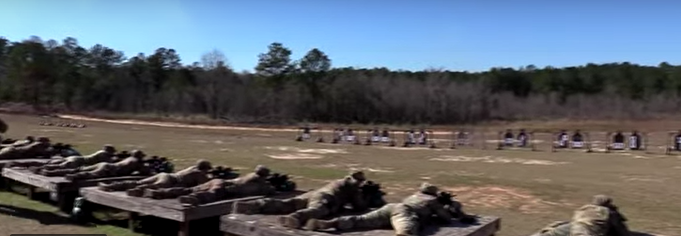
Next is practice qualification, go through the whole qualification, with live ammo, but for practice. Finally, qualification.
One sergeant rifle marksmanship instructor said that he always shot 40 out of 40 on the old way. His first time this way he shot 22 out of 40.
Firers change positions on their own, starting with standing unsupported, just like a reaction to contact, then drop to the prone unsupported, then to a kneeling supported position, and finally to a standing supported. Under the old system, a soldier could fire “Expert” without hitting a 300 meter target. Now there are five exposures of the 300 meter targets, so at least one has to be hit to qualify as an expert,


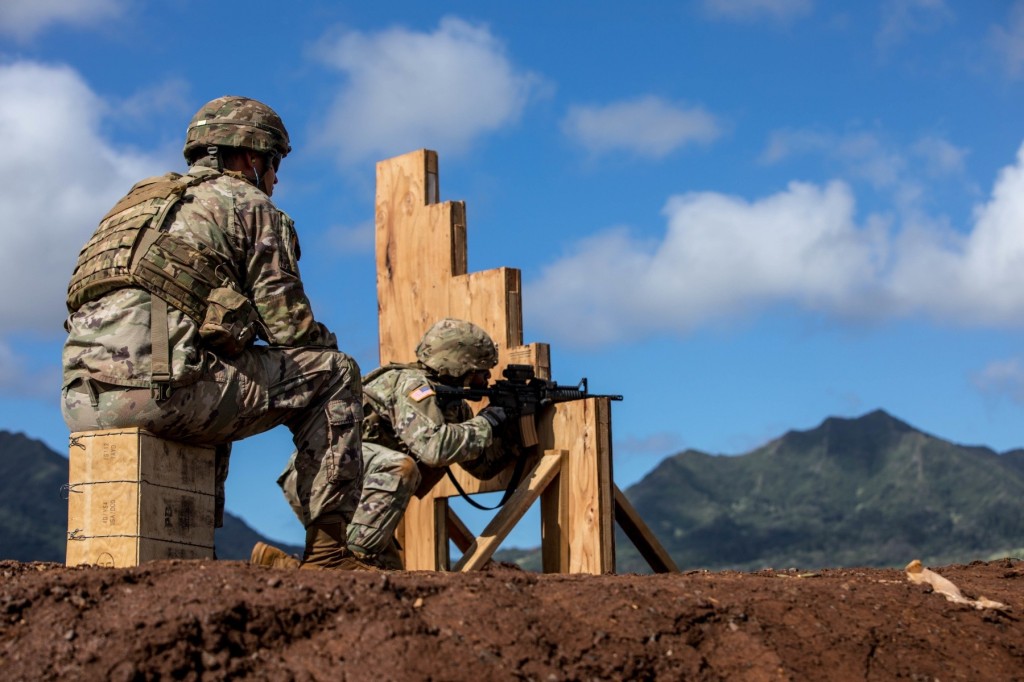
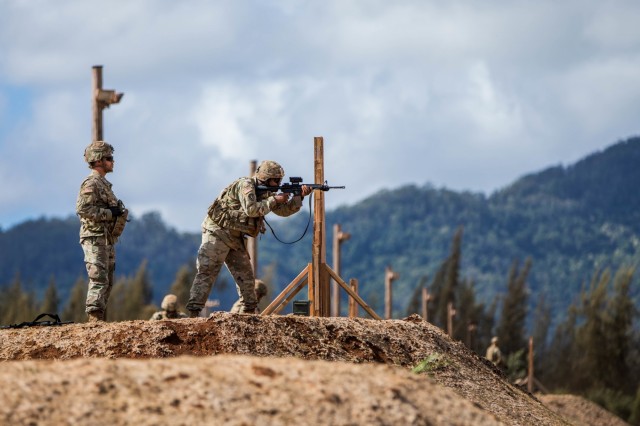
When the army announced that the drill sergeant “shark attack” was no longer allowed, talking heads to self-proclaimed pundits declared that the army was going soft in basic training, that it was now coddling trainees through basic training. Not true, but it continued because the army couldn’t get the national media to report what it was actually doing. Recently the add people hired by the army produced a video portraying a lesbian couple. It was withdrawn after it became laughingly ridiculed. I’m not sure I understand the intended message. Now human rights groups claim that the military is full of extremist groups and that military service itself is a leading factor in an individual joining an extremist group.
Before looking at basic training, lets look at drill sergeants.
Now, who are the drill sergeants. The infantry, engineer, supply, human resource, medic, dental assistant, computer specialist soldiers who receive that email from Human Resource Command that says; “Congratulations, you have been selected for a career enhancing assignment – to be a drill sergeant”. I went through Drill Sergeant School in 1979. It was six weeks of basically refreshing everything taught in basic training. And little tidbits like, “wear sunglasses so they can’t see where you are looking”.
Now at the 12-week Drill Sergeants Academy candidates not only go through basic training performing every task basic trainees complete, but spend a lot of time studying and practicing the “art” of “developmental training”. It is an art that everyone doesn’t naturally possess, therefore it must be studied and practiced. At the Drill Sergeant Academy, they call it training with dignity and respect. The Drill Sergeant school is physically demanding and intense. Candidates are arbitrarily pulled from formations to lead the event being conducted and everything including their physical mannerisms and the inflection of their voice is graded. I saw a comment that the drill sergeant class in April 2023 of 106 candidates, 99 graduated.
Personal attacks and abuse turns people off. How about some examples of the old days. Drill Sergeant; “How tall are you Jones? Five nine sergeant. Five nine? I didn’t know they stacked shit that high Jones. Did your momma have any kids that lived? Get down and push up until I get tired. Now do you understand what I want?” There is only one answer, whether understood or not, plus trainee Jones won’t ask anymore questions because they only bring pain.
The drill sergeant “shark attack” was created during the Vietnam War when most of the trainees were draftees and would literally fight a sergeant to get out of the army. The majority of those conscripted recruits considered themselves one step away from prisoners who would literally fight the drill sergeants to get out of there. They had to be defeated and controlled from the minute they arrived. It was, at that time, necessary and it was effective. Once they accepted their situation training could begin.
Basic trainees now are smart, healthy volunteers who have jumped through some hoops to get into the army. I walked into an army recruiters office in August 1961 and signed up. The next morning I was on the bus to MEPS (Military Enlistment Processing Station). Army recruiters tell me know that it takes a minimum of about a month to get an enlistee to MEPS. They have background checks, medical records checks, mental and physical tests. If they have ever taken medication, been in the hospital or had a broken bone, a medical waiver is required, which takes even longer, if they are admitted.
Basic trainees are now smart young people and they are being fed a tremendous amount of information in a short period of time. Questions are welcomed. The only dumb question is the question not asked now applies in army basic training. The discipline is created by the professional conduct of the drill sergeants and the training unit staff. It is an atmosphere of discipline within the unit. Drill sergeants still yell because they are directing crowds of people, not because they are trying to weed out the week. The drill sergeant’s job is to turn civilians into soldiers – all of them if possible.
This past November 2022, Alex Hollings a marine vet journalist wrote a very in-depth article for Sandboxx titled, “DIGNITY AND RESPECT: AN EXCLUSIVE LOOK AT HOW THE ARMY IS TRAINING DRILL SERGEANTS FOR A NEW ERA”. He admits that when approaching that task, he had a definite old marine bias that the army was going soft and woke, but after spending a week at the academy he became a convert that this new approach is the way to go.
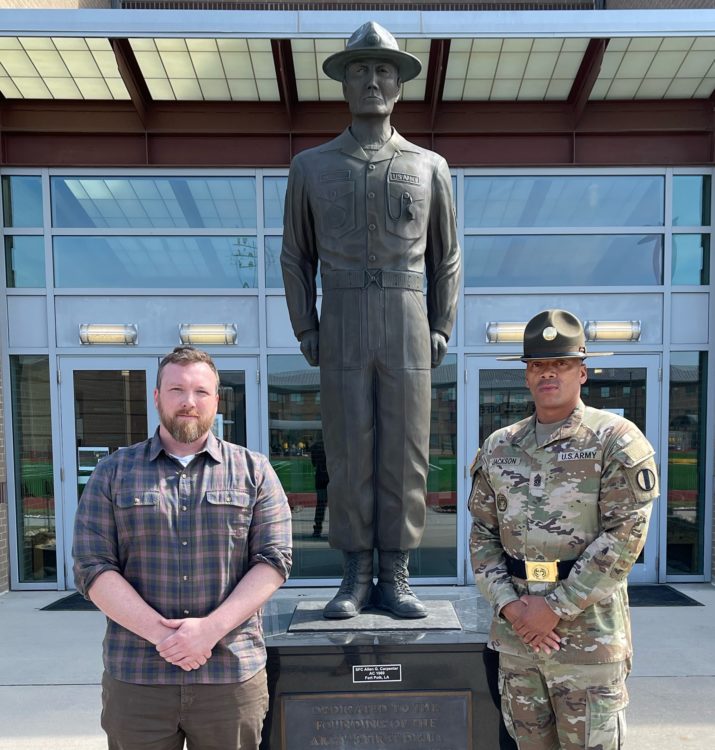
Alex Hollings and Command Sergeant Major (CSM) Ricky G. Jackson the Commandant of the US Army Drill Sergeant Academy. Out of uniform CSM Jackson can honestly be called Doctor Jackson, because he has a PhD in Behavioral Health Management.

The following video is 15 minutes long. It is directed at army sergeants who may become drill sergeant candidates. In it you will see CSM Jackson telling a class of candidates that if they need to use the language I used in the above paragraph, to get someone to do something, they are no longer relevant in today’s army.
Army Basic Combat Training (BCT) is conducted at Fort Jackson, South Carolina, Fort Leonard Wood, Missouri, Fort Moore (formerly Fort Benning), Georgia, and Fort Sill, Oklahoma. All basic training units have facebook pages and are very open about keeping families posted on what their soldiers are doing, during basic training. At Forts Leonard Wood, Moore, and Sill basic training companies graduate individually, at Fort Jackson basic training cycles are run by battalions and all companies in the battalion graduate together. I chose to follow one battalion at Fort Jackson, because they do a very good job of maintaining their facebook page. The 2nd Battalion and the 4th Battalion of the 39th Infantry are very similar with their postings,
Day one: Arrival at the company.
Drill sergeants meet each bus. Exit bus without gear – go there for a formation.

Drill sergeant yelling. Get off bus go there and form up.
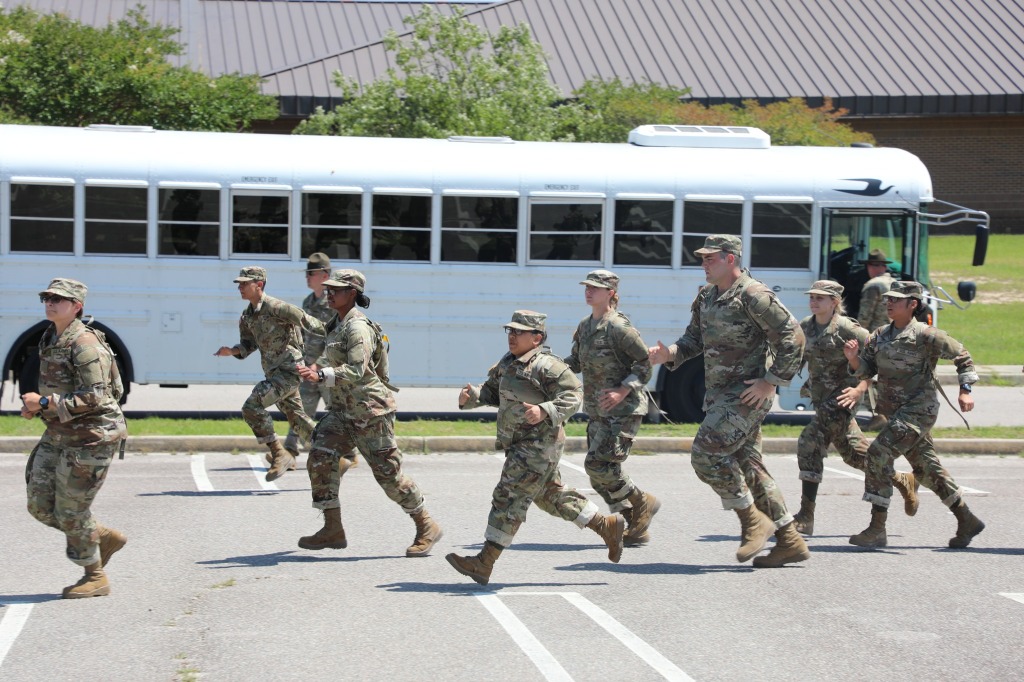
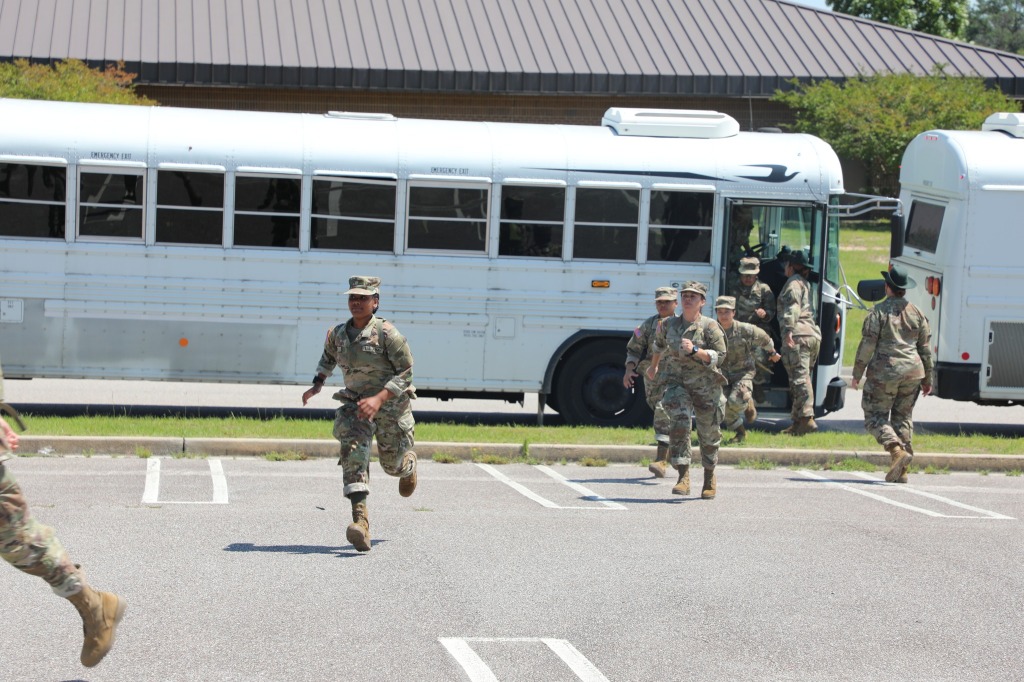
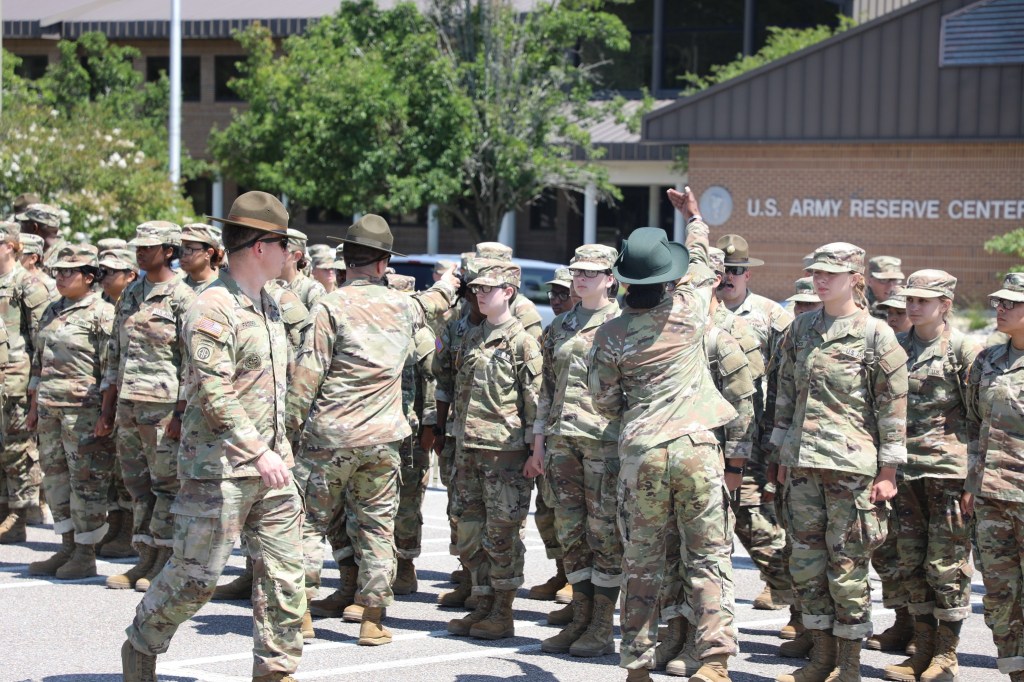
Drill sergeants form them into platoons of 40 to 50 each.
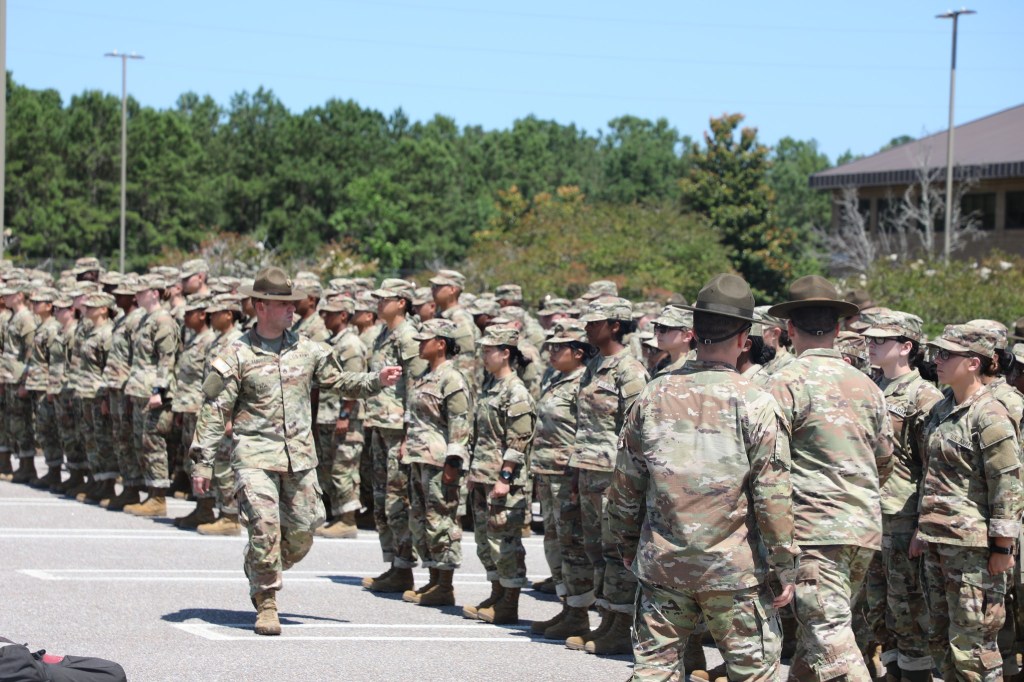
The company is then formed and briefed on what they will be doing for the next 90 minutes in an exercise called “The First 100 Yards”.
They were issued a small “Training Guide” while they were still at the reception center. They will be quizzed on its information. They will have to conduct a “resupply mission” which consists of moving the pile of stuff in front of the platoon to an out of sight location. They will be shown how to do three exercises of the Army Combat Fitness Test (ACFT), which they will be required to perform. They will then have to go back and arrange the supplies they moved into the exact original configuration. Finally they will be shown a demonstration of what they will be able to do, as a unit, at the end of basic combat training.
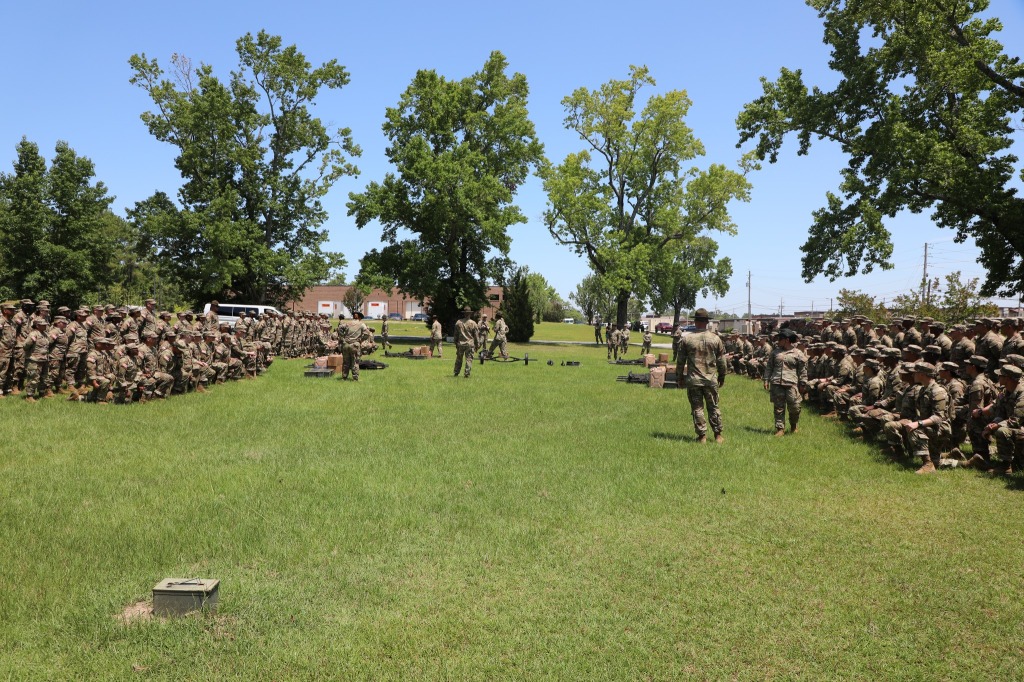
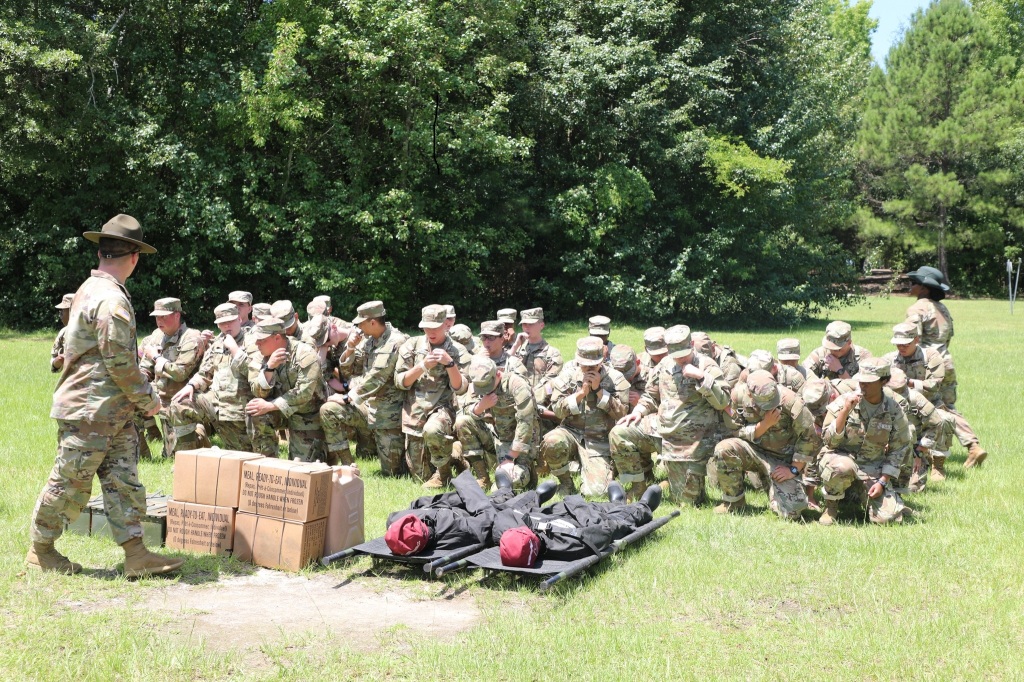
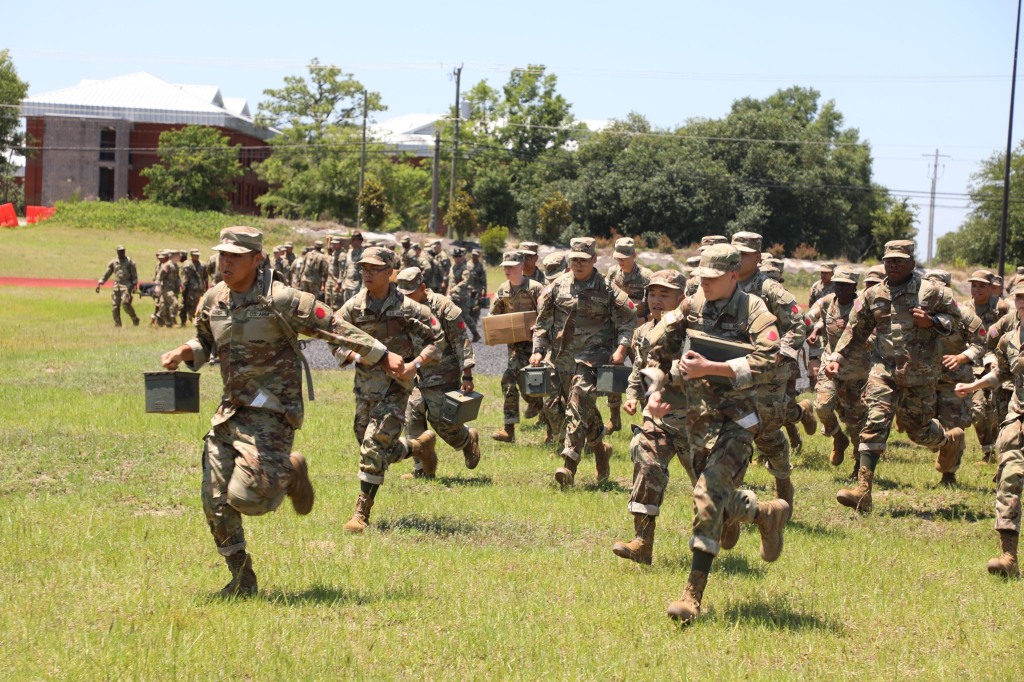
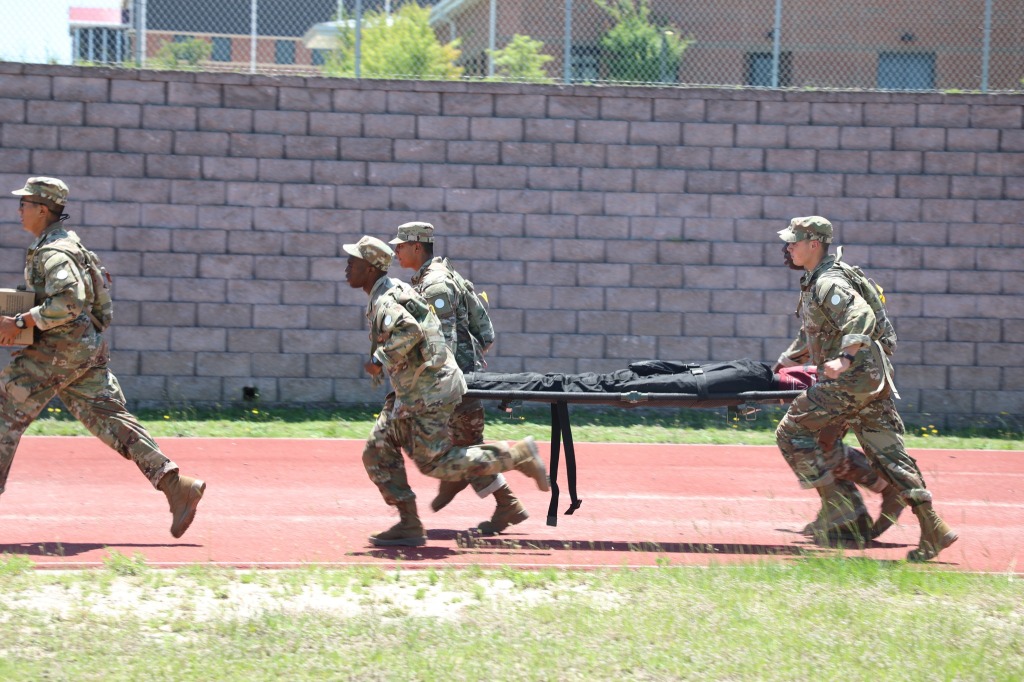
They have to work together, as a platoon. After the ACFT exercises they go back to their stacked supplies and arrange them in the exact original order.
The winning platoon departs first to get their bags and get set up in the barracks, all others have remedial training (pushups). There is only one winner and winning is everything.
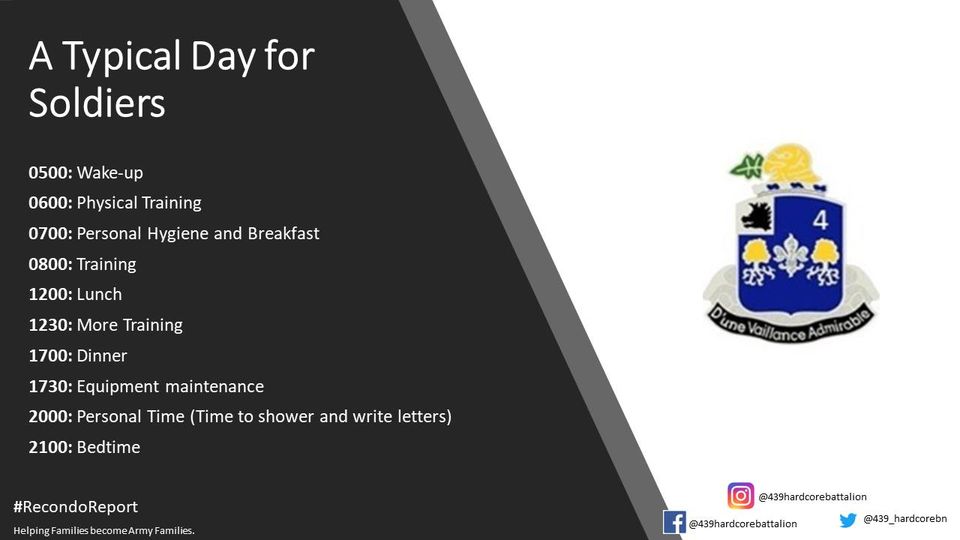
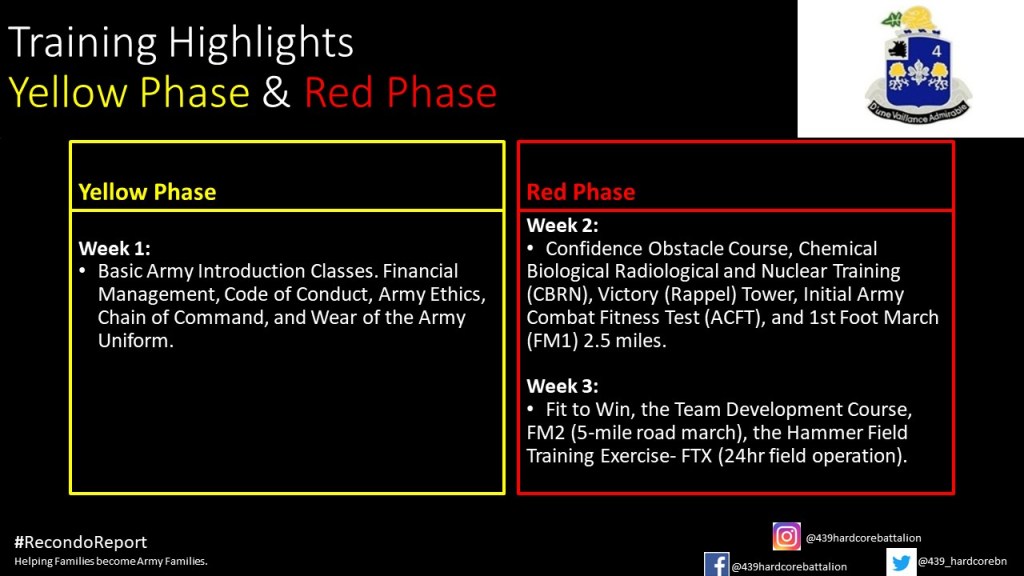
The first week they draw field equipment which they will have to clean and turn in at the end of basic training. There are several sit-down classes, and lots of marching, facing movements, hand salute, etc.
Early in their first week they had their diagnostic ACFT (Army Combat Fitness Test) to see where they were physically.
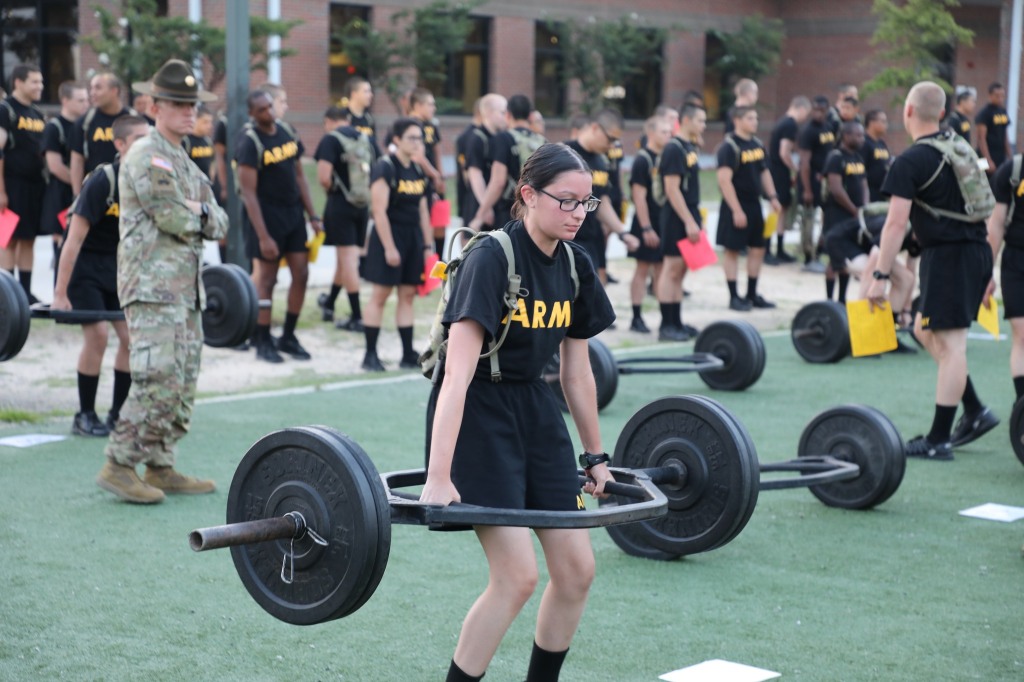
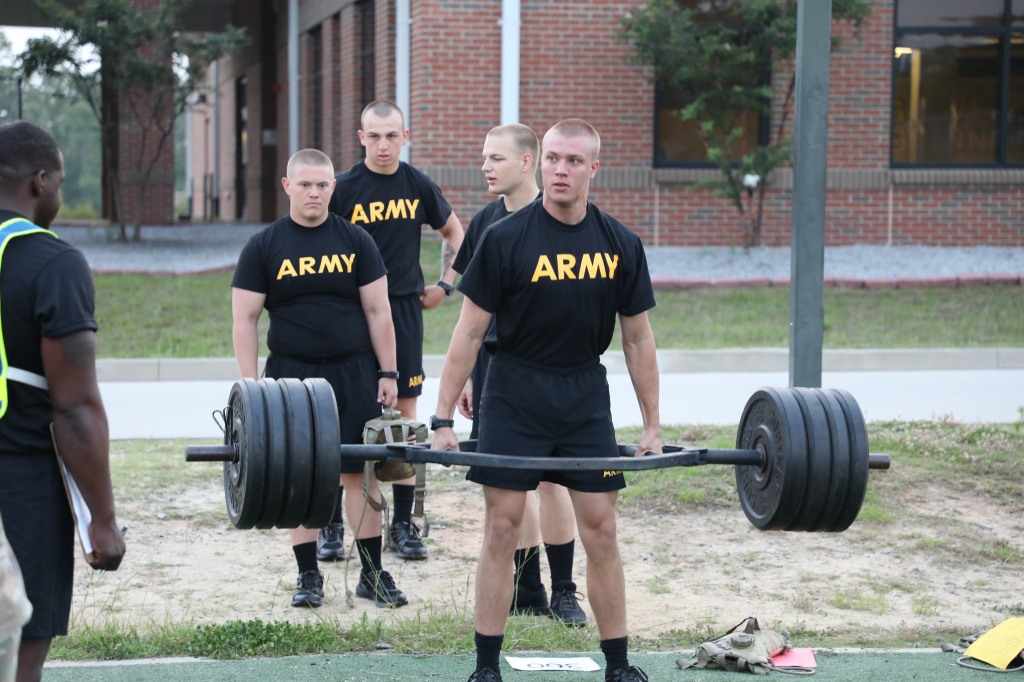
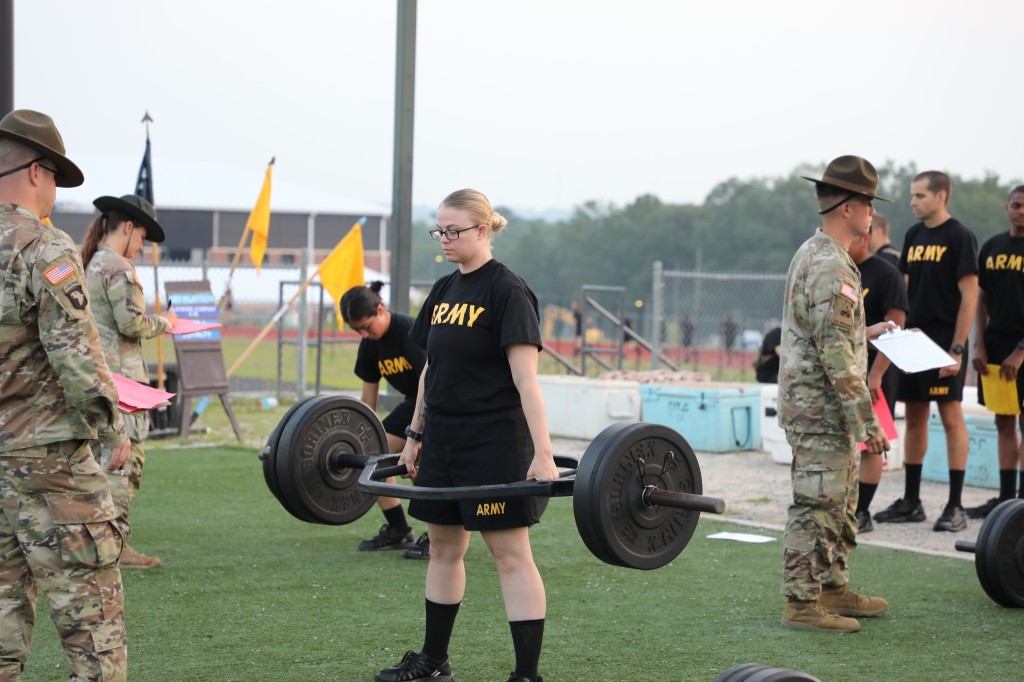


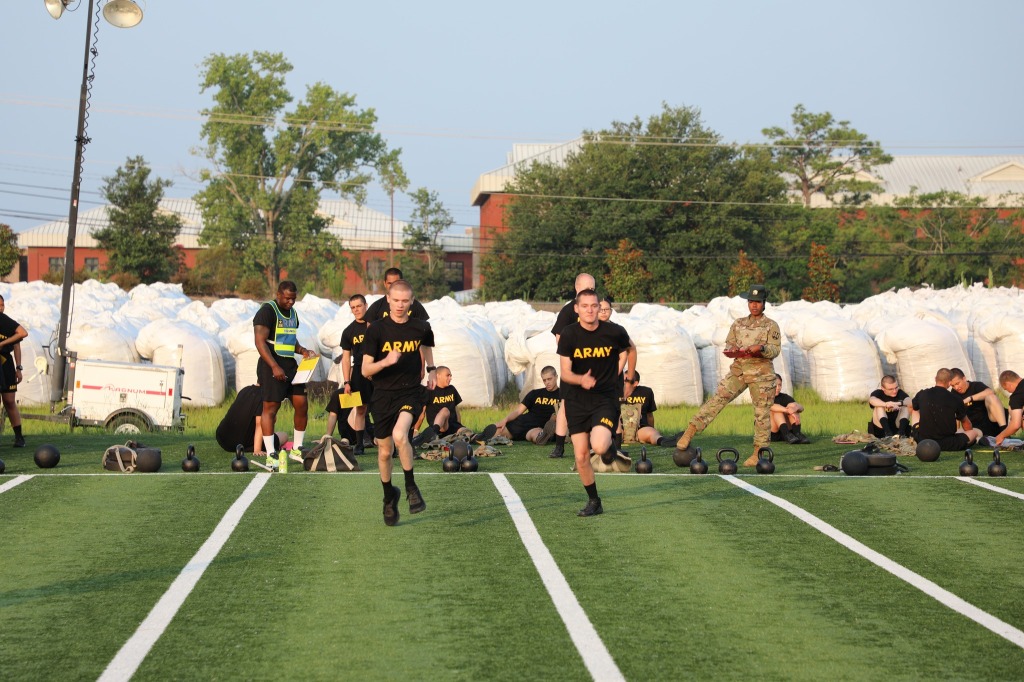

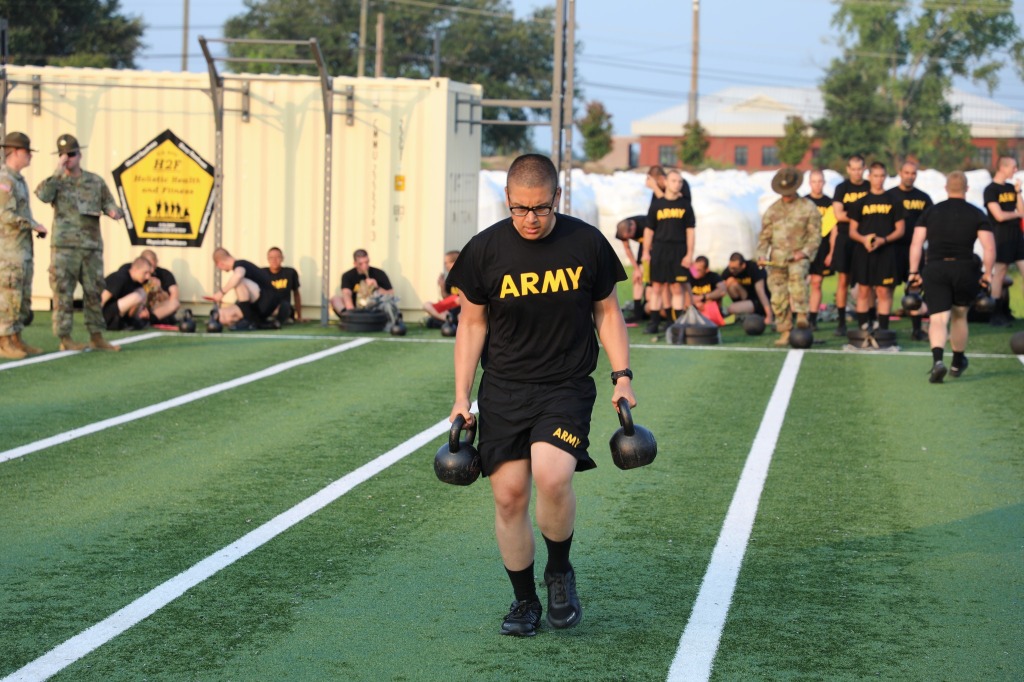
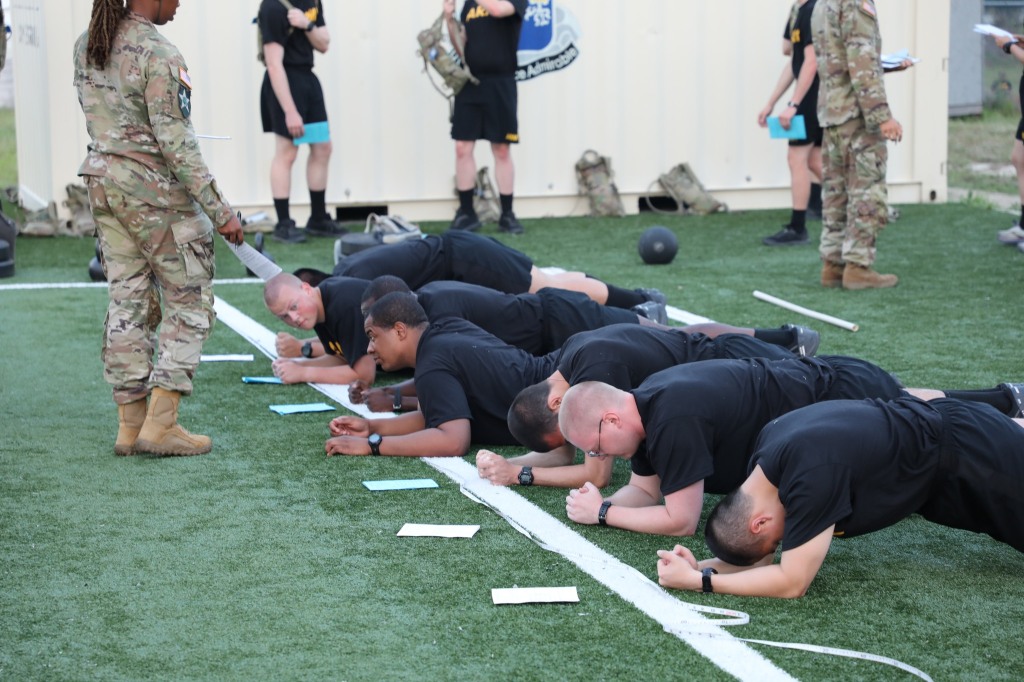
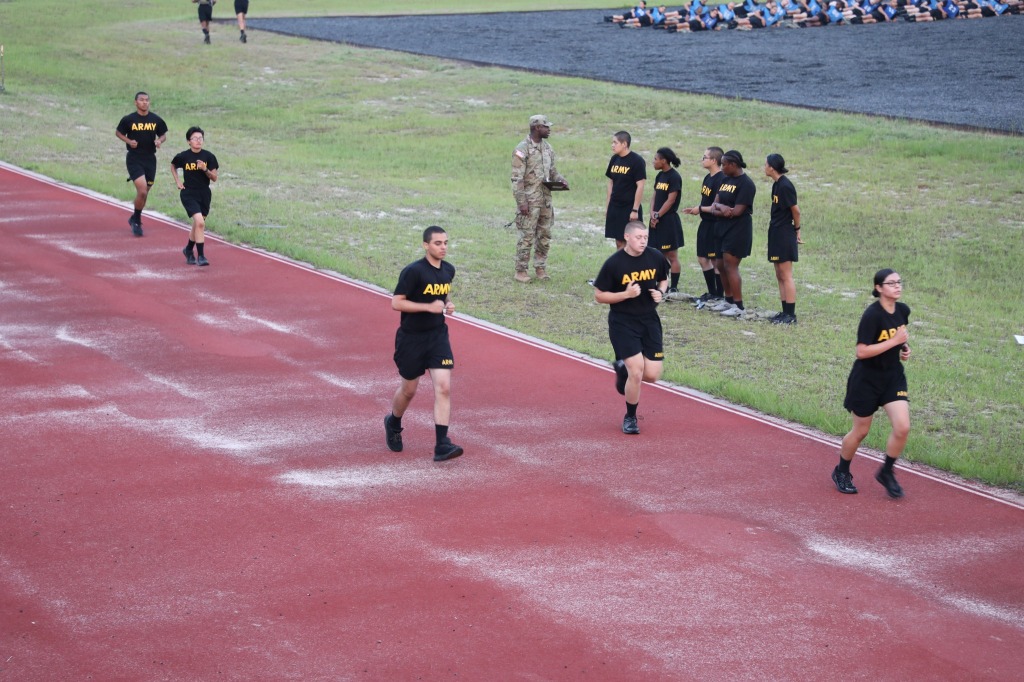
Although the master training schedule says week three, they try to get the confidence course in the second week, because it is a confidence builder. The trainees do have to work together to make it through.

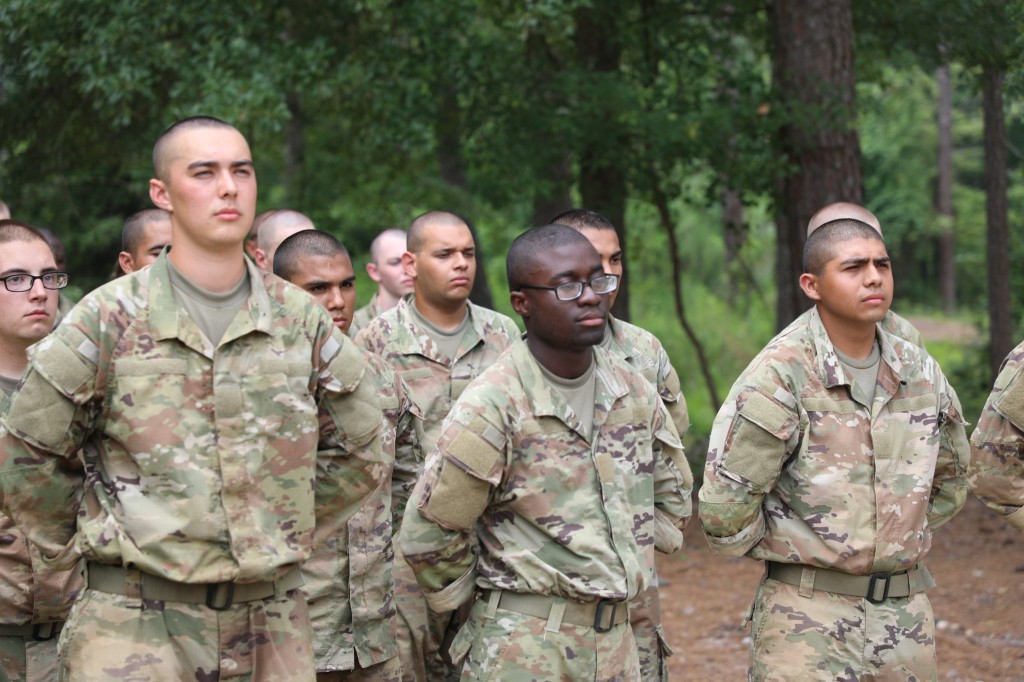
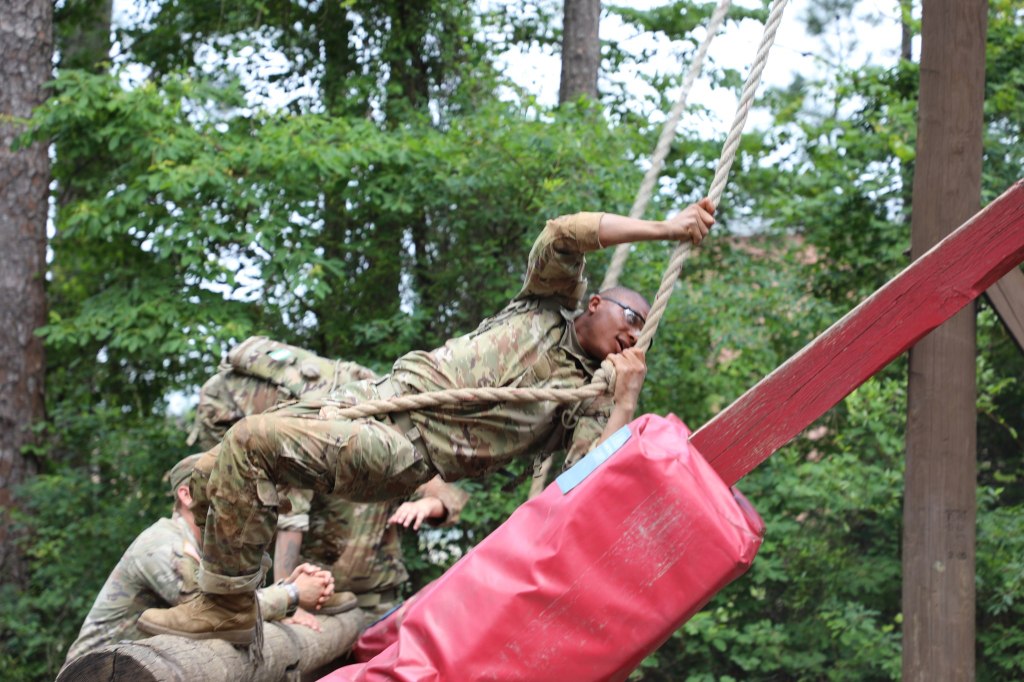
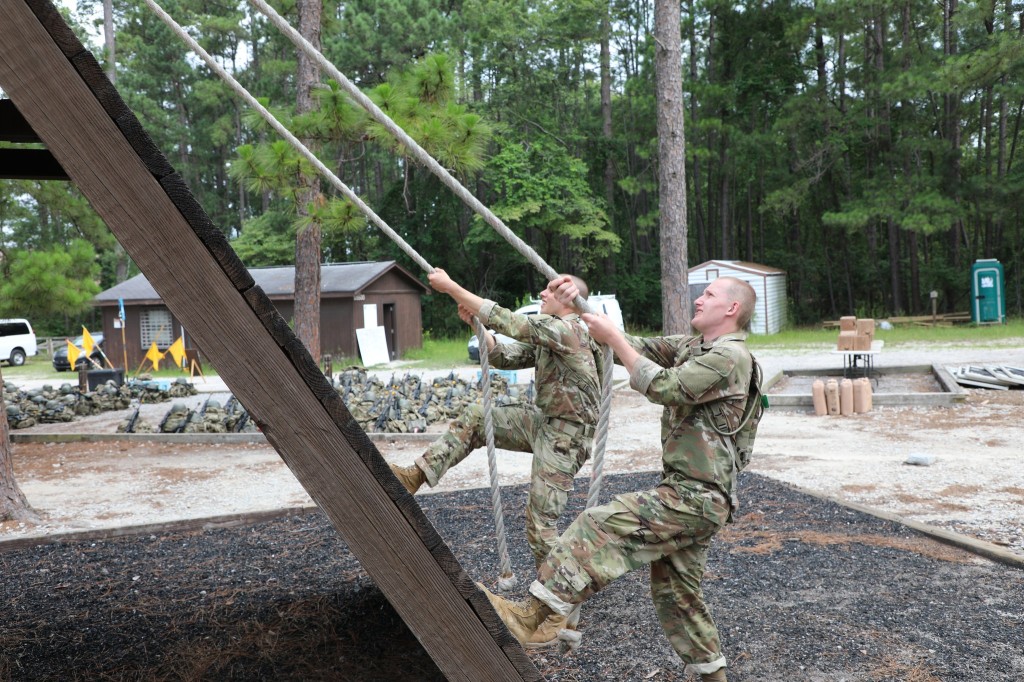
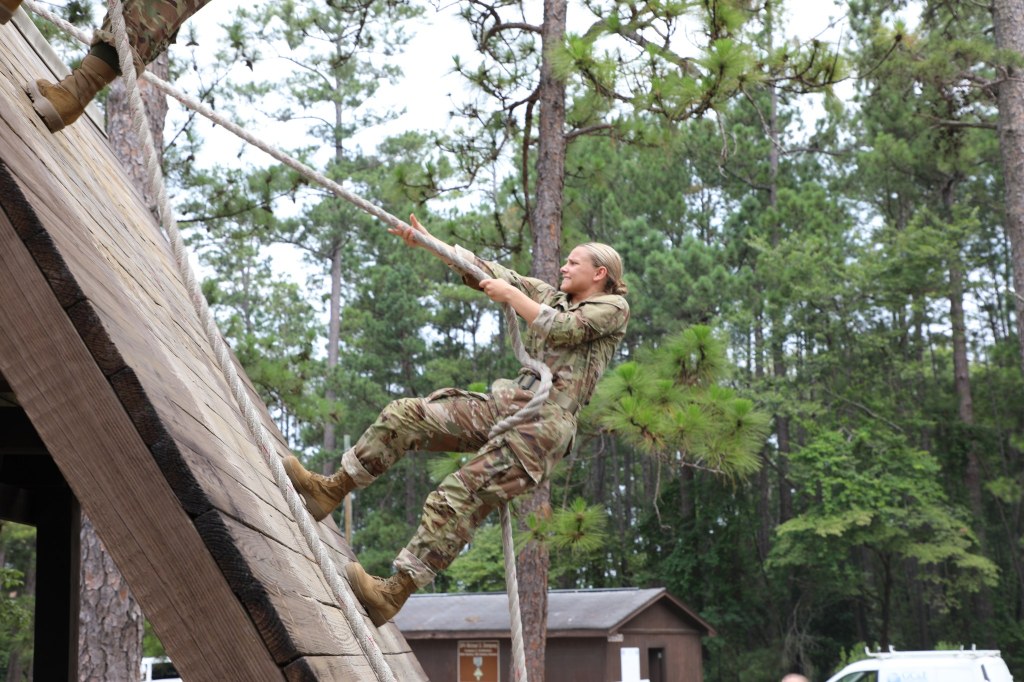
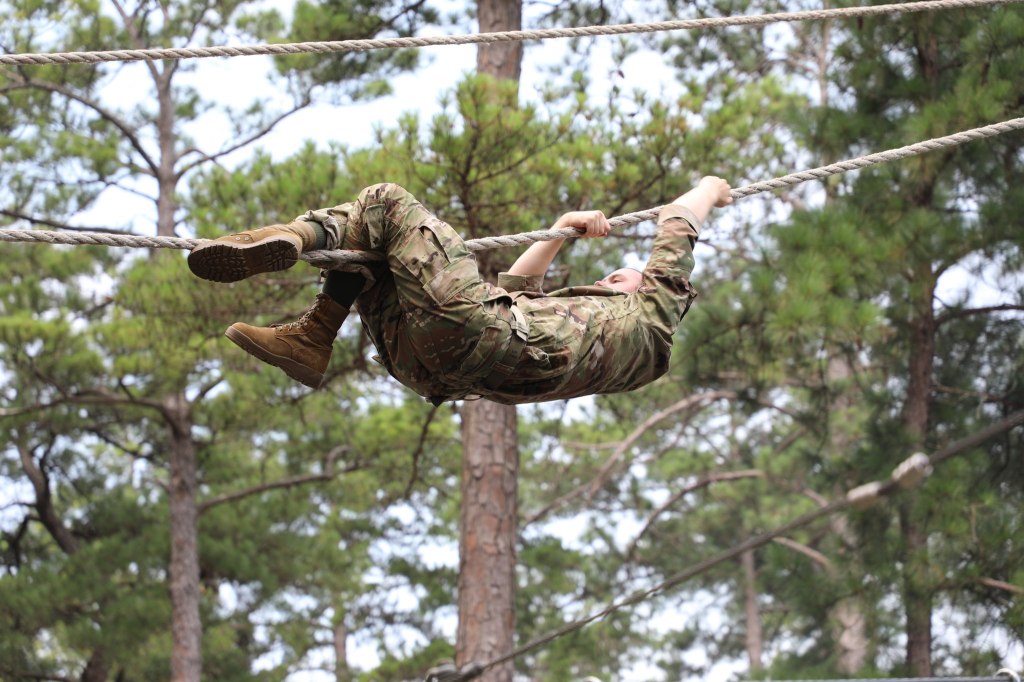
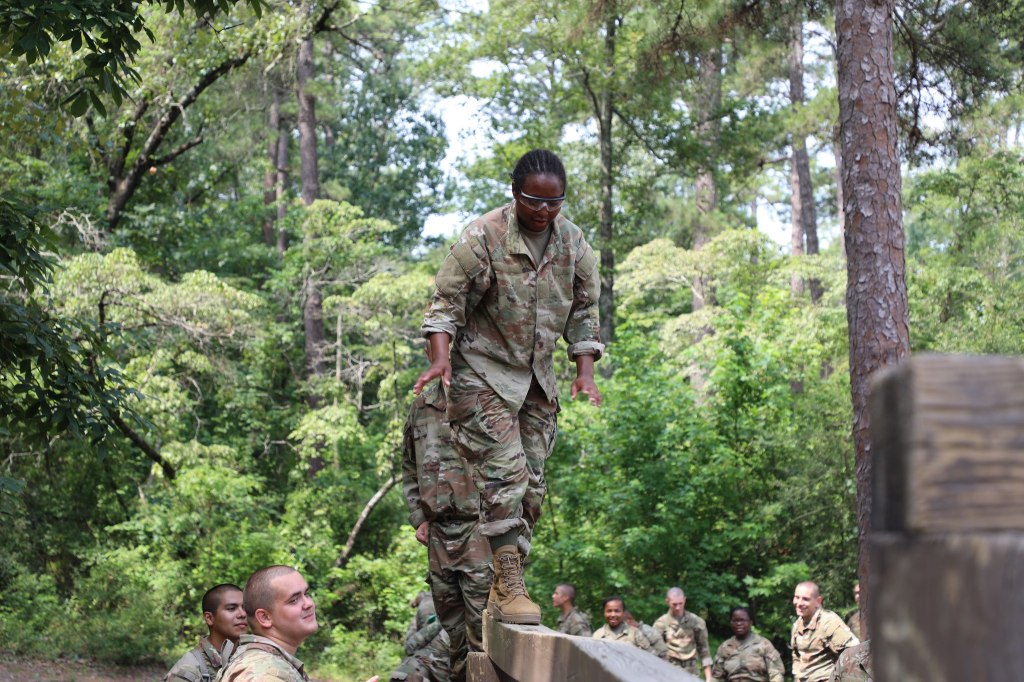
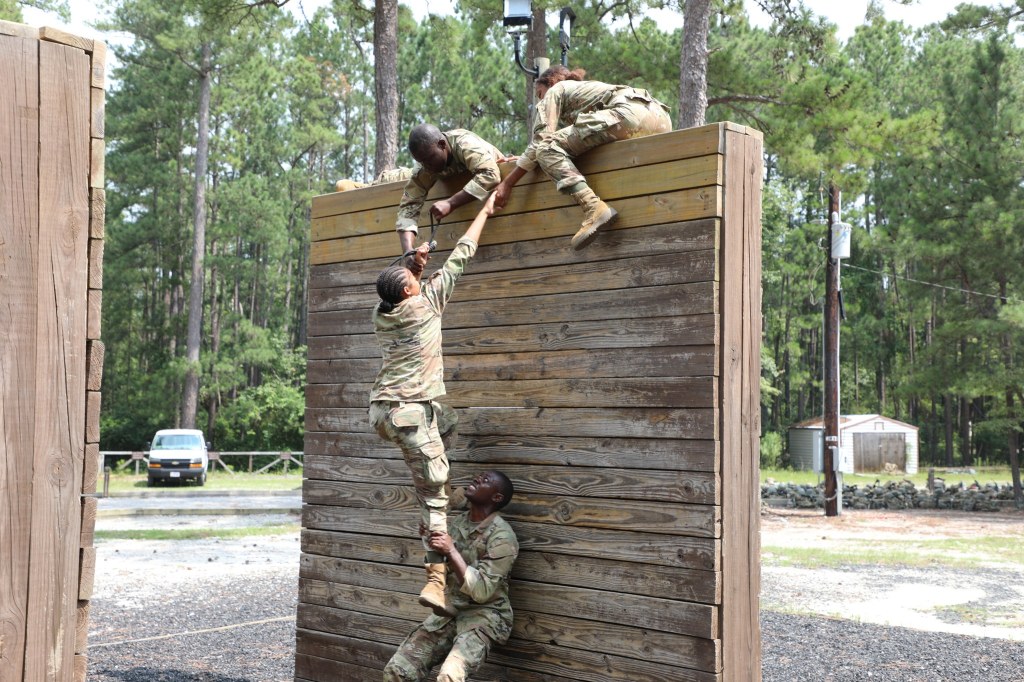
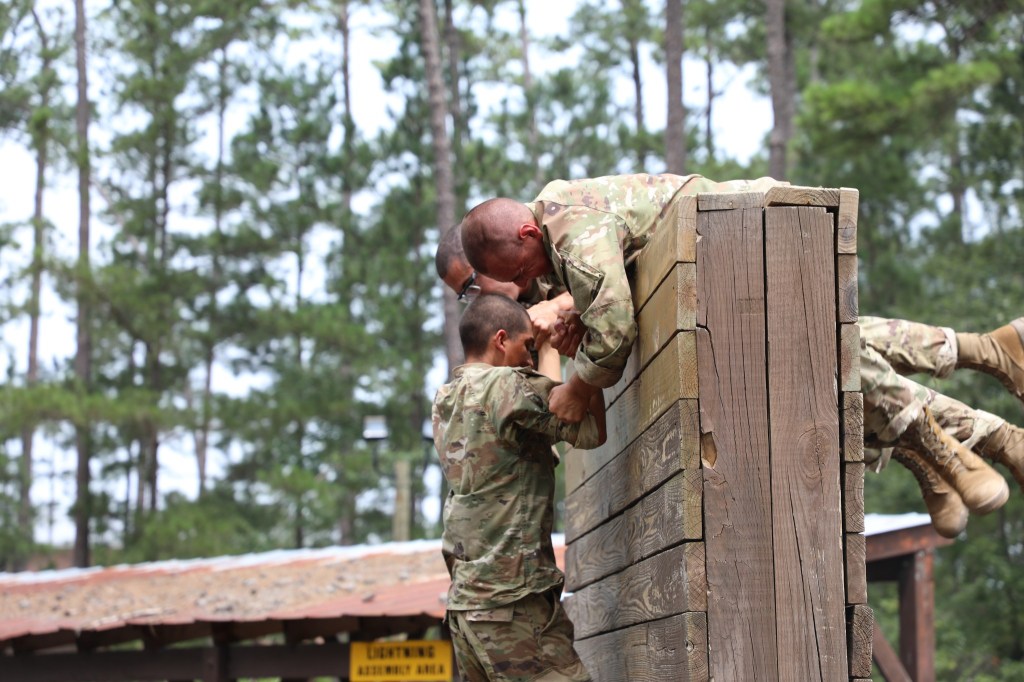

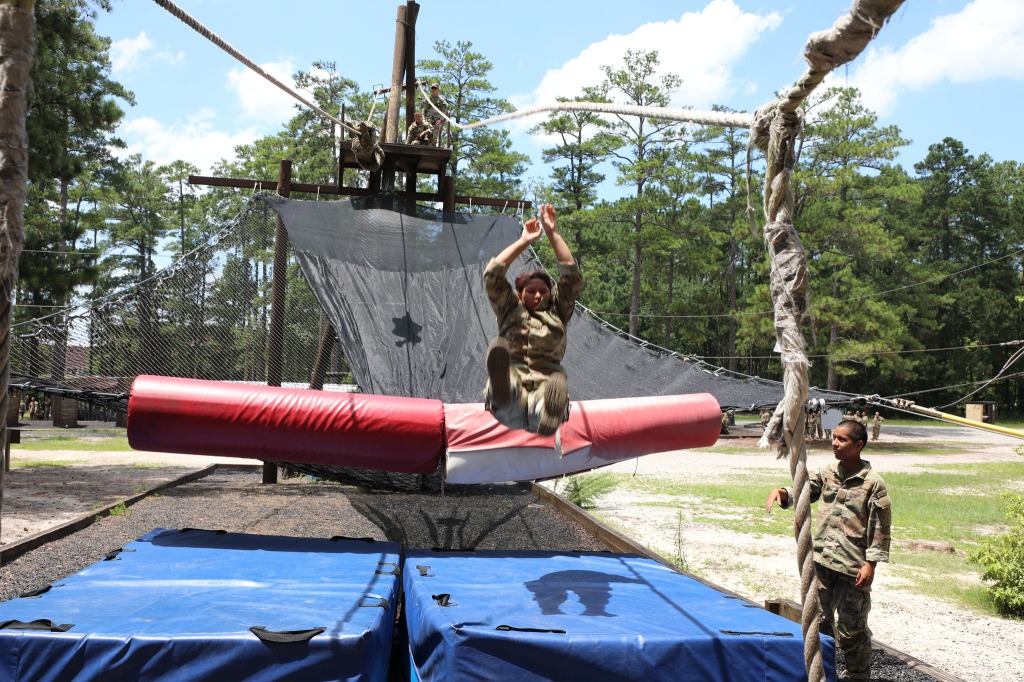
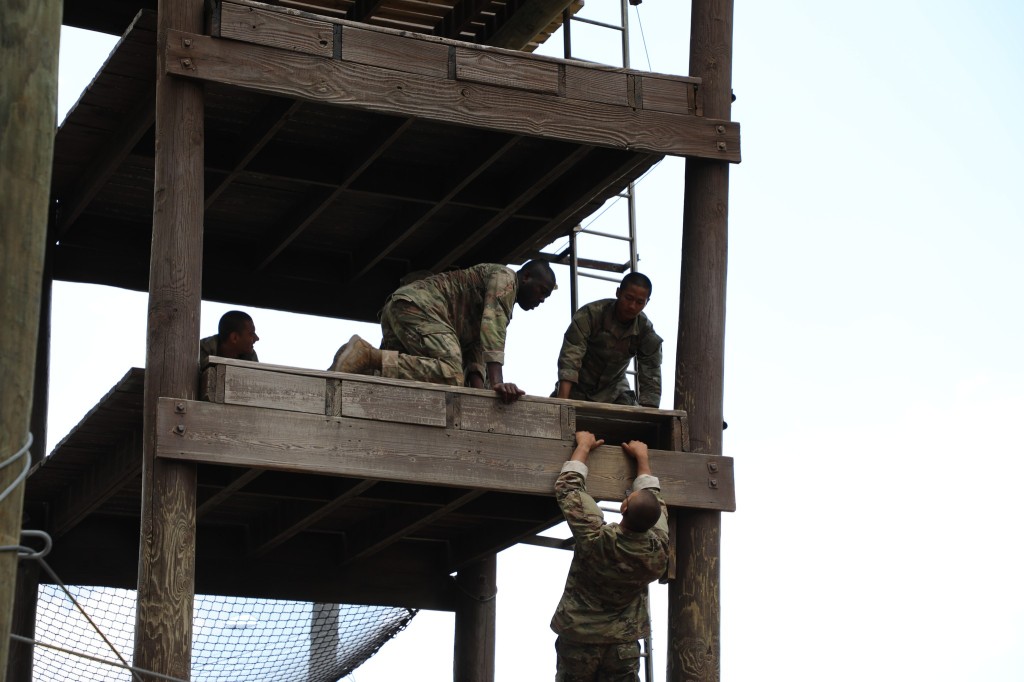
The next confidence builder in the second or early third week is Victory Tower. Victory Tower (Warrior Tower at Fort Leonard Wood) is a 40 foot high rappel tower. It has a flat wall on one side and open with a rope net on the other side. There are also one, two, and three rope traverses.
The “Mini Wall” is an addition since I was a drill sergeant there in 1980. I do understand why it was added. In my first basic training cycle as the senior drill of the company there were 4 or 5 young men who refused to go off of the tower. They were absolutely afraid of it. After that, I would give the company a class on the swiss rappel seat while the other drill sergeants took the two smallest female trainees to the tower and got them off of the tower a couple times. Then, I would bring the company to the tower and those two small women would demonstrate how to properly rappel off of the tower. I never had another refusal.
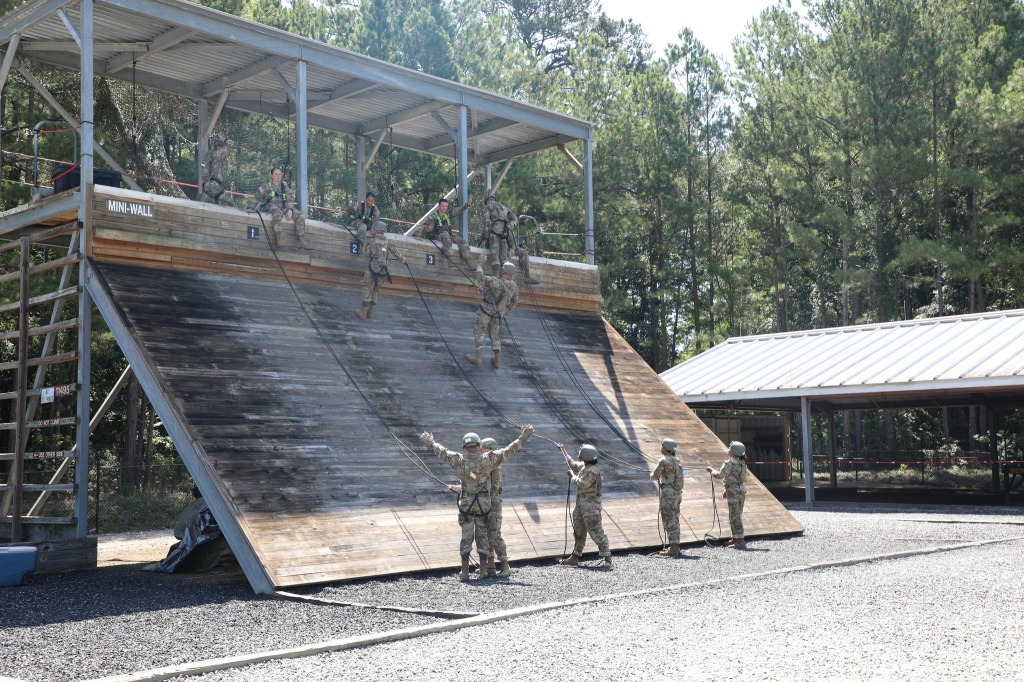
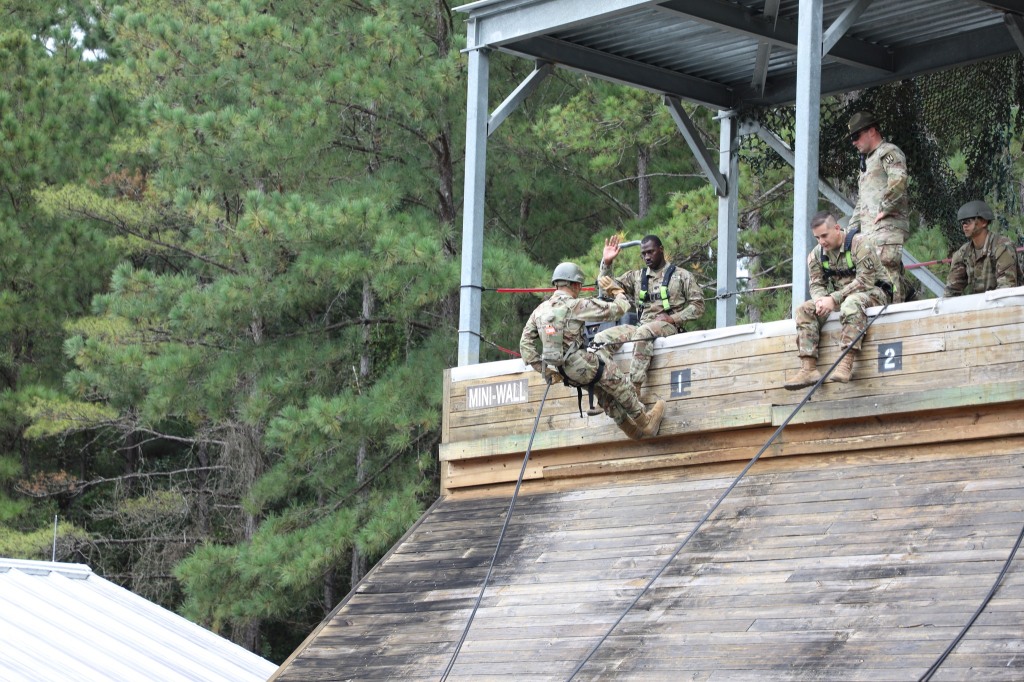
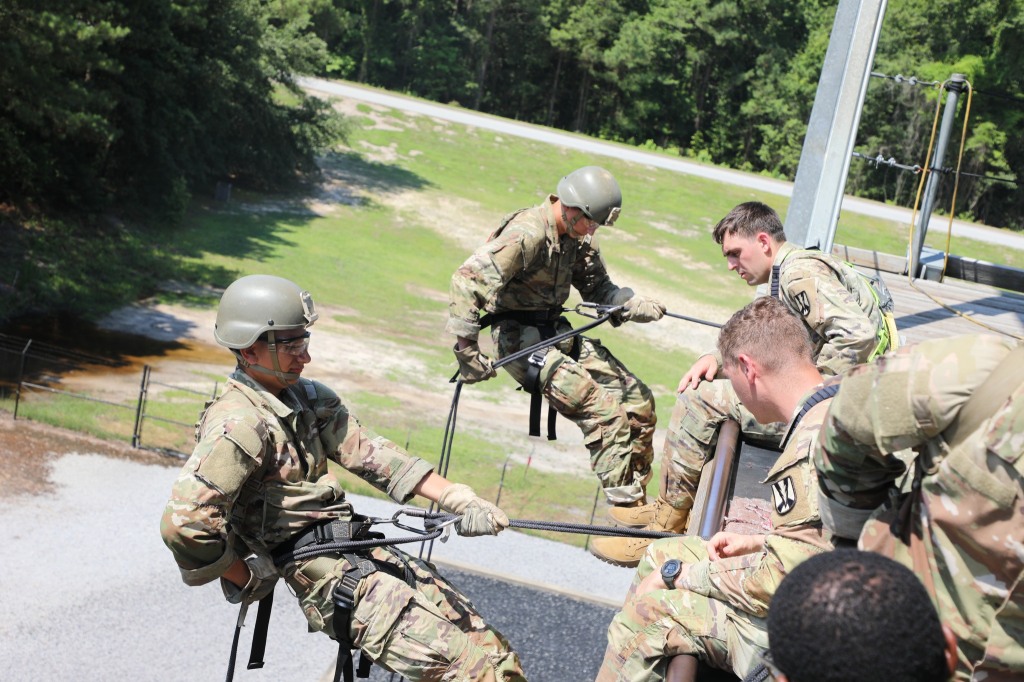
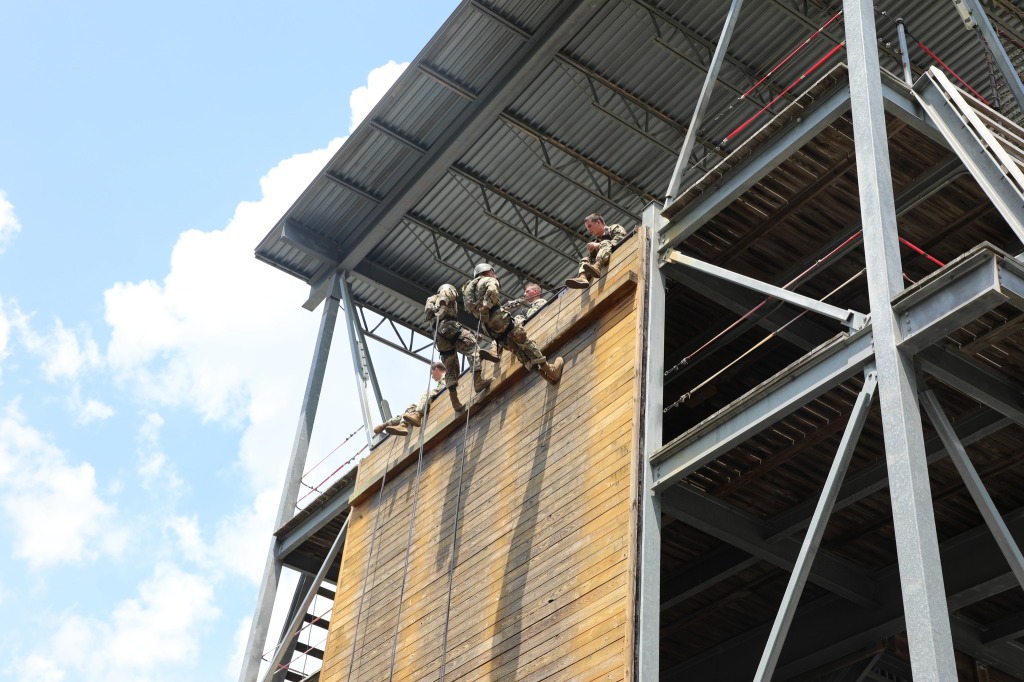
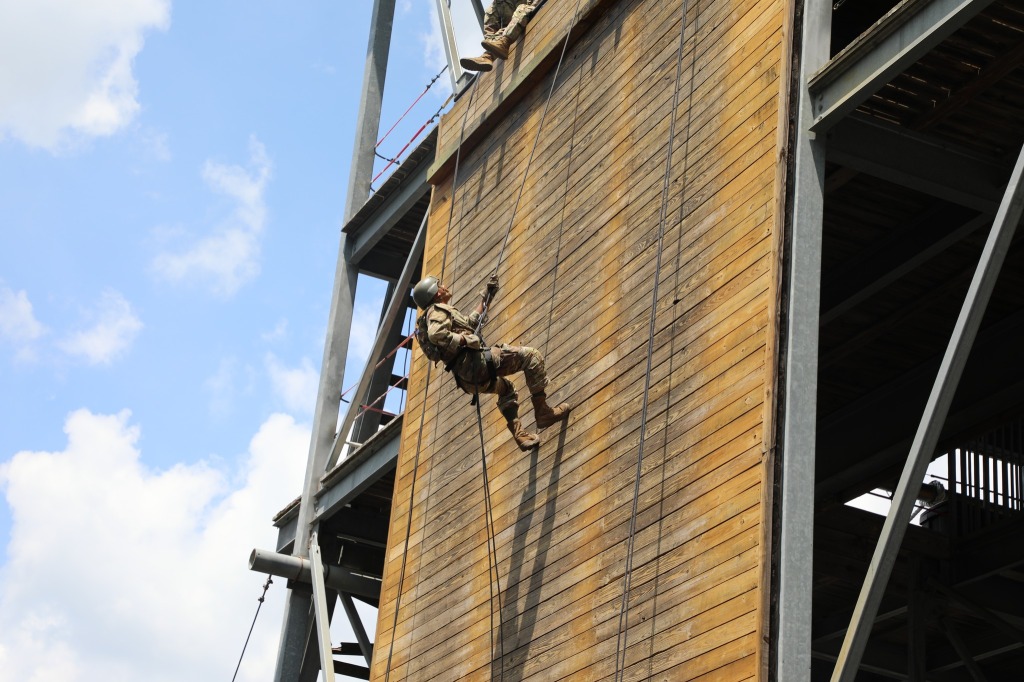
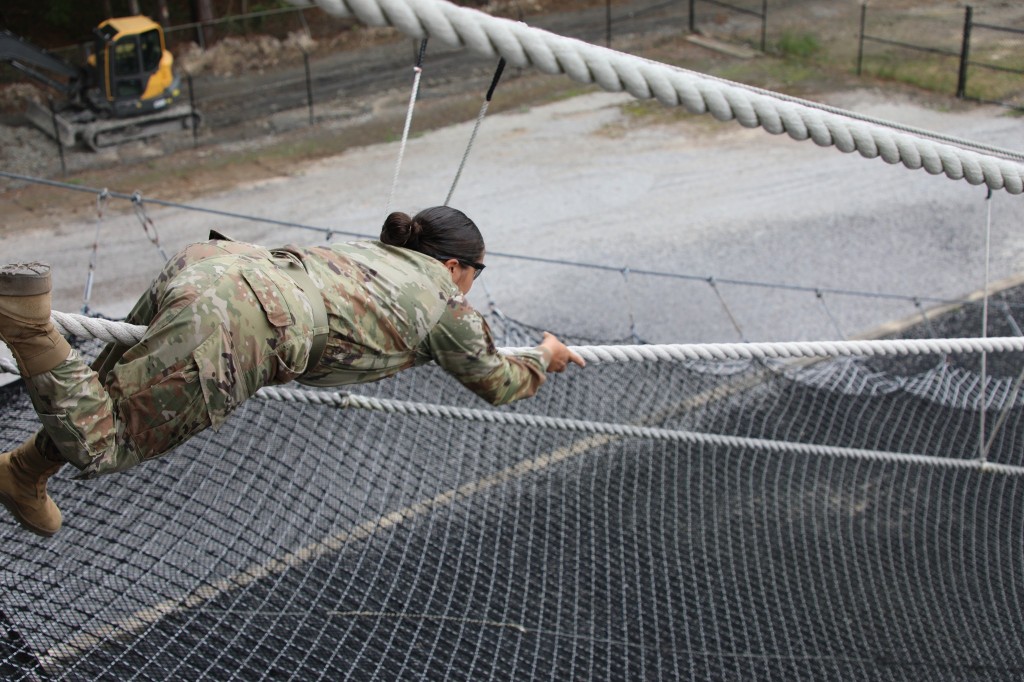
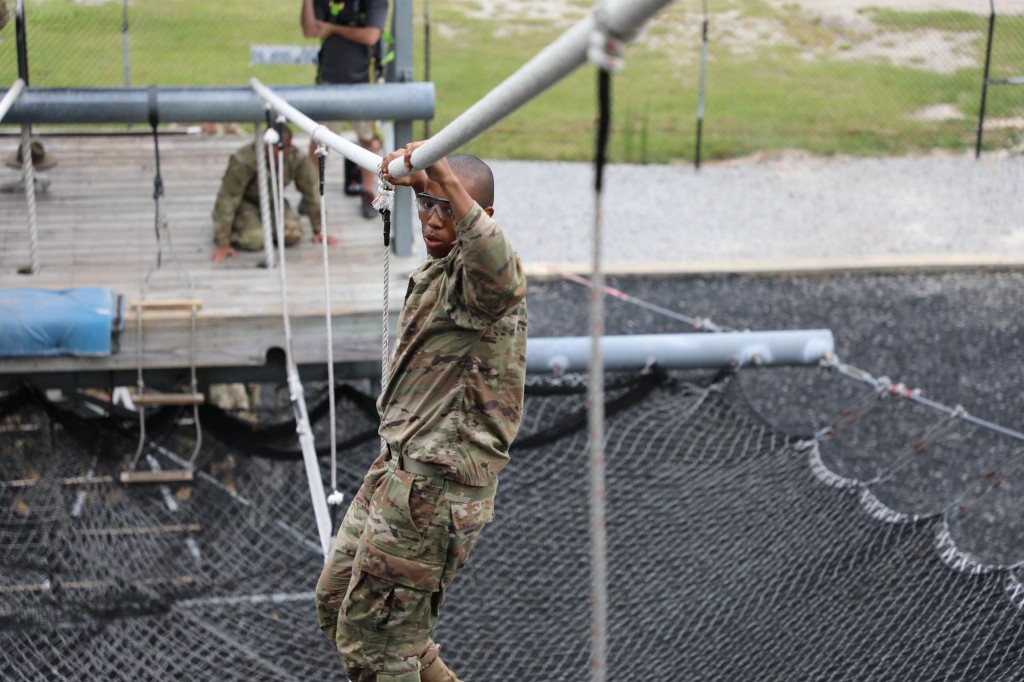
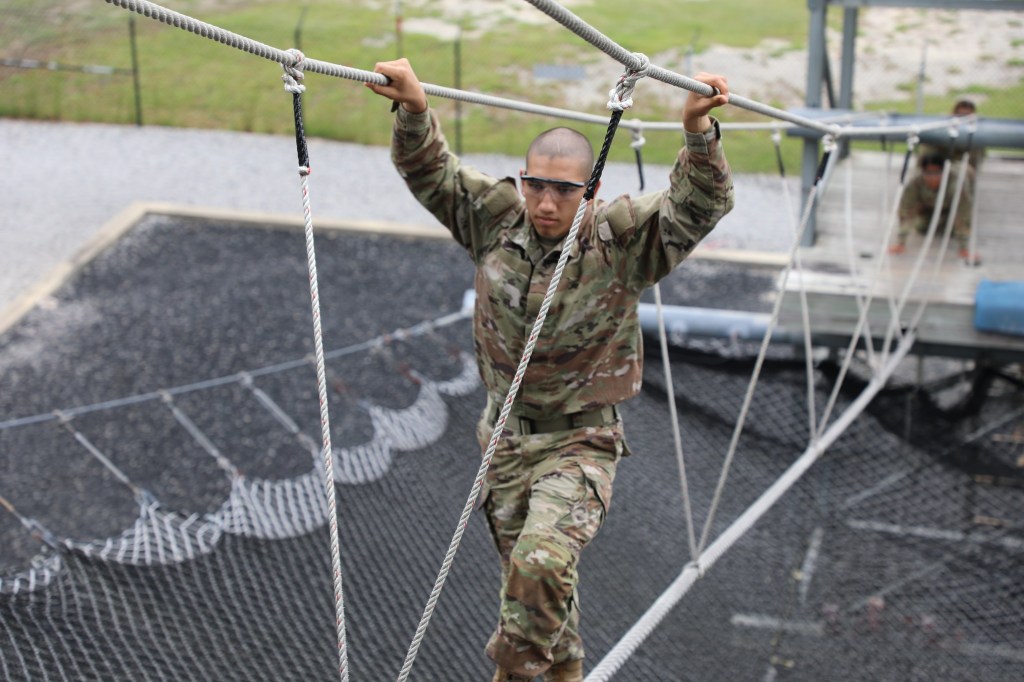
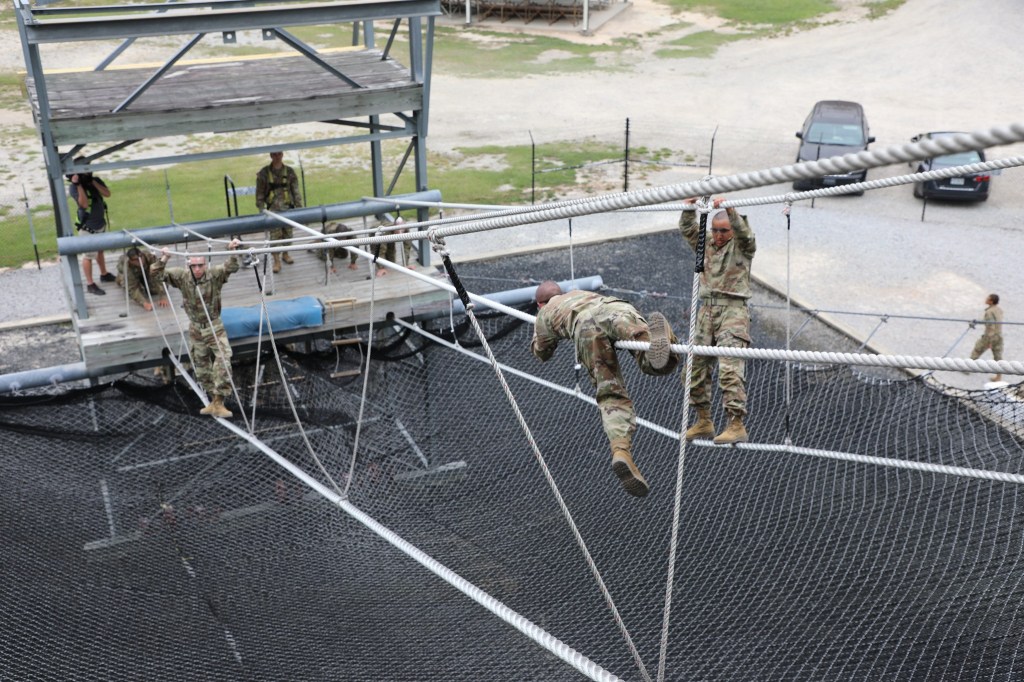
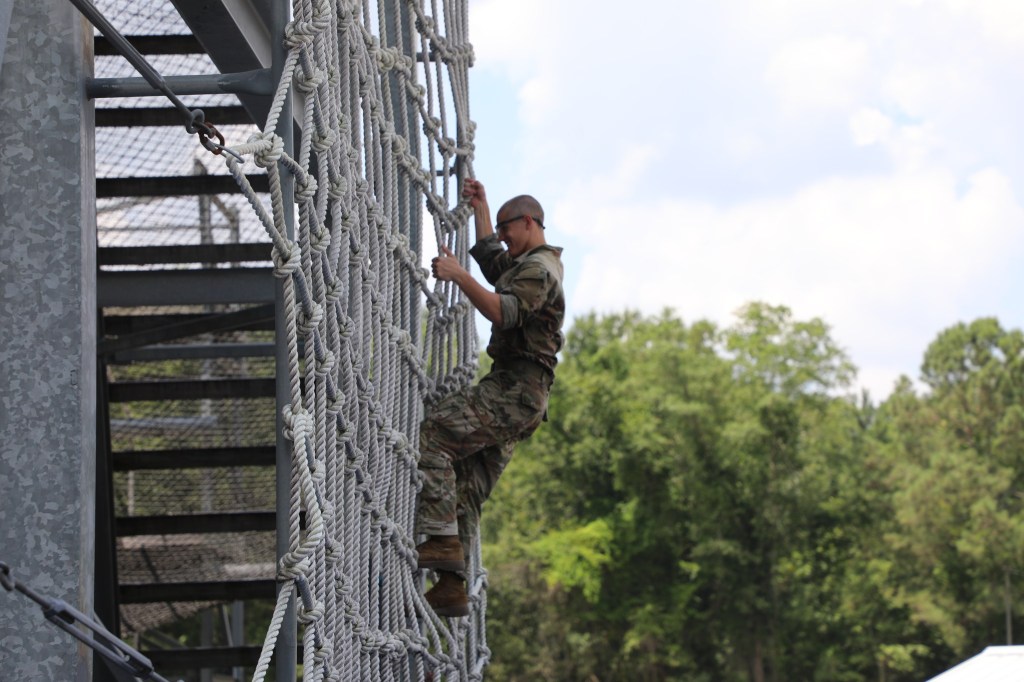
Also in the third week is CBRN (Chemical Biological Radiological and Nuclear) training. In other words, the “gas chamber”. This is an annual exercise that all soldiers do once each year. It is to create confidence in the gas (protective) mask. Soldiers put their mask on and insure that it is properly fitted. They enter the gas chamber, which has a good dose of CS (riot tear) gas burning. Then on command they remove their mask and state their name, number and date of birth, or anything to insure that they get a breath of the gas.
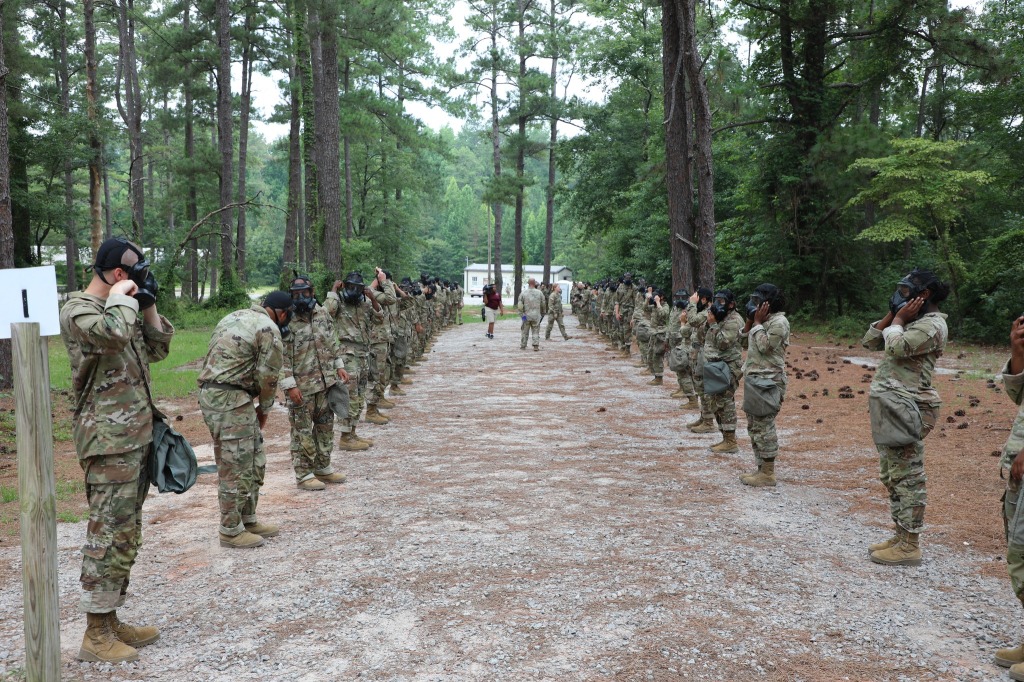
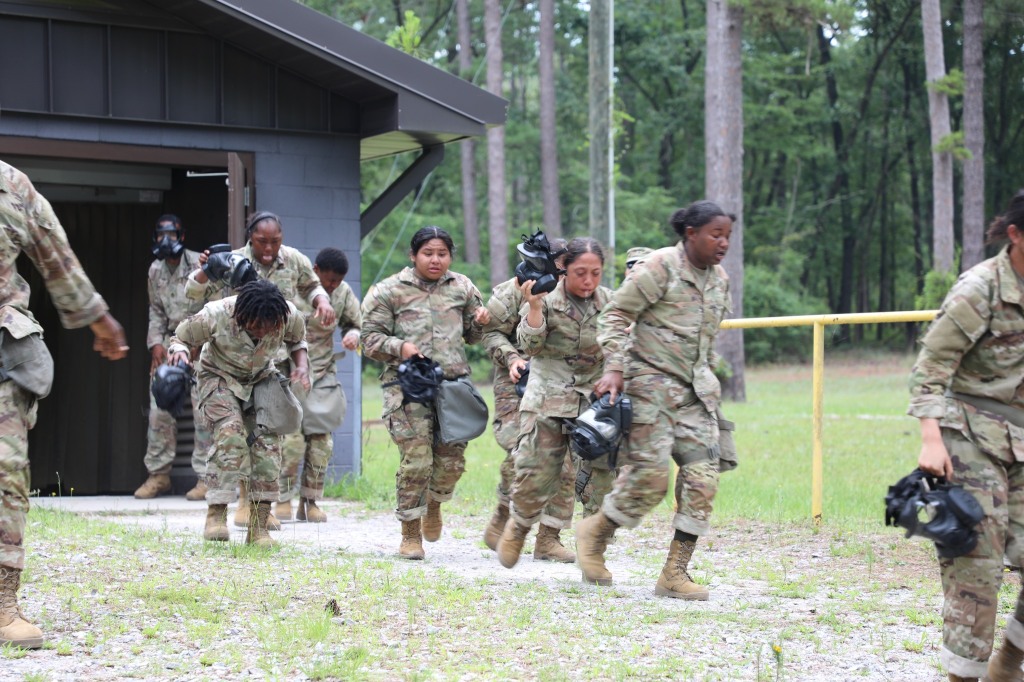
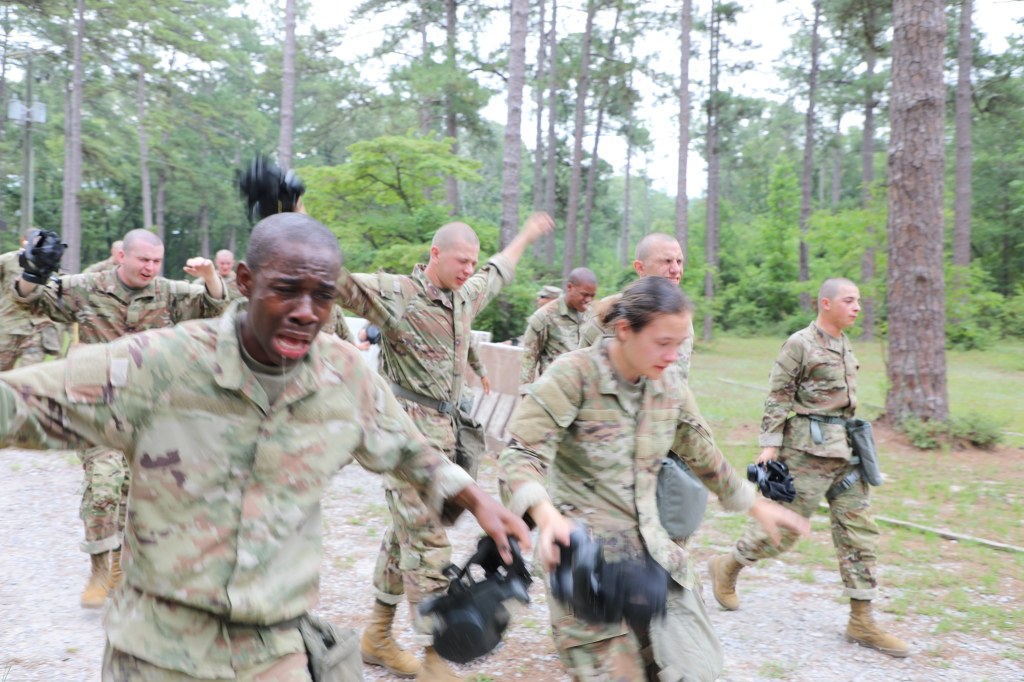
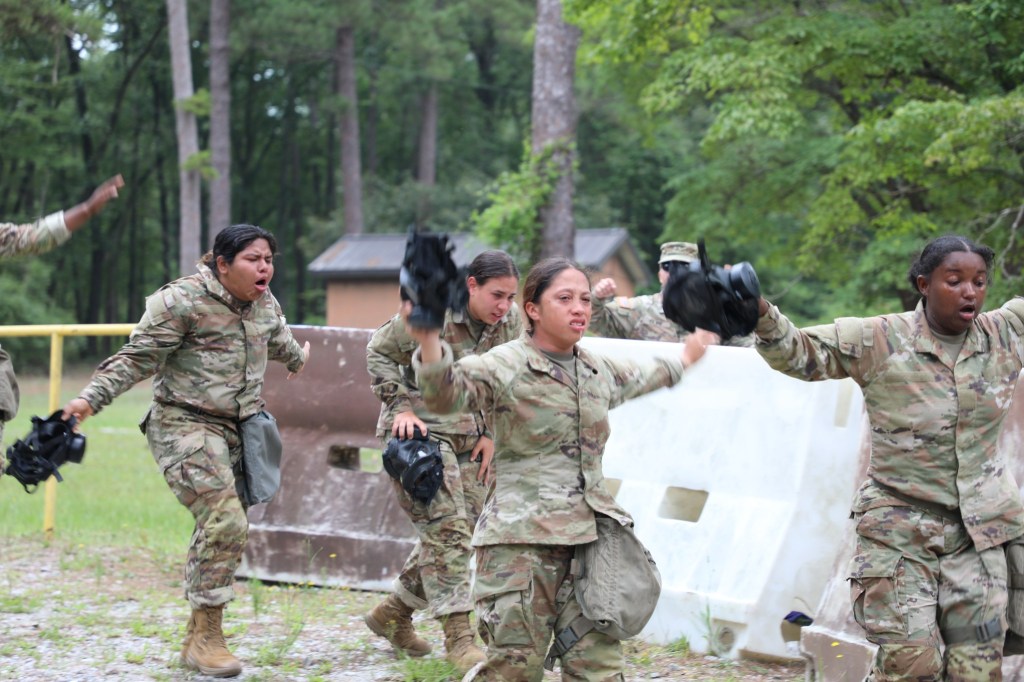
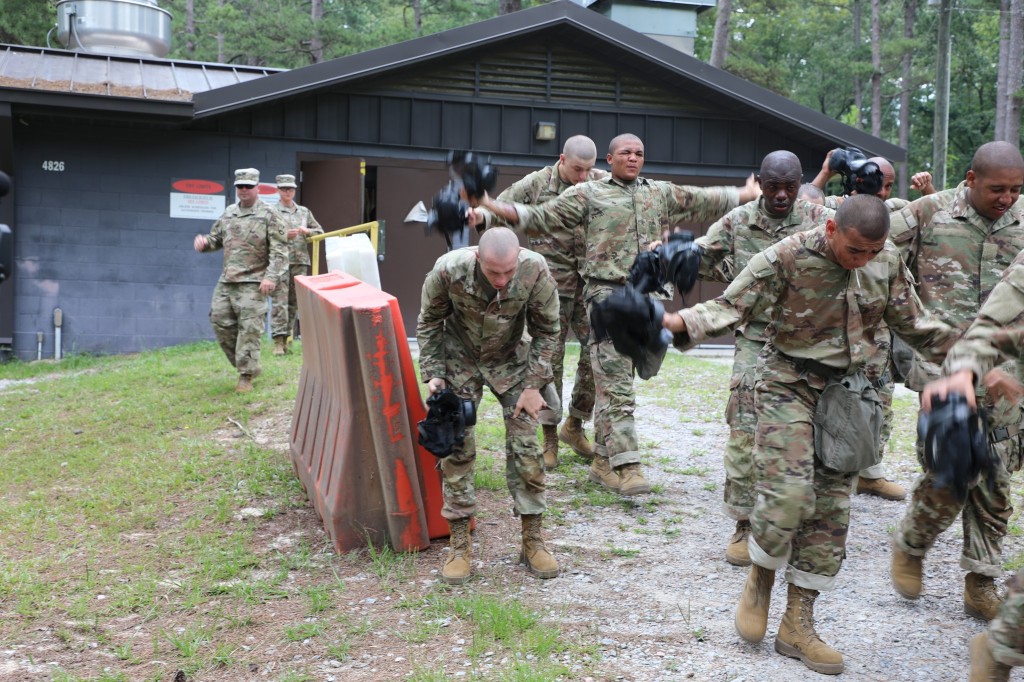
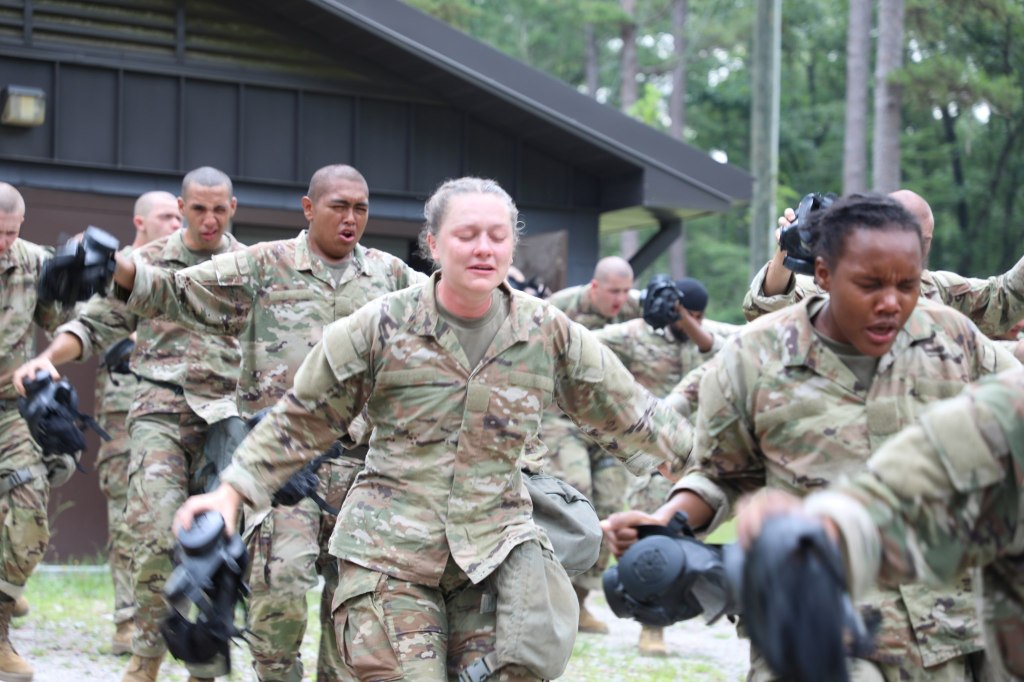
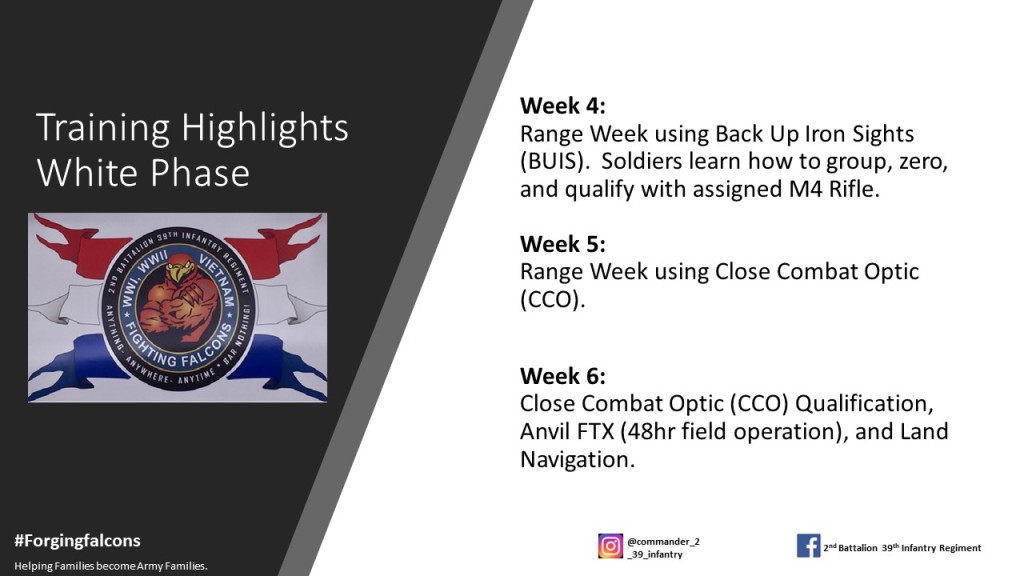
After some classes on how to zero their rifle, the trainees go to the zero range. Zeroing a rifle is basically adjusting the sights of the rifle to the eye of the individual so the bullet goes where the soldier is aiming. This is also their first time with live ammunition.
The Zero Range is a 25 meter range. The targets are 25 meters (82 feet) from the shooter.
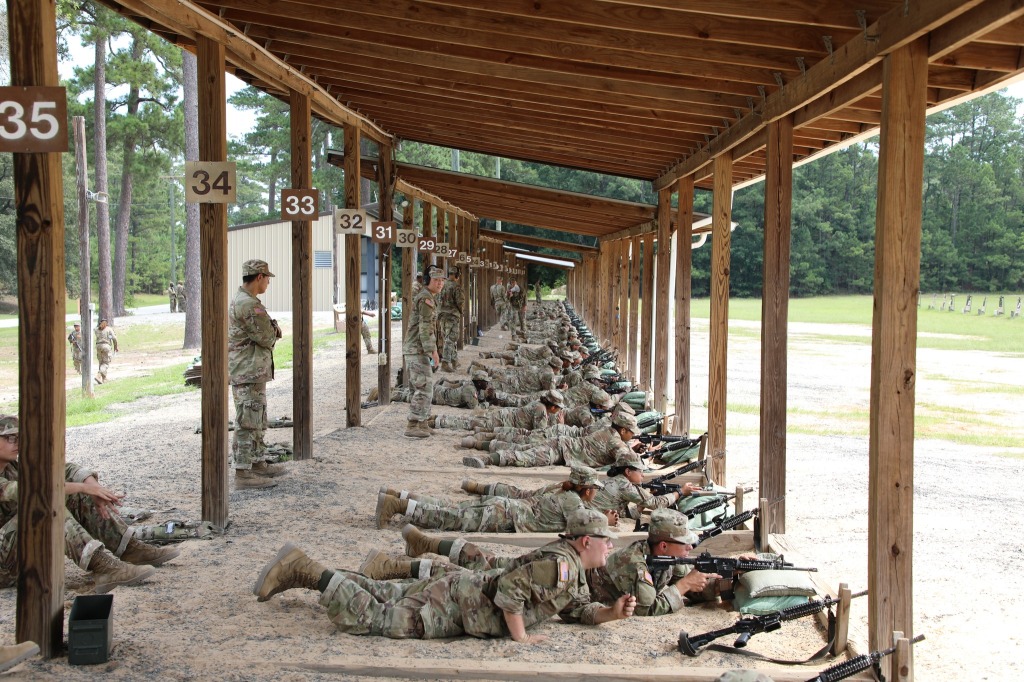
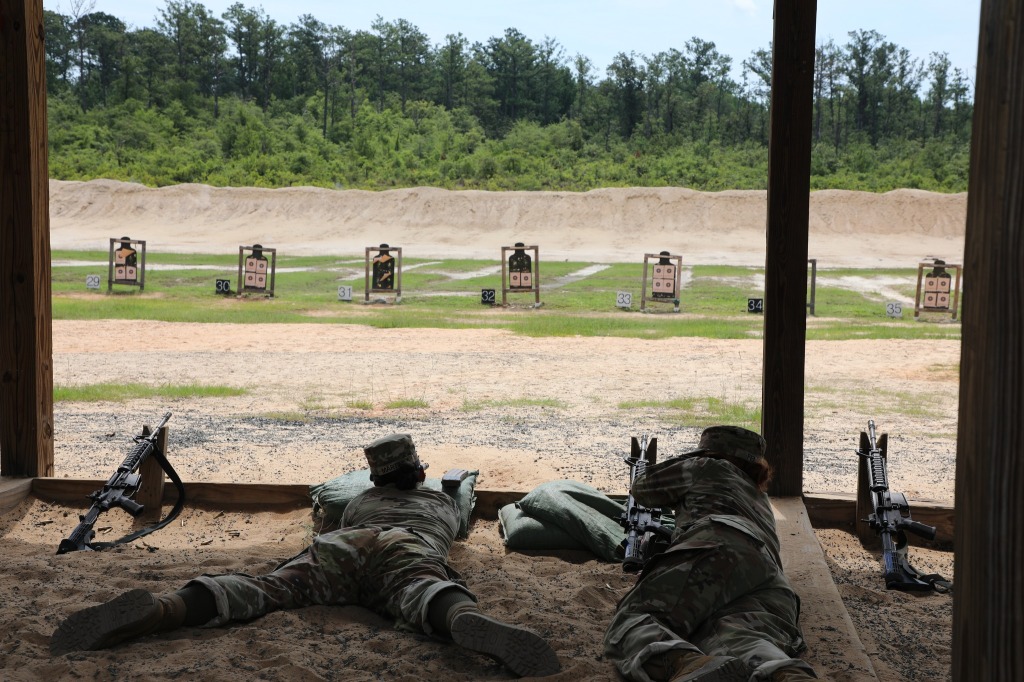
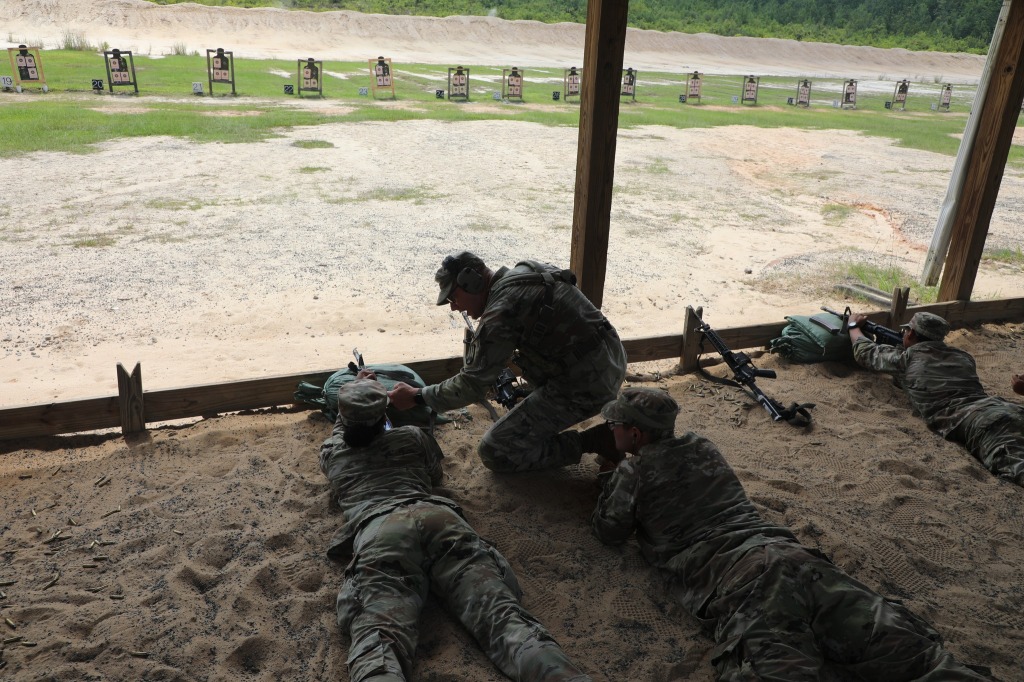
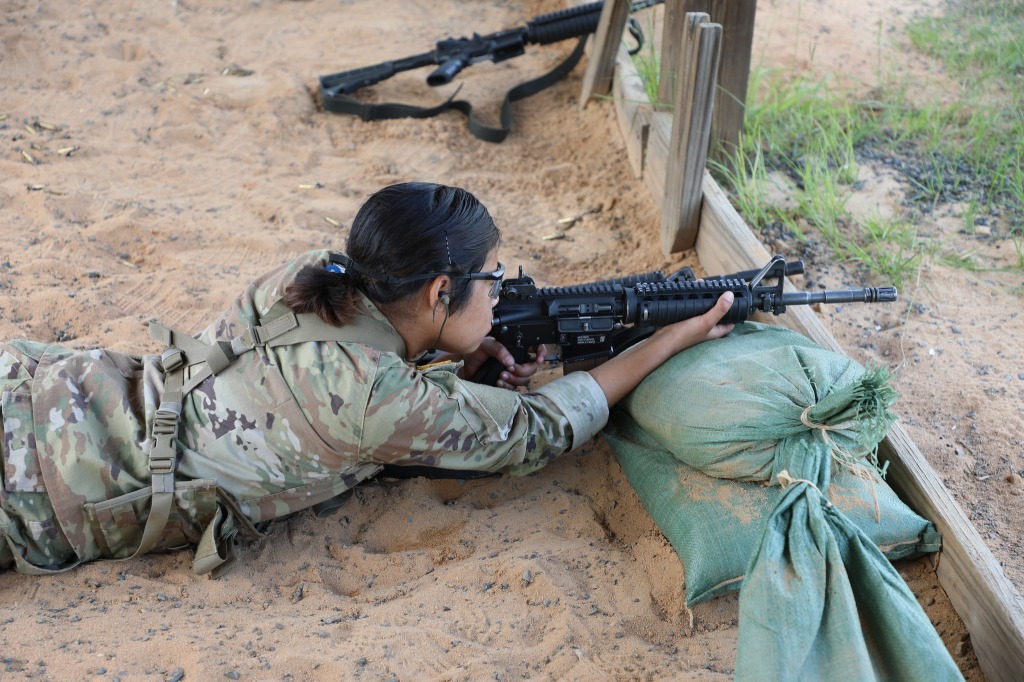
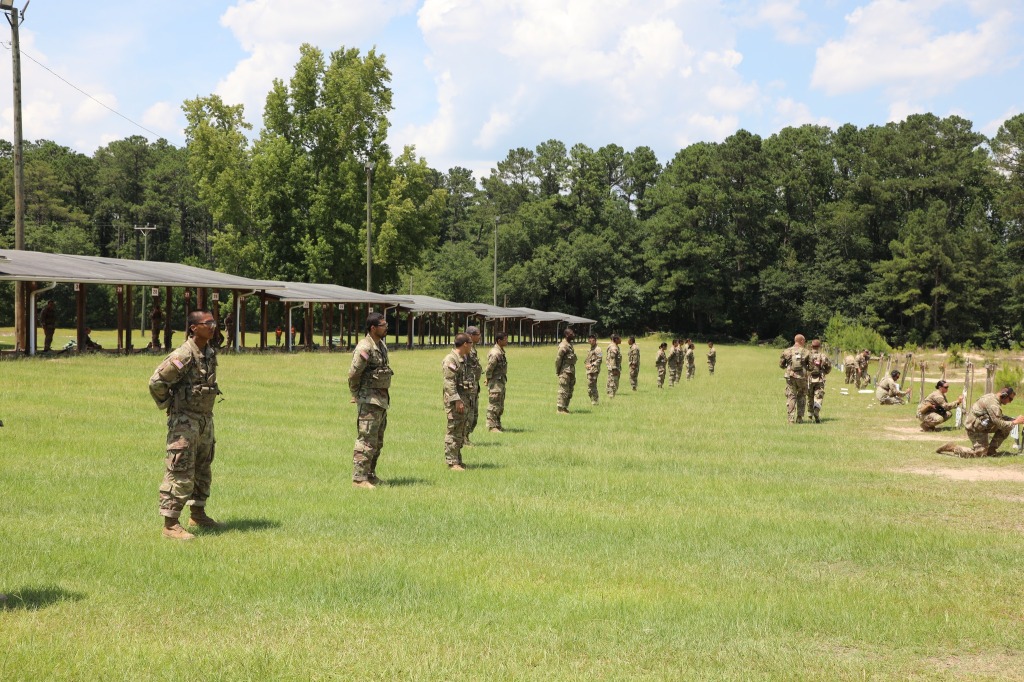

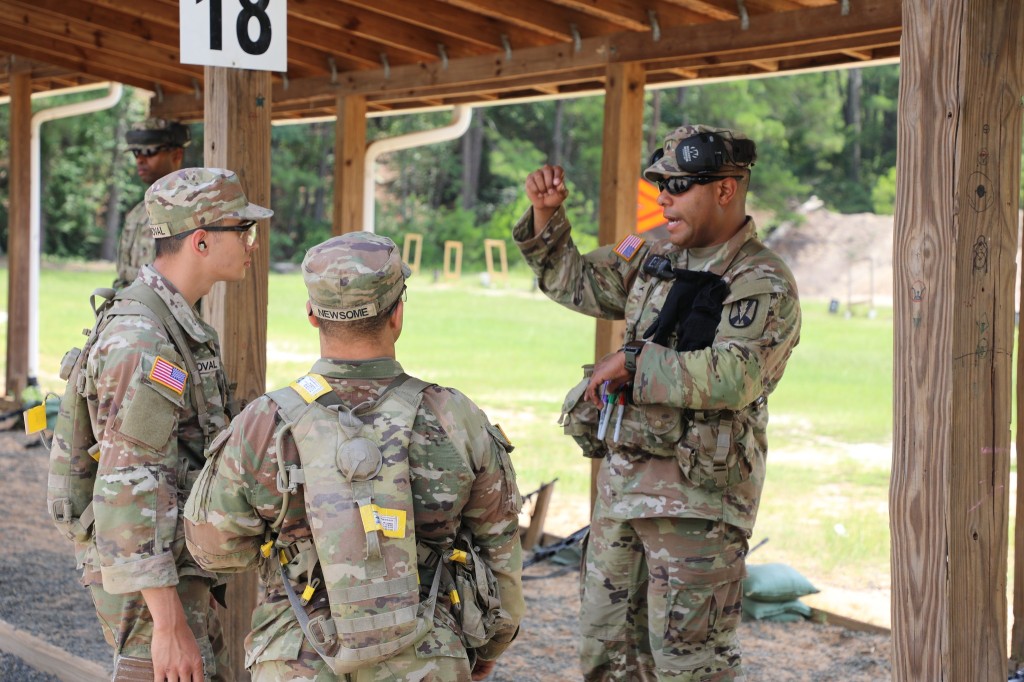
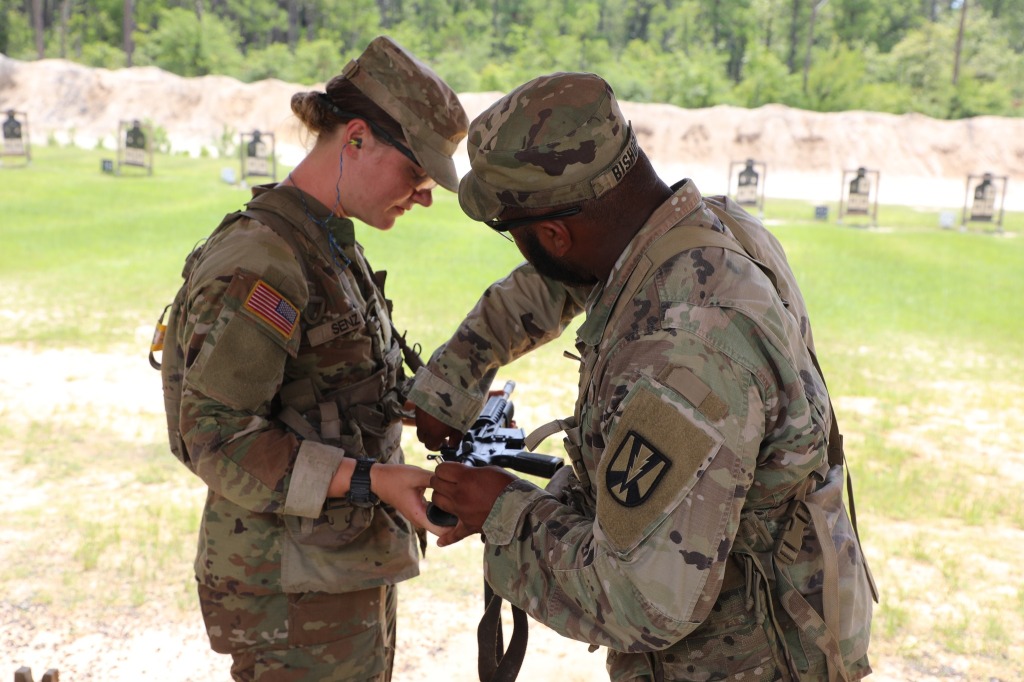
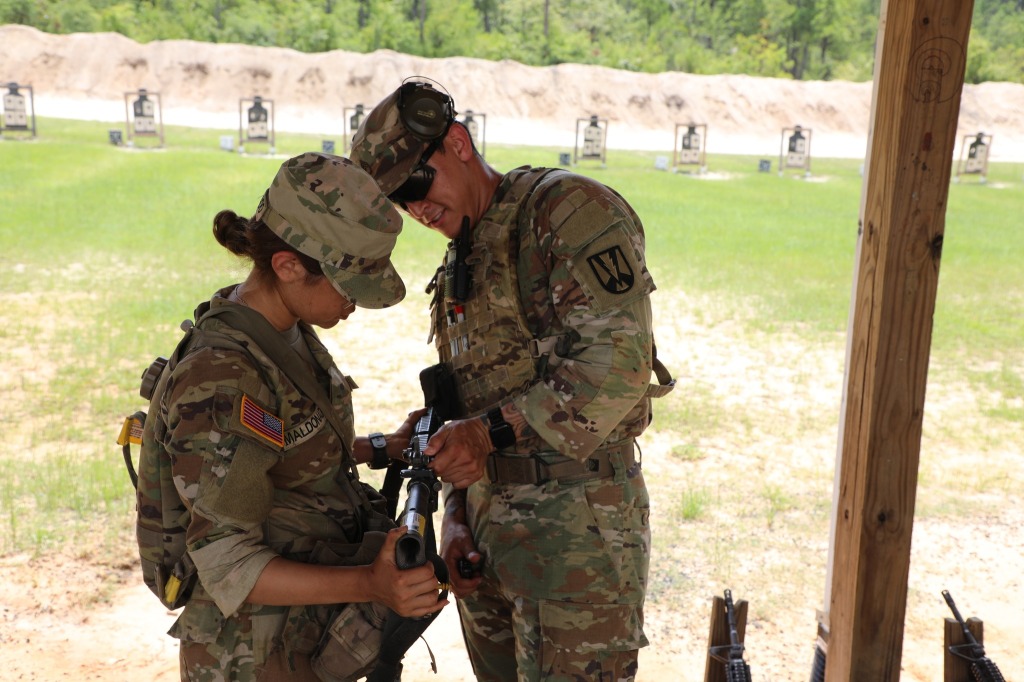
Zeroing the rifle often gets one on one and personal. A young female trainee in my company couldn’t “zero” her rifle. She was in a proper position, good breathing control, good trigger squeeze, but was all over the target. Drill sergeants fired the rifle, it was ok, they were frustrated. I laid down in front of her and watched her face. She did everything right, but the instant she pulled the trigger she tensed and closed both eyes. For many, especially women, the zero range is the first time they have fired a gun, when she could finally keep her eyes open, she zeroed, qualified with the rifle and graduated from basic training.
After zero range they spend a day on the Engagement Skills Trainer then go to practice qualification. They go through everything with live ammo in qualification shooting, but that day is practice.
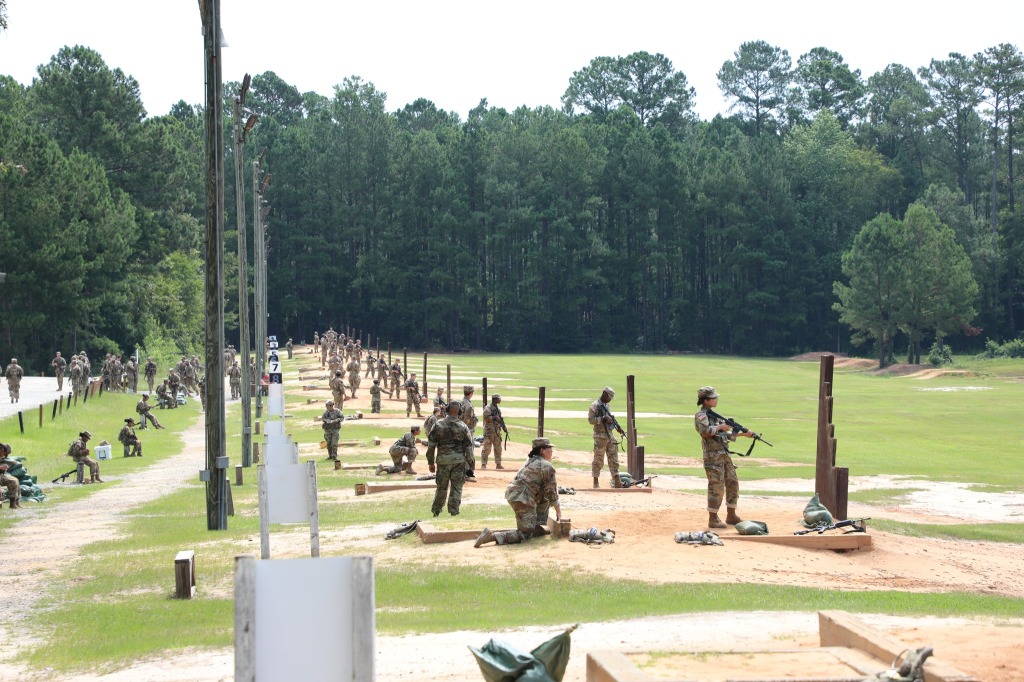
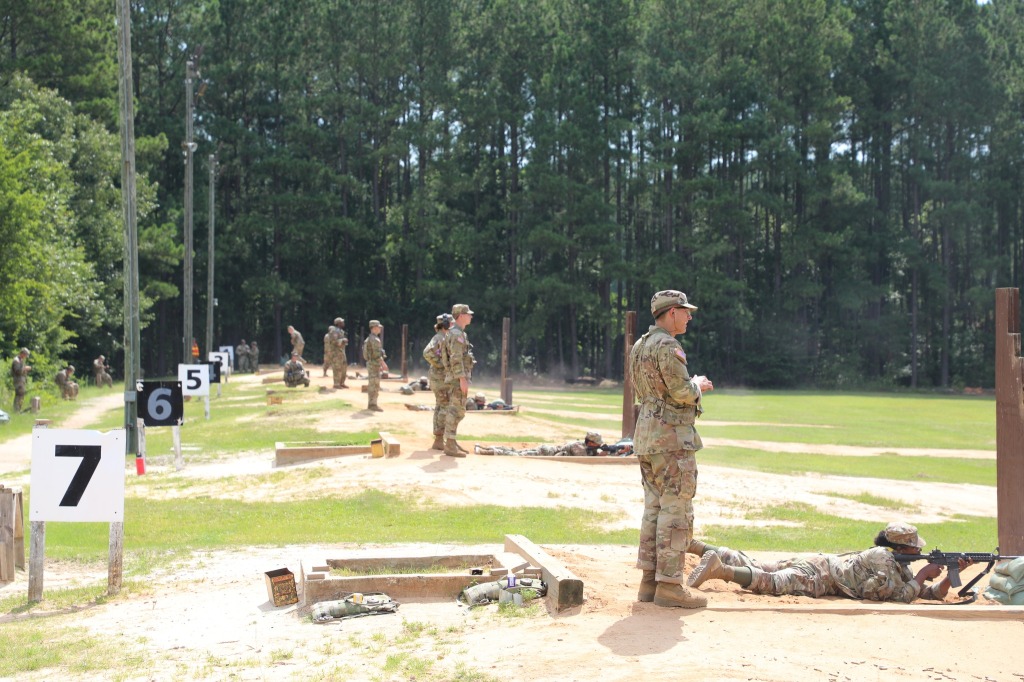
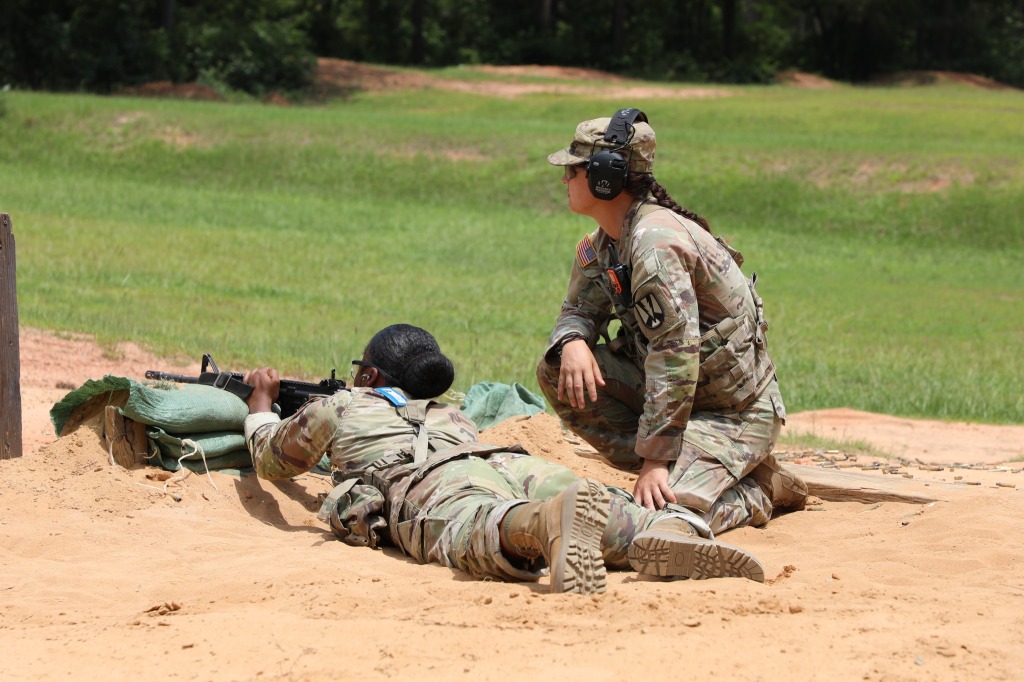
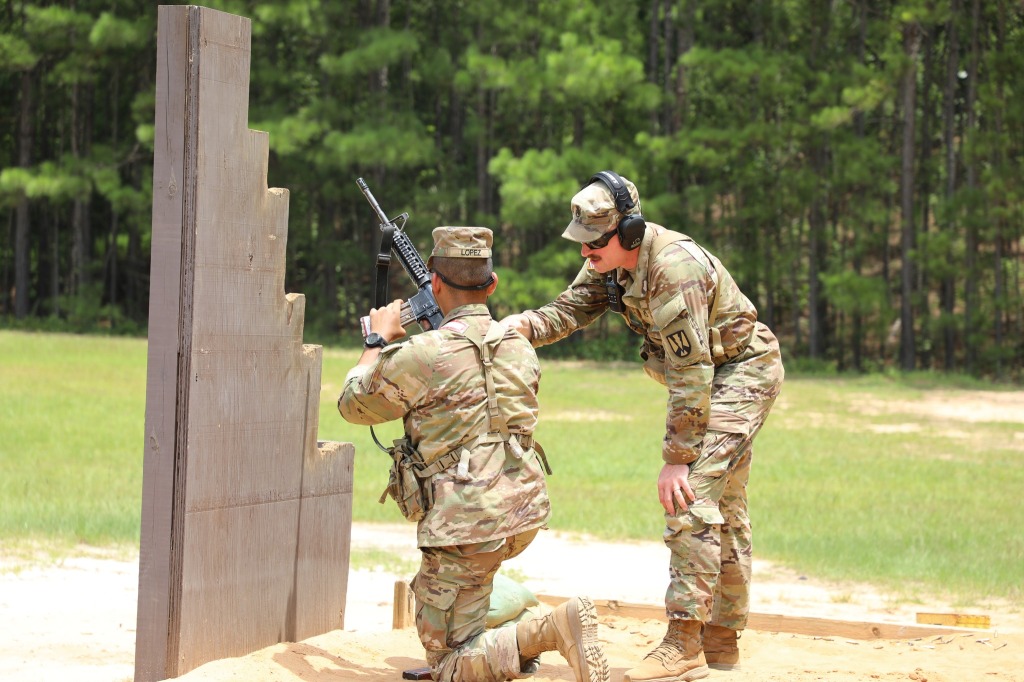
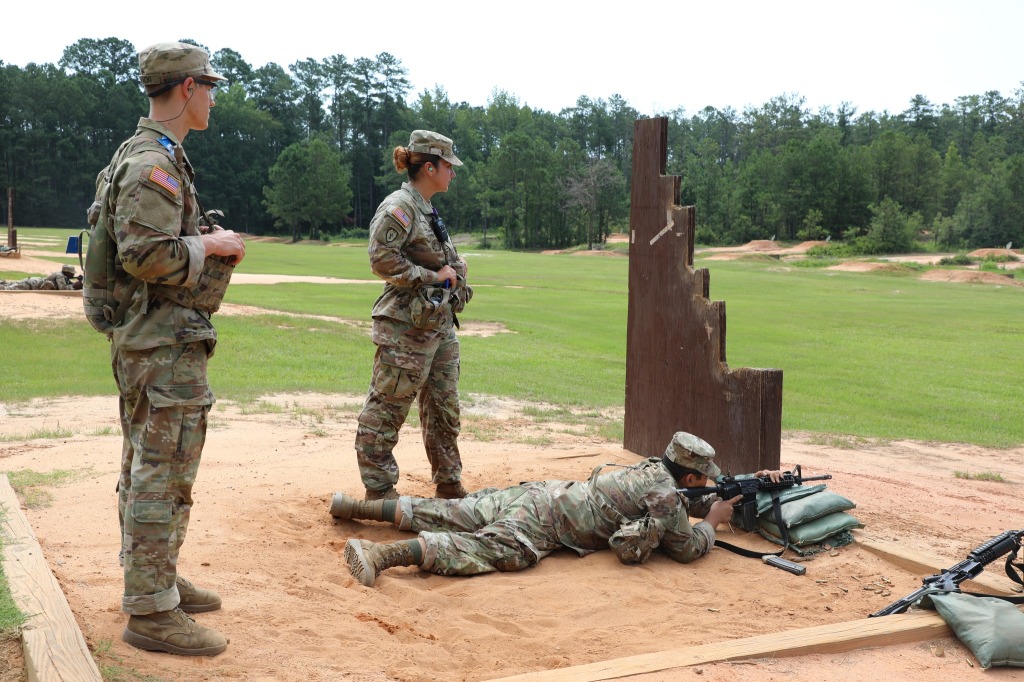
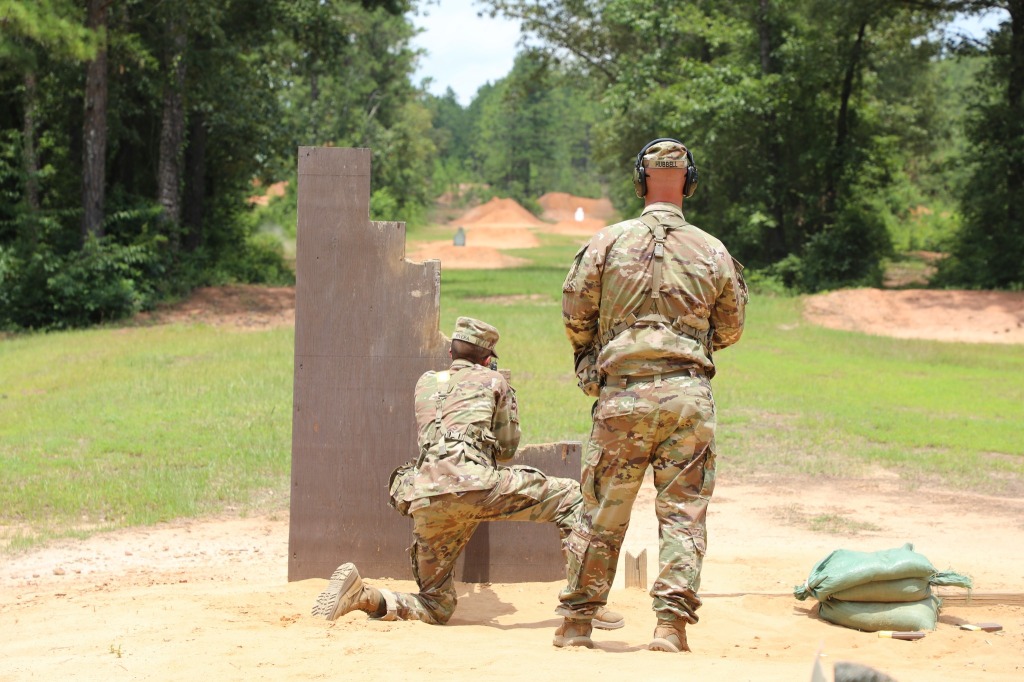


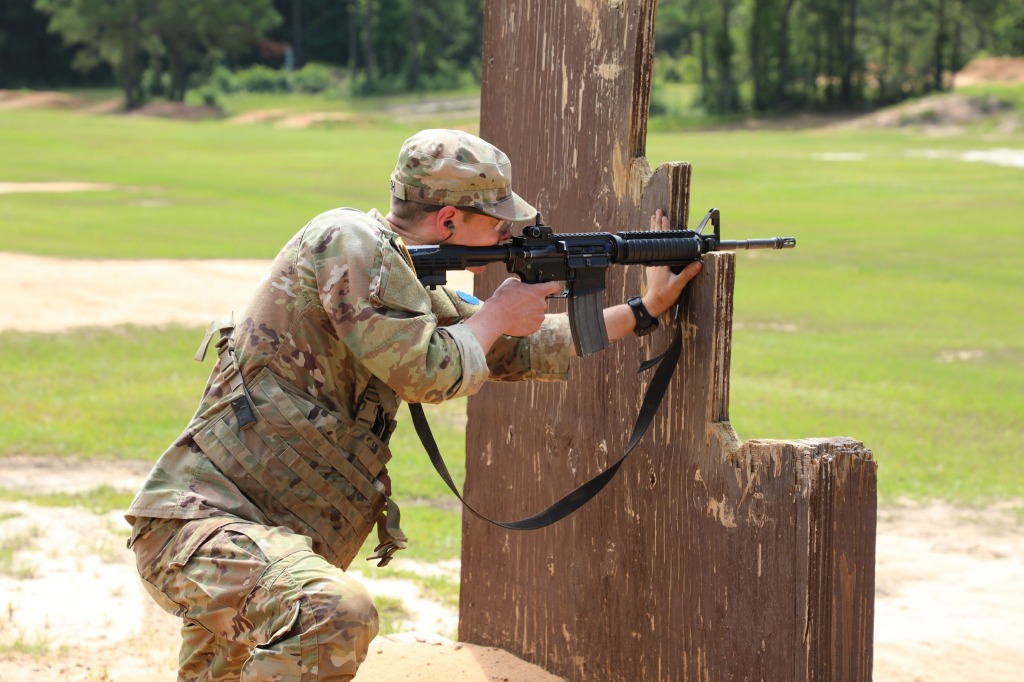
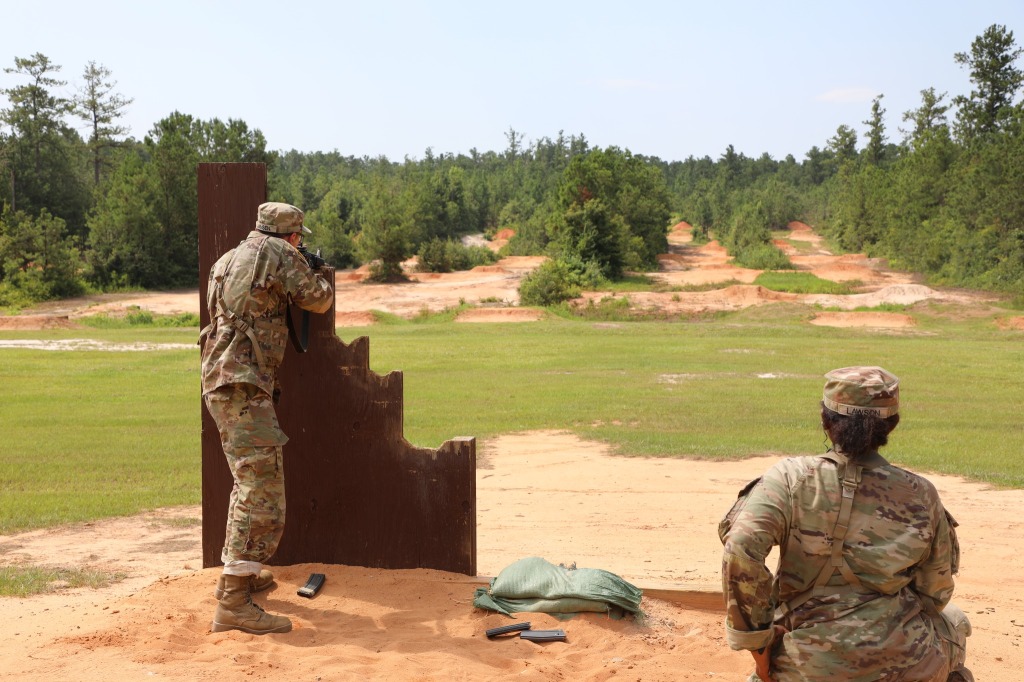
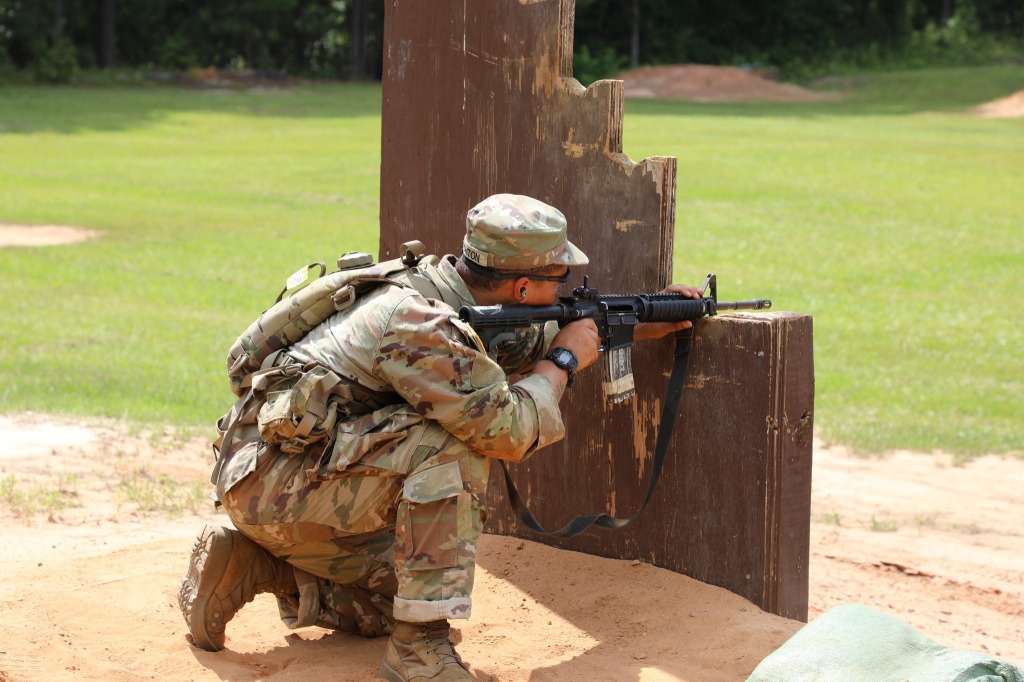
After qualifying with their rifle they move to the close combat course, i.e., fire and maneuver, which starts with group instruction, then one on one.
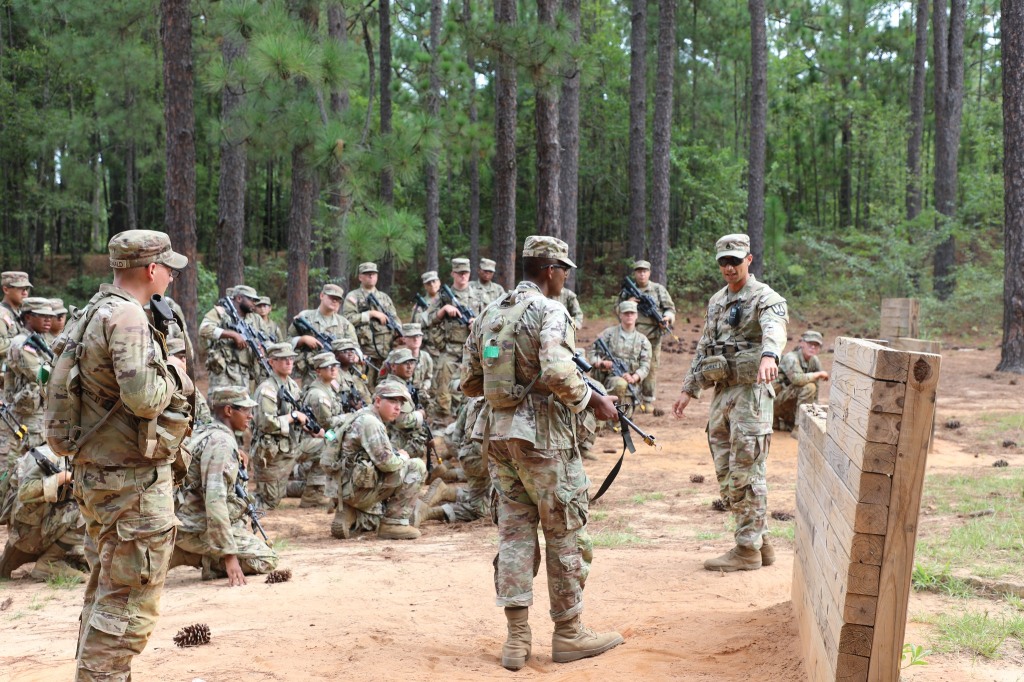
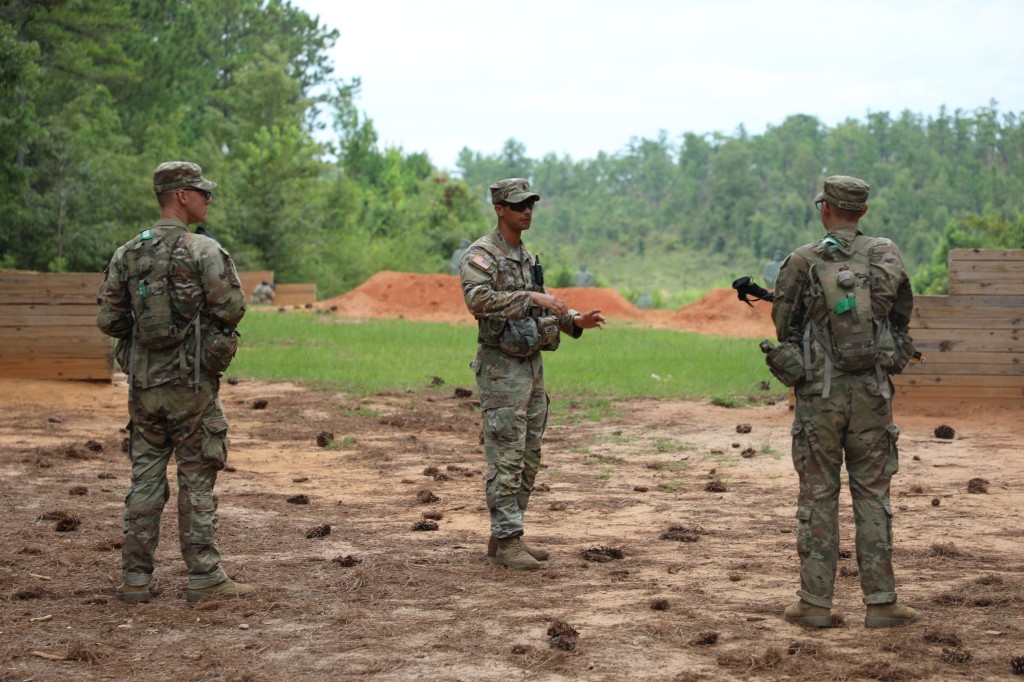
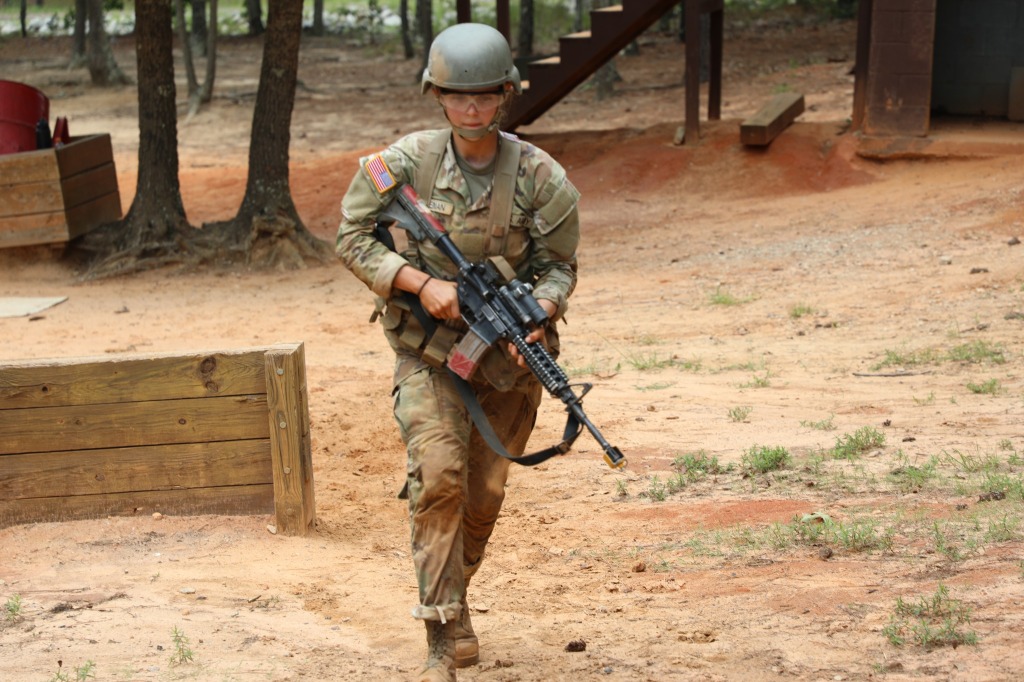
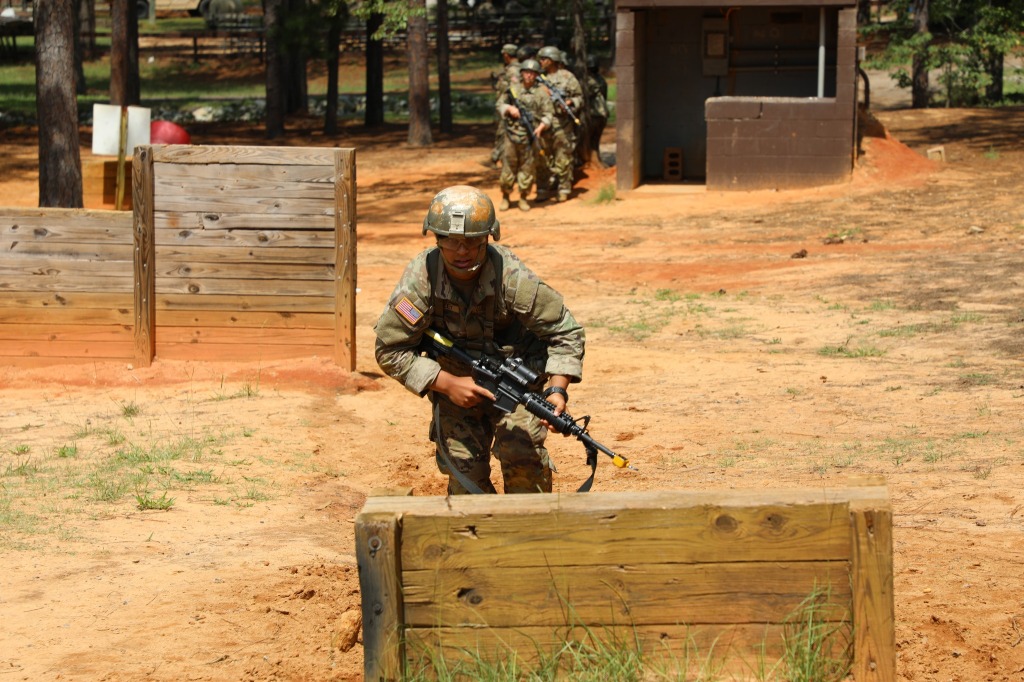
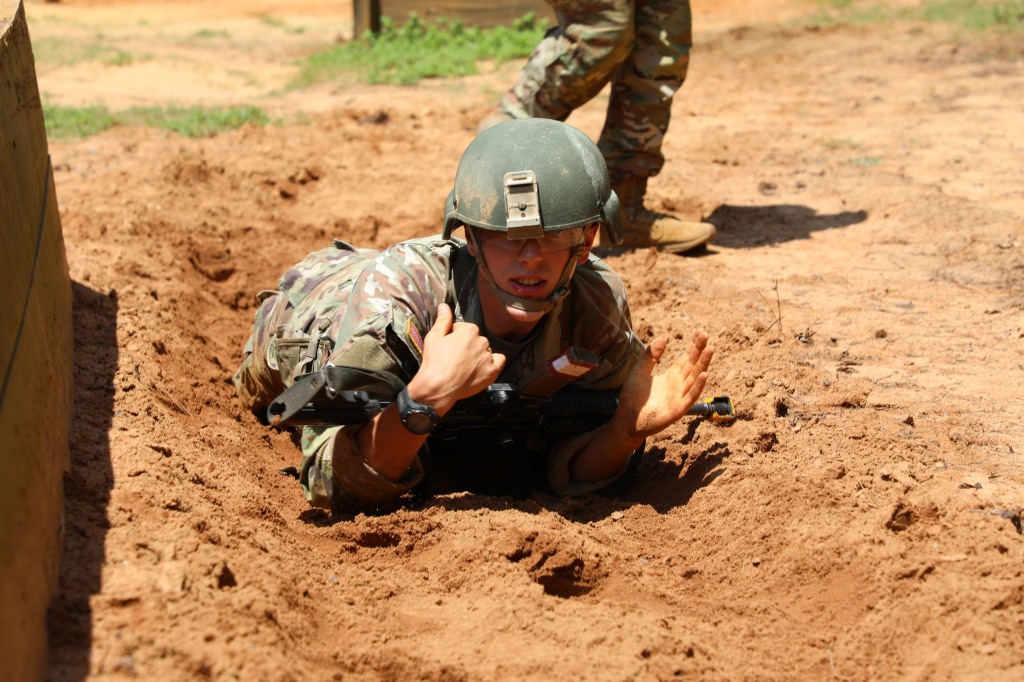
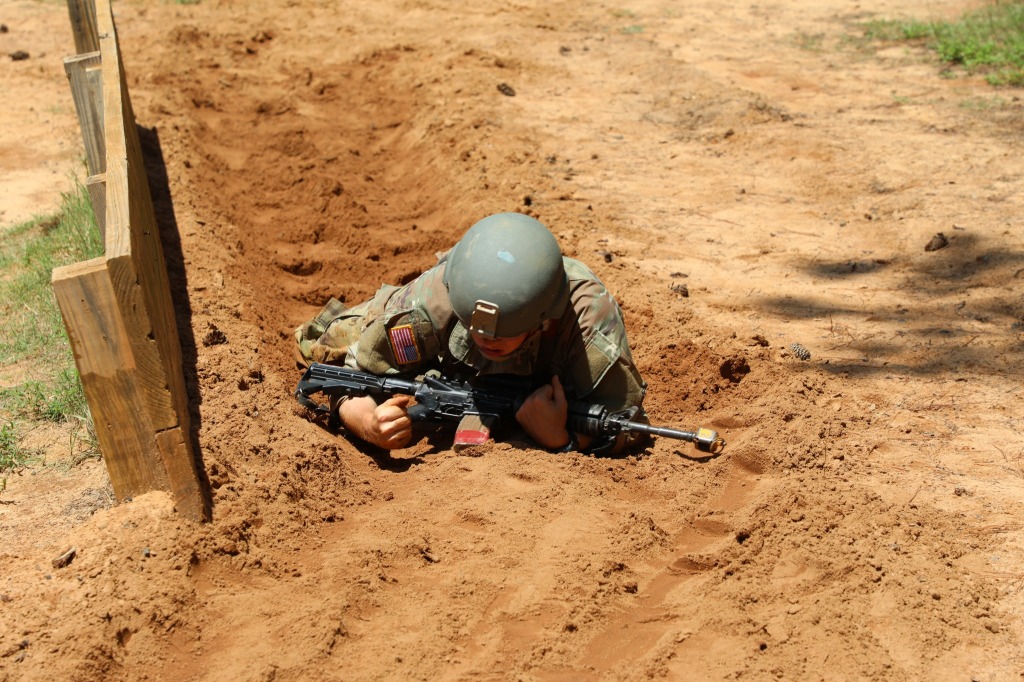
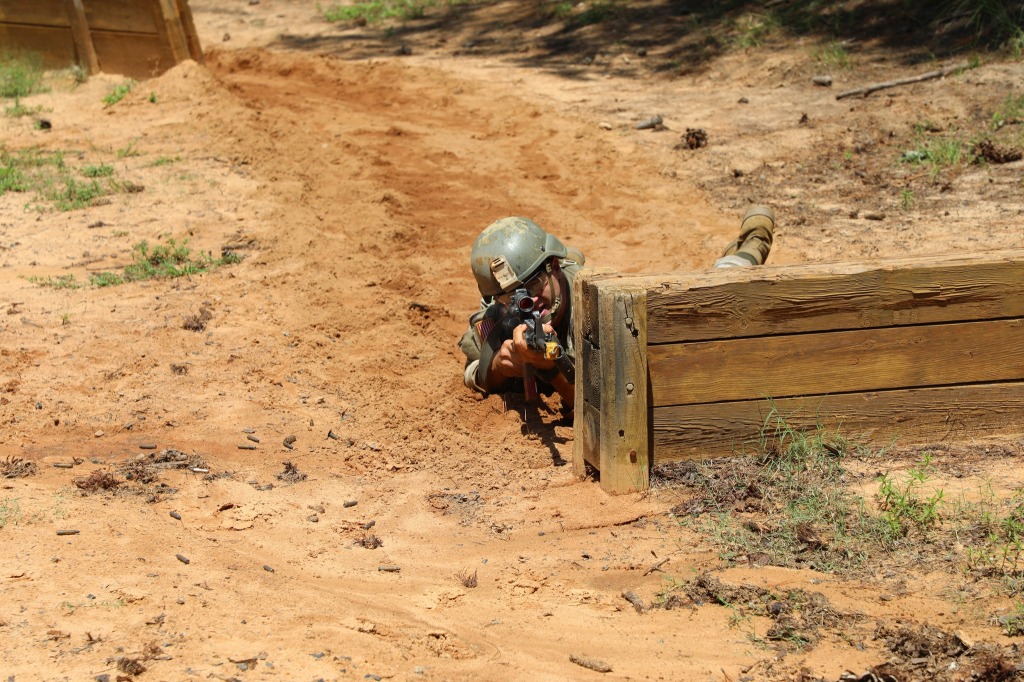
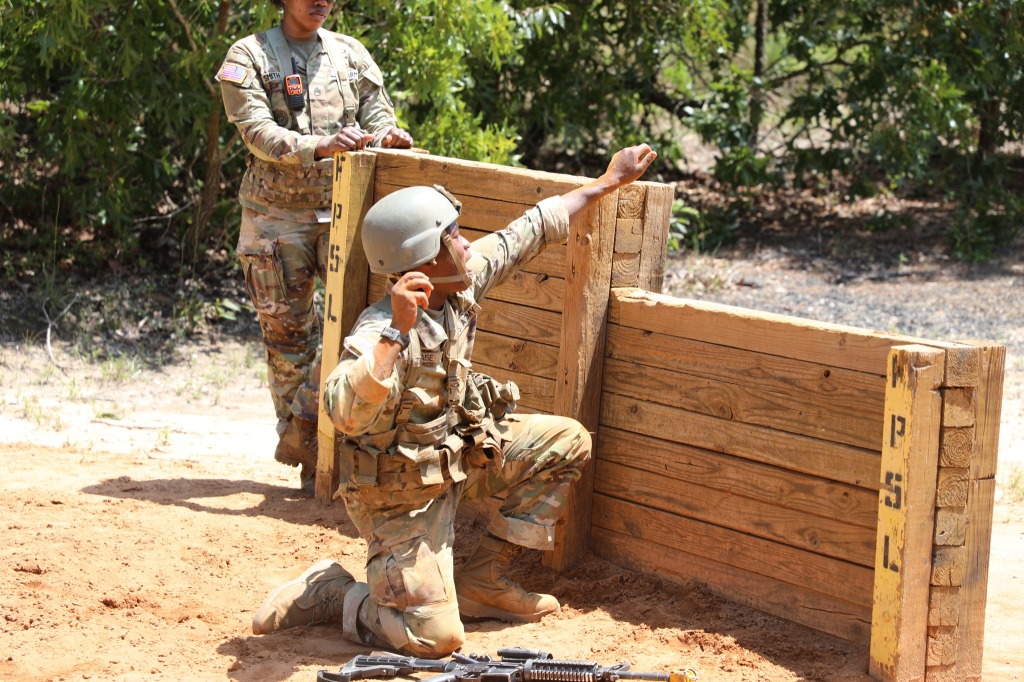
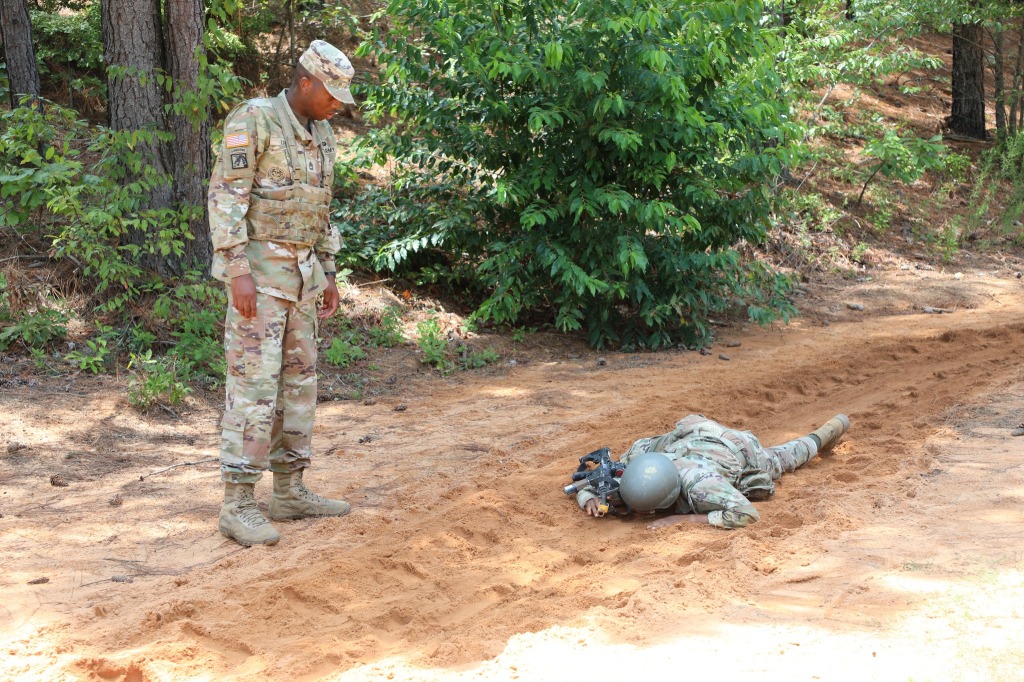
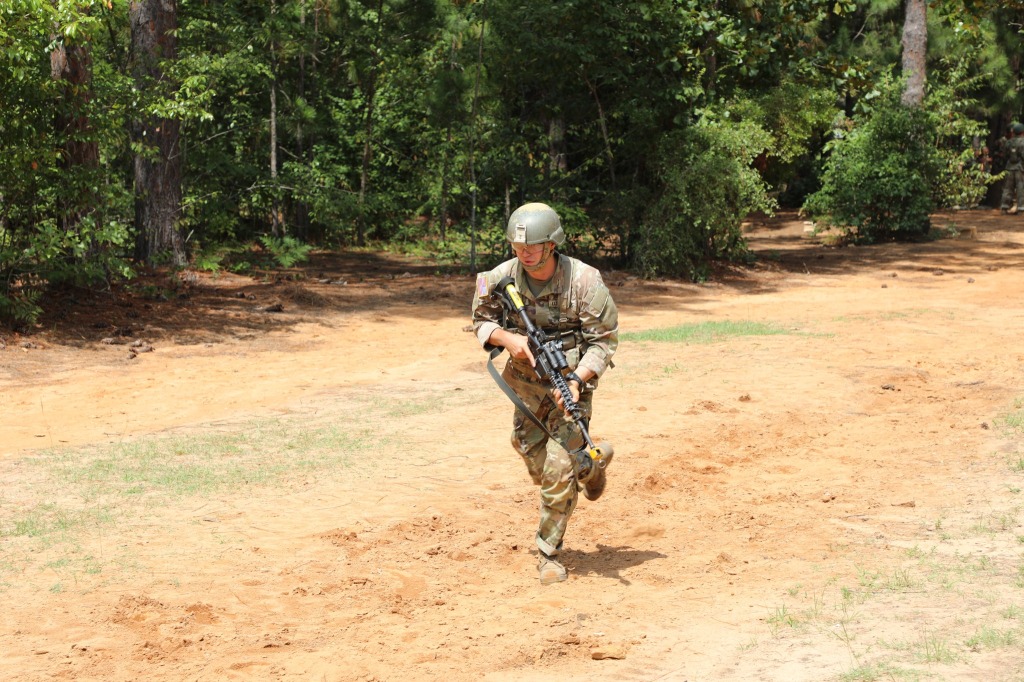
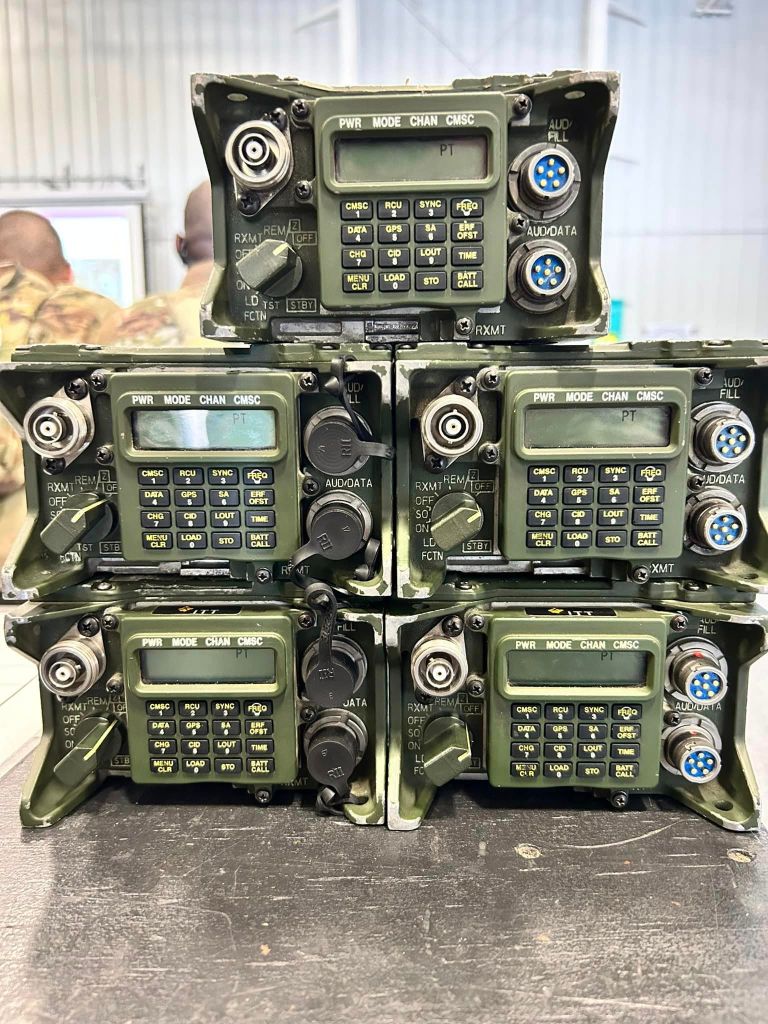

The following is from the 2nd Battalion 39th Infantry facebook page;
2nd Battalion, 39th Infantry Regiment “Fighting Falcons”
The Fighting Falcons of Delta Company underwent their second Field Training Exercise (FTX), known as the Anvil. The first day consisted of rucking 7.8 miles from the Company to the Area of Operation (AO), where they received various instruction blocks. The topics taught were Indirect Fire, Buddy Team Live Fire, Radios, Reporting (SALUTE and SPOT reports), and Evacuating Causalities. Next, they mastered their navigation skills at the land navigation course, ST LO. By the conclusion of the FTX, they sharpened their tactical battle skills for their final FTX, known as the Forge.
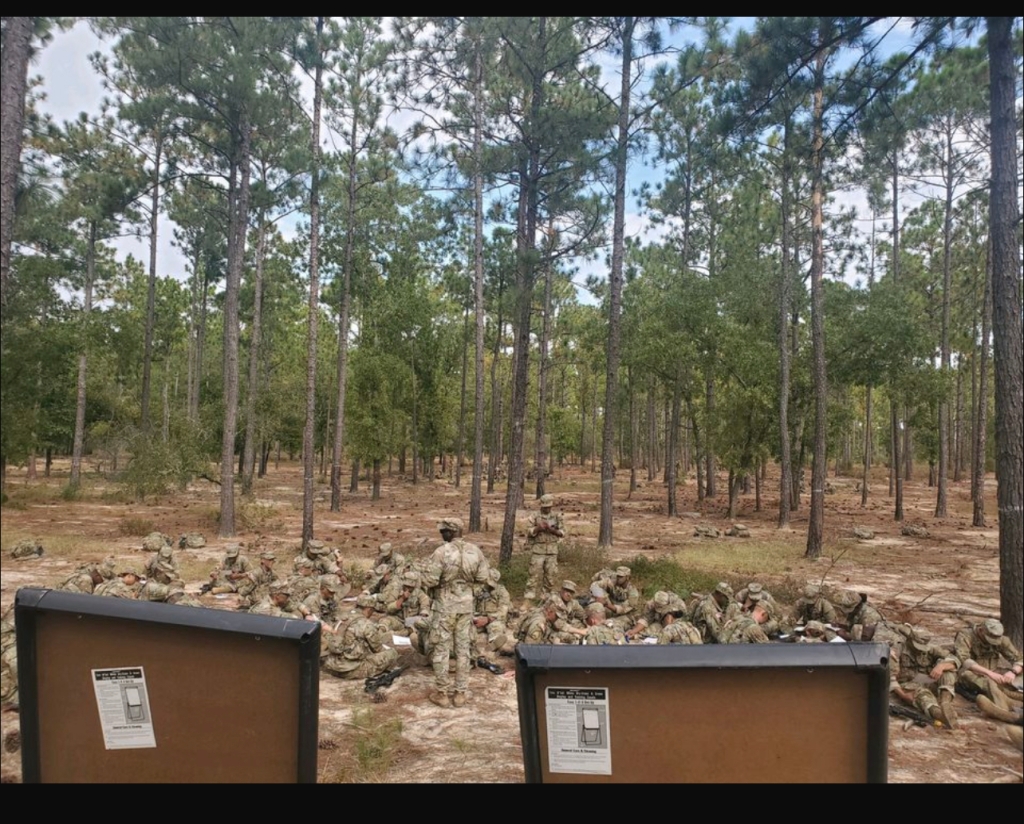
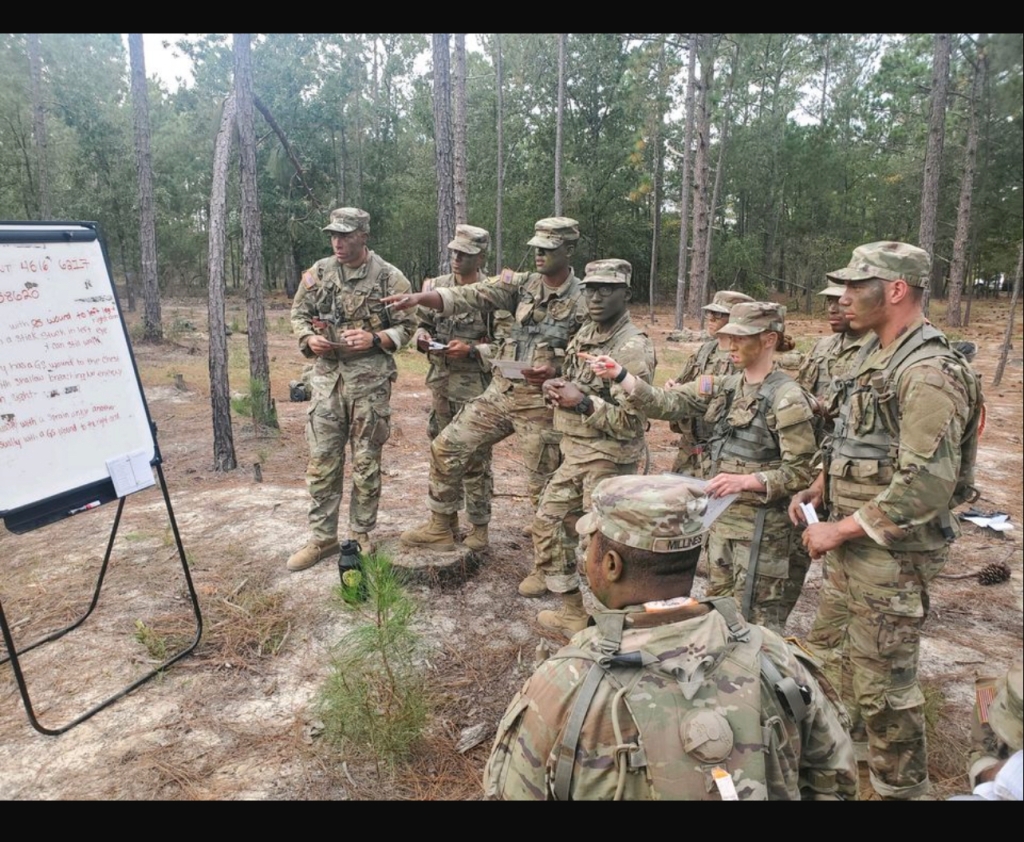
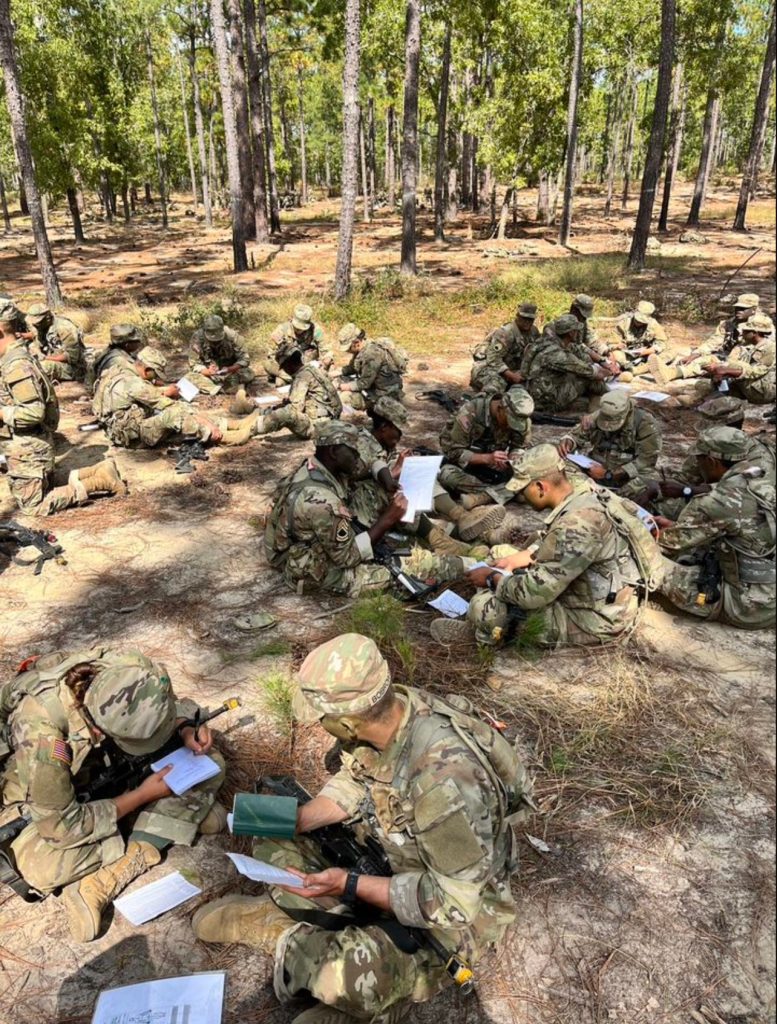
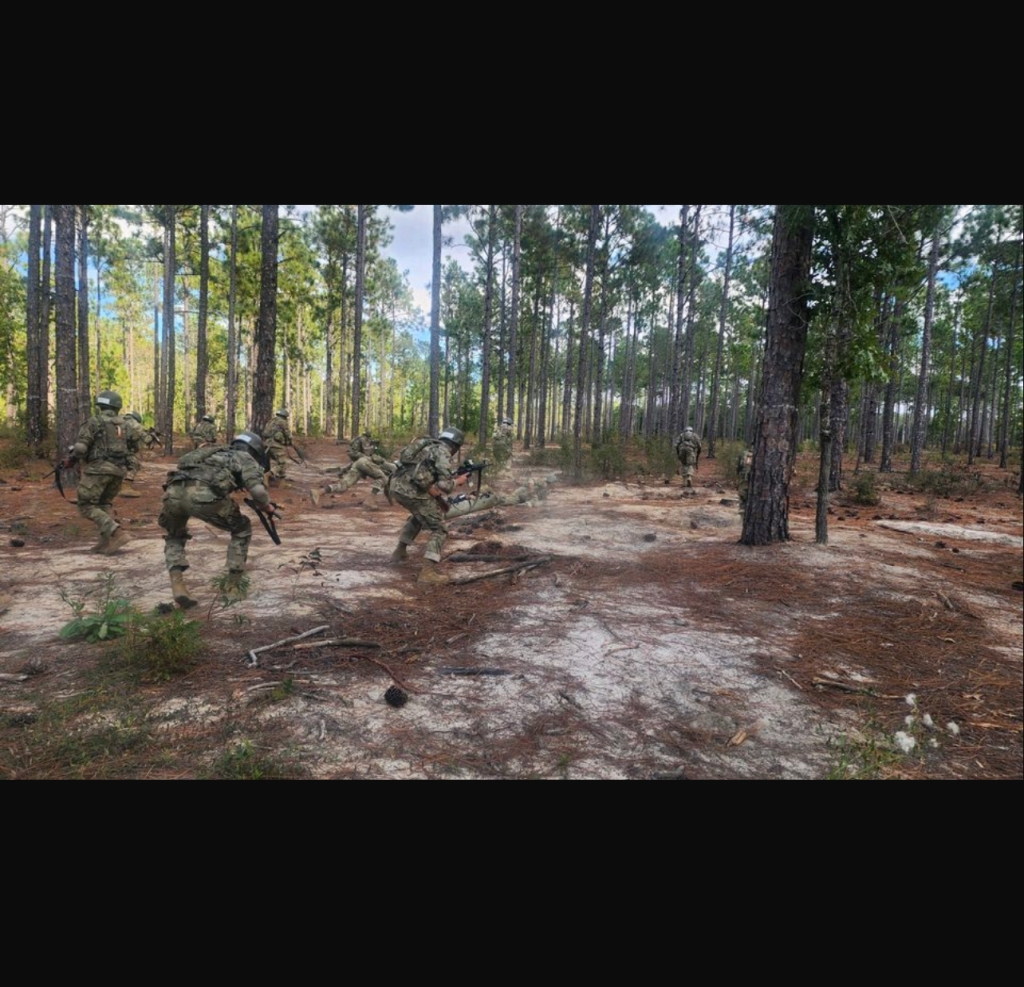
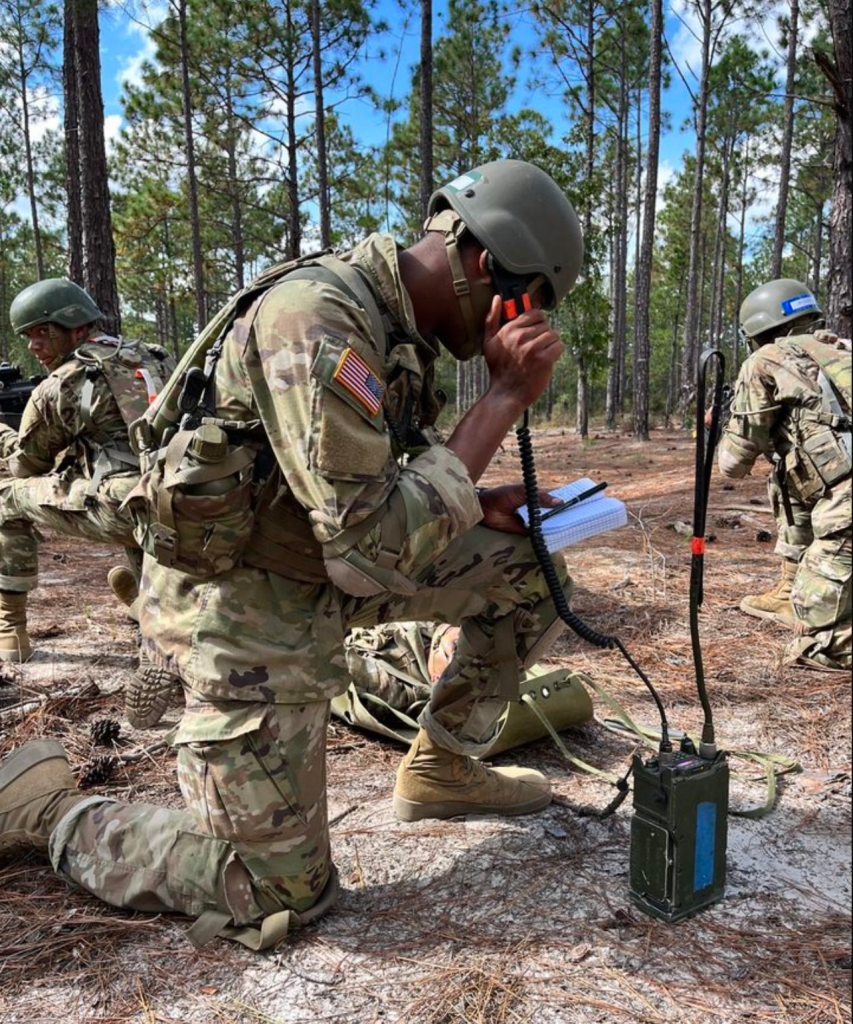
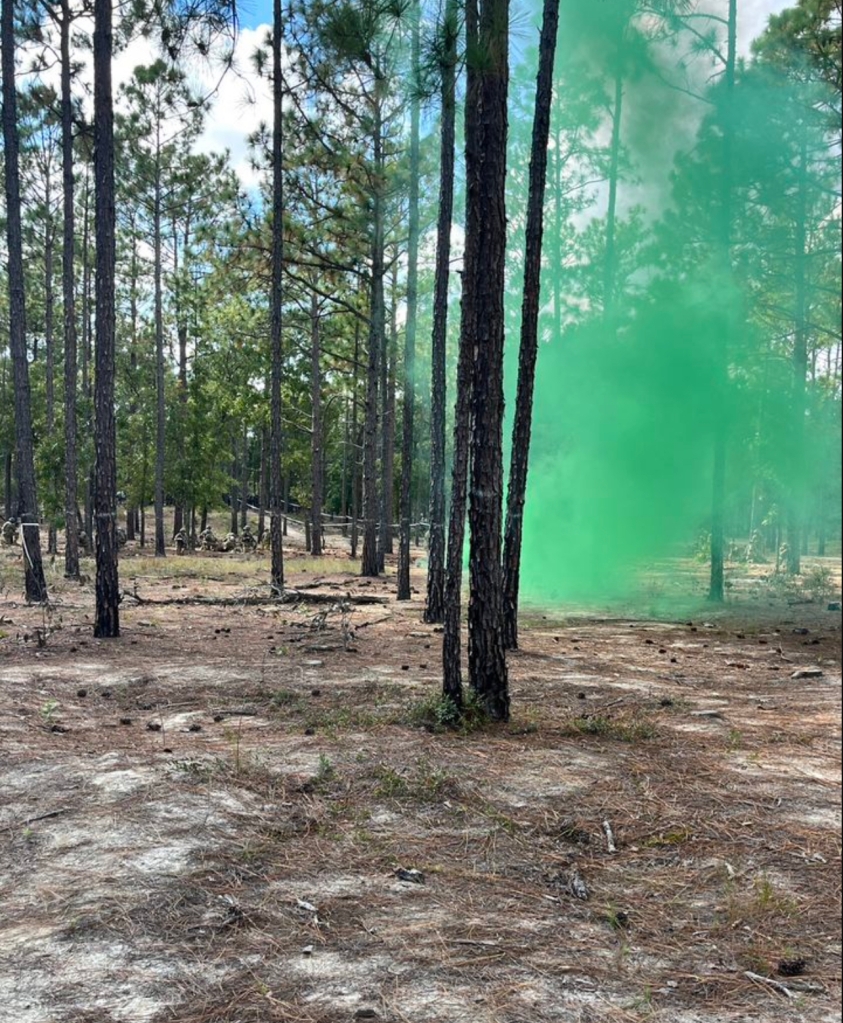
An early morning ACFT to measure progress.
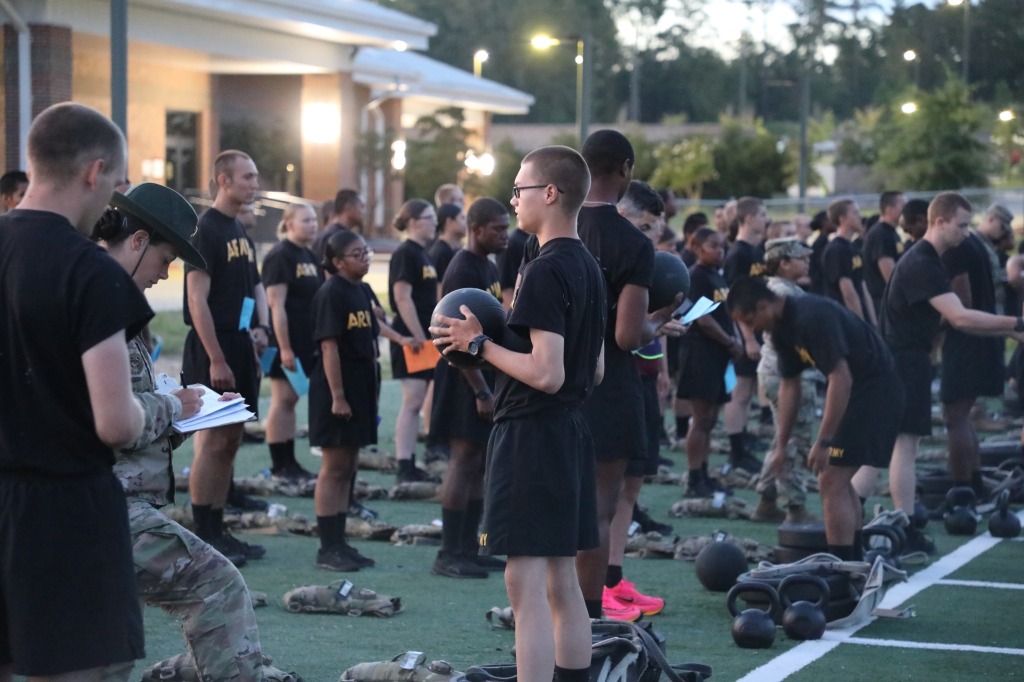
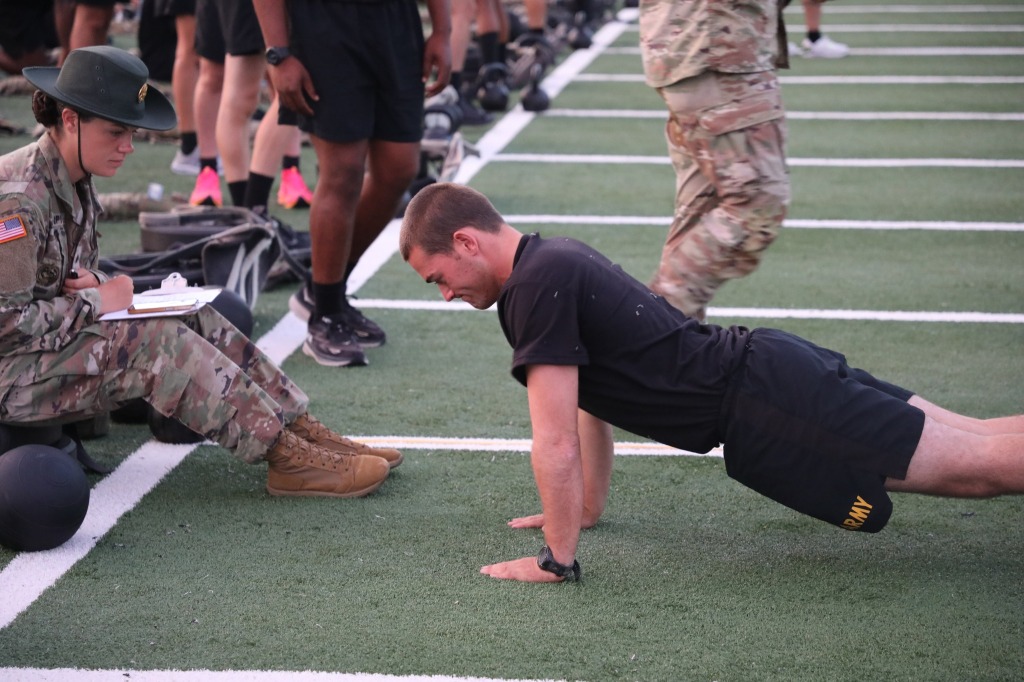

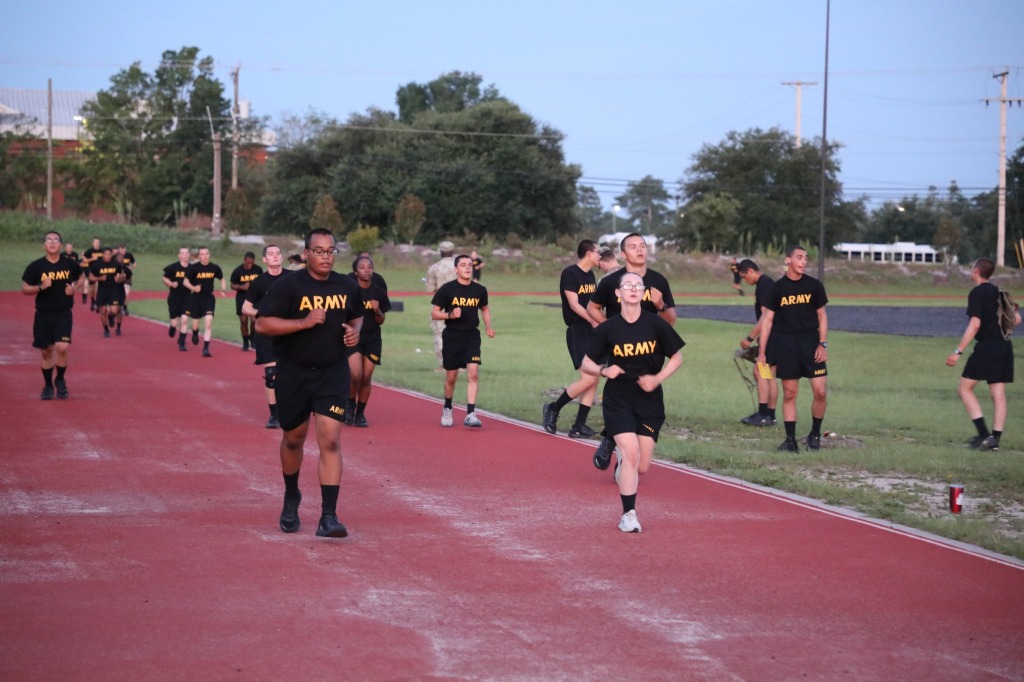
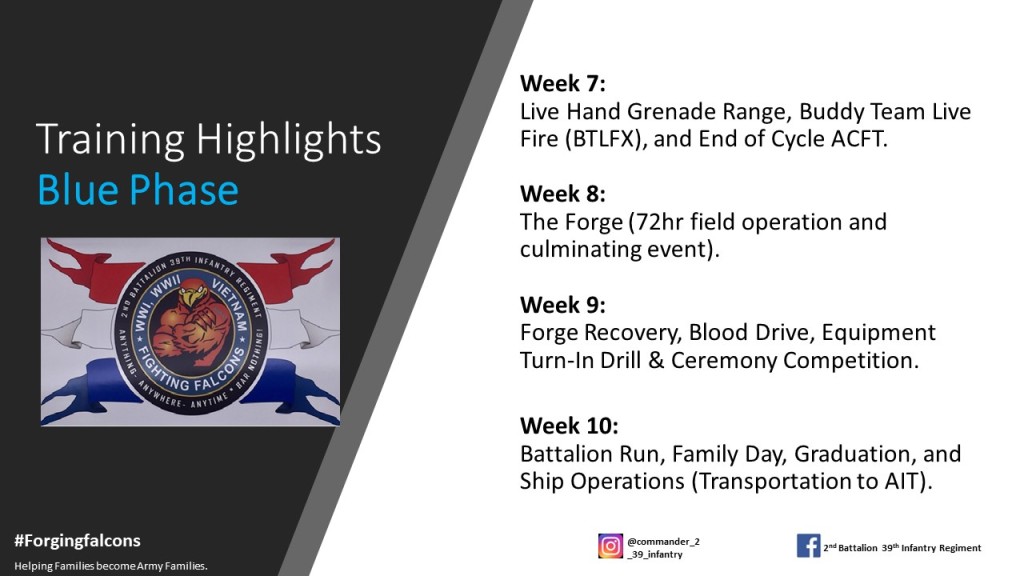
Yes, they do throw live hand grenades.
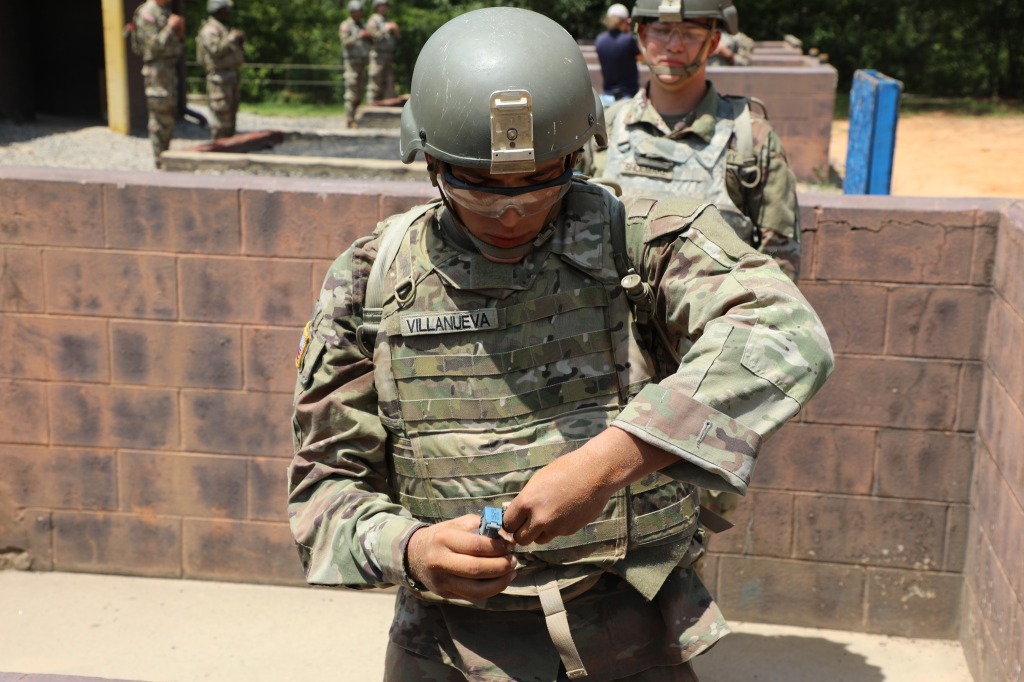
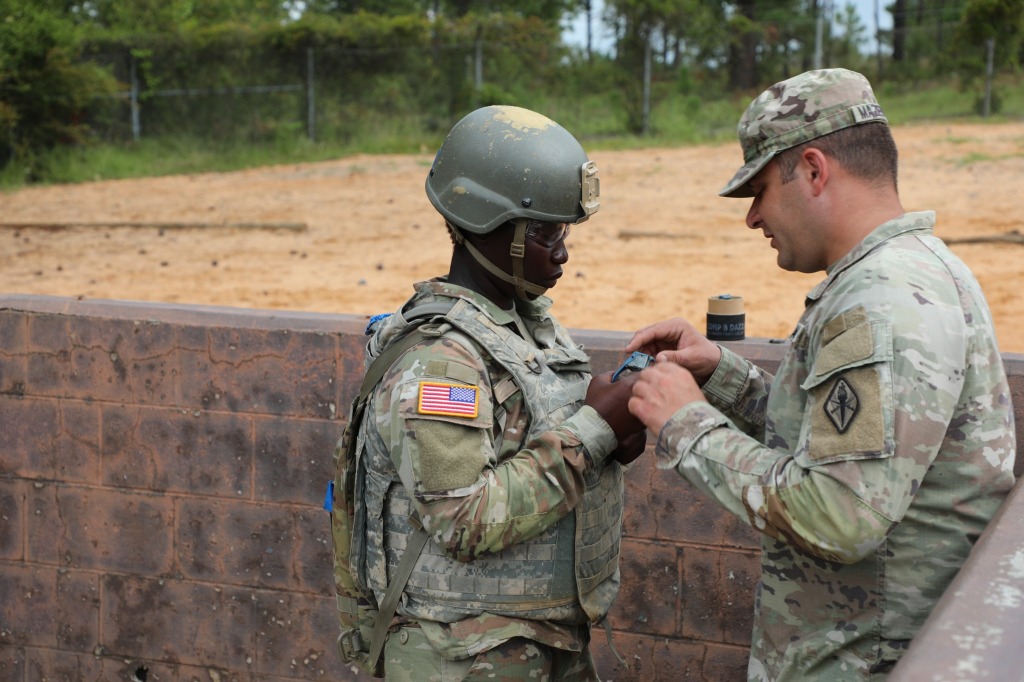
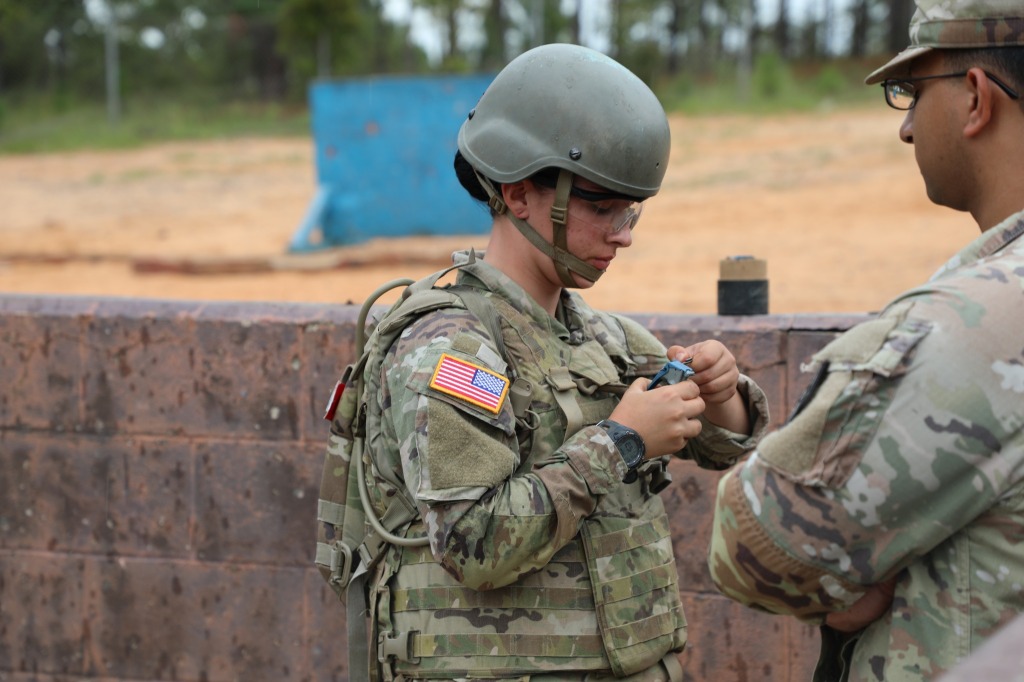
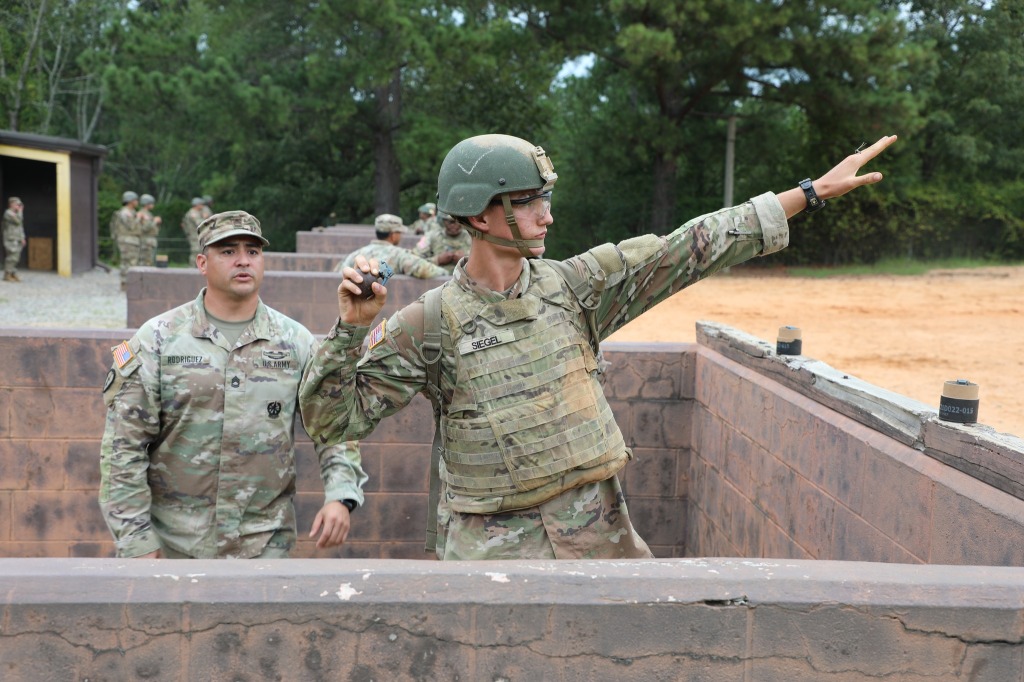
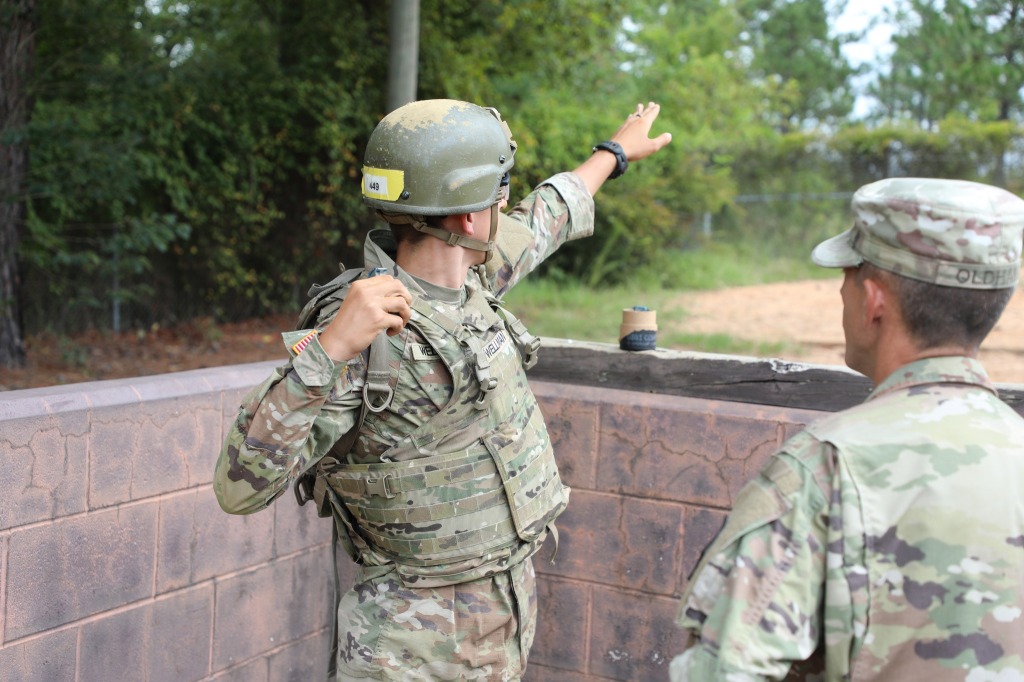
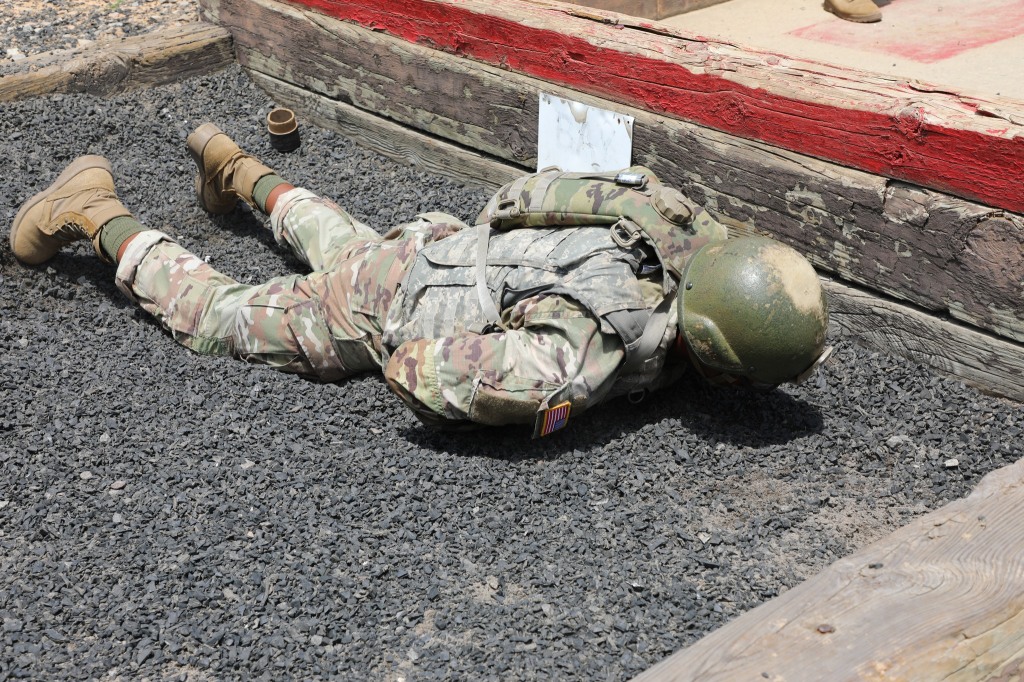
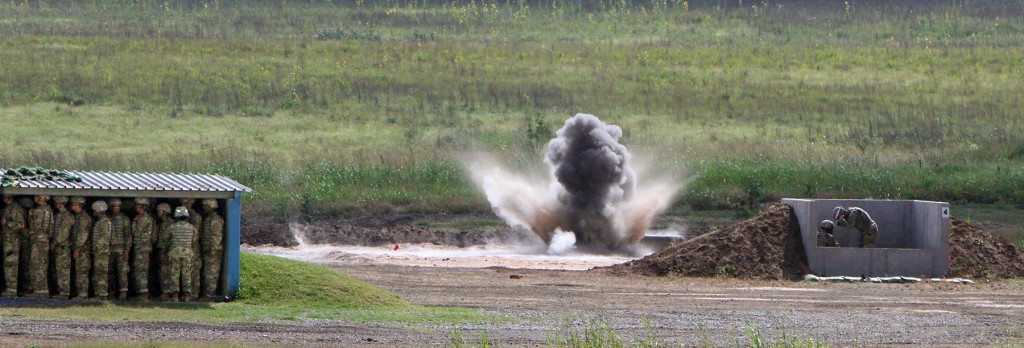
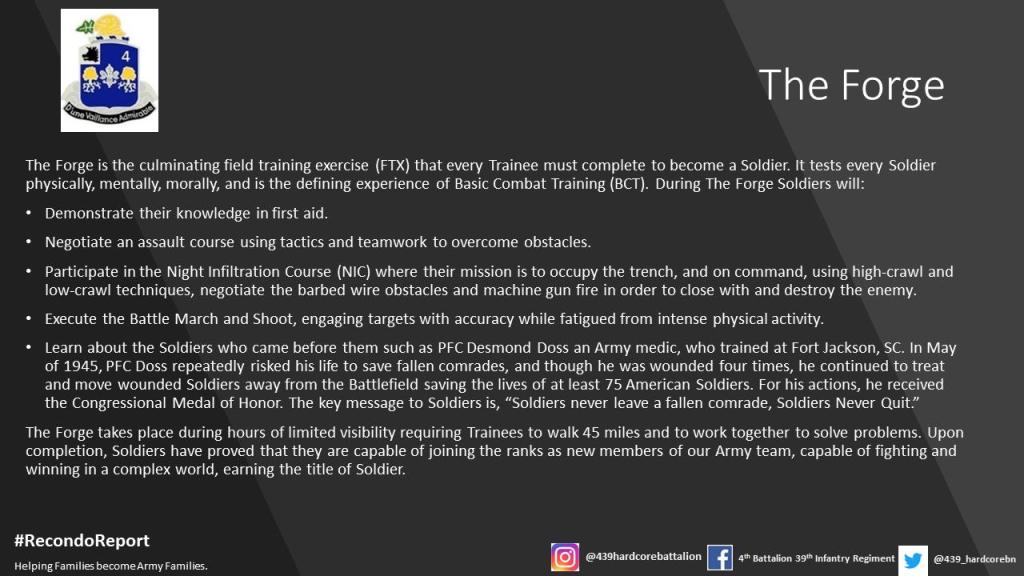
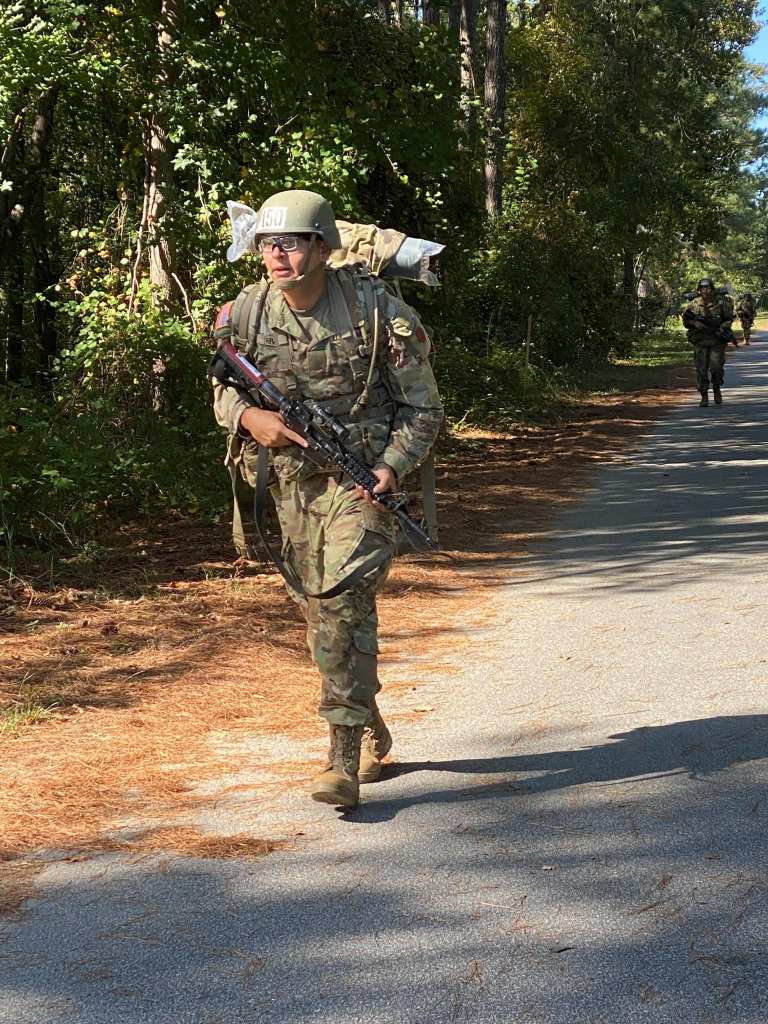

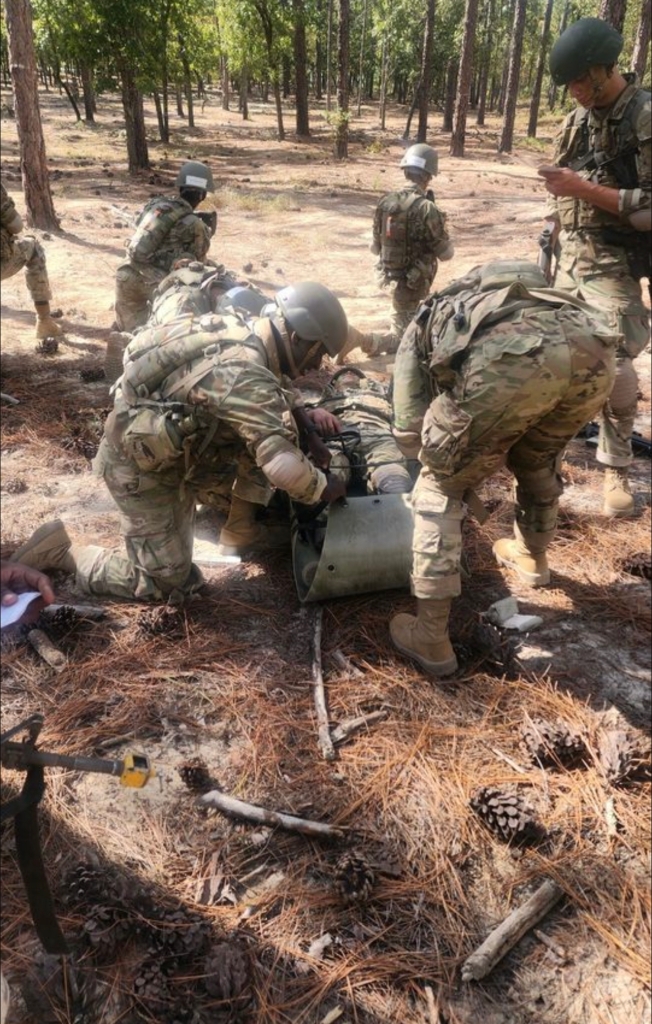
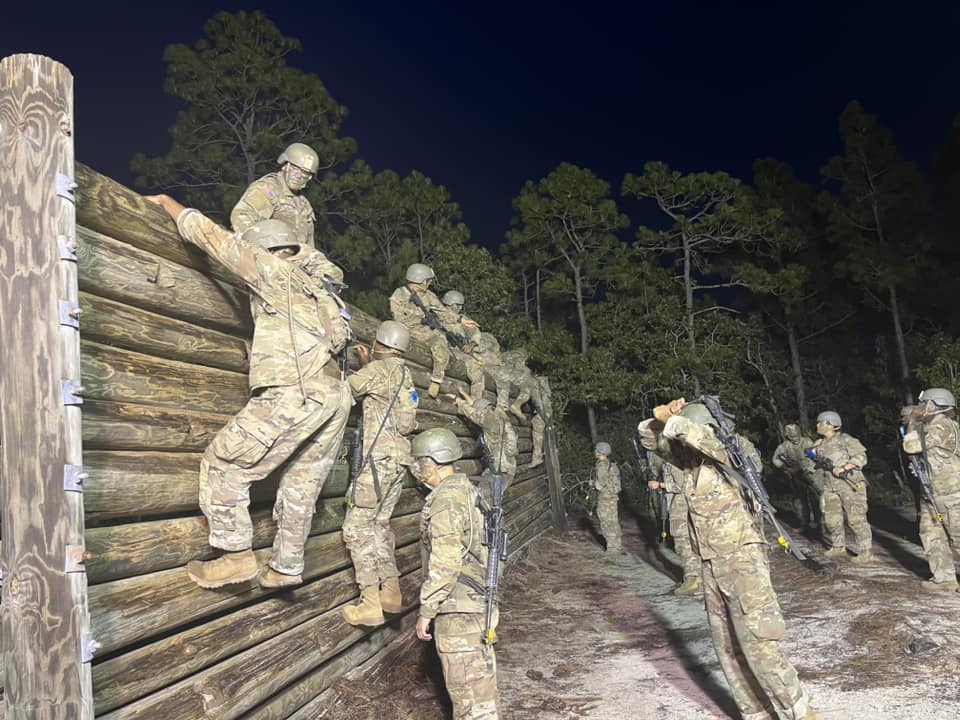
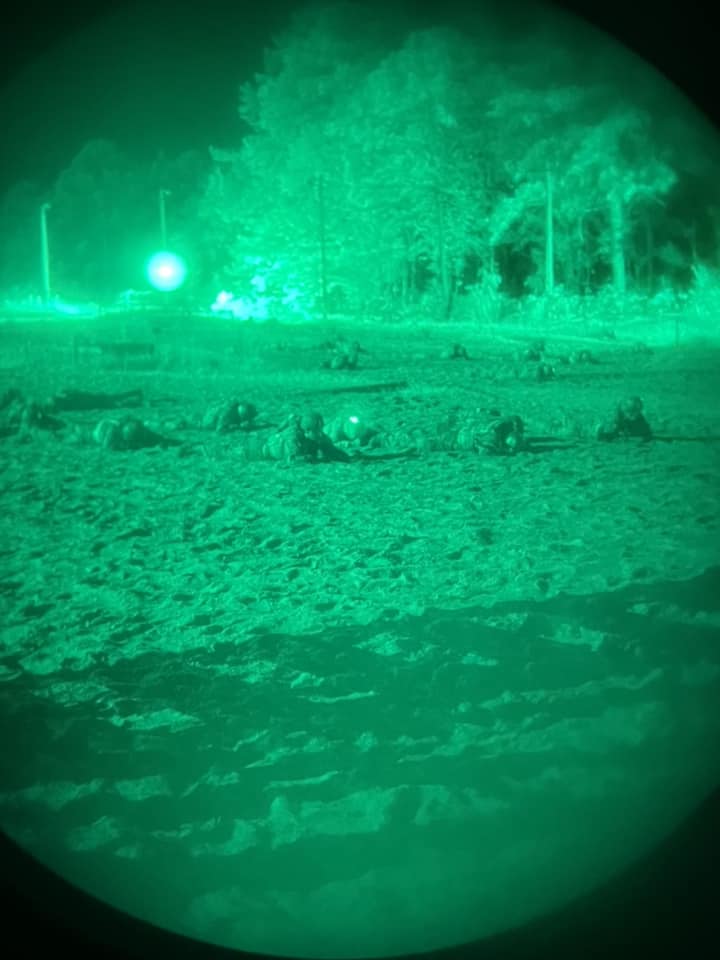
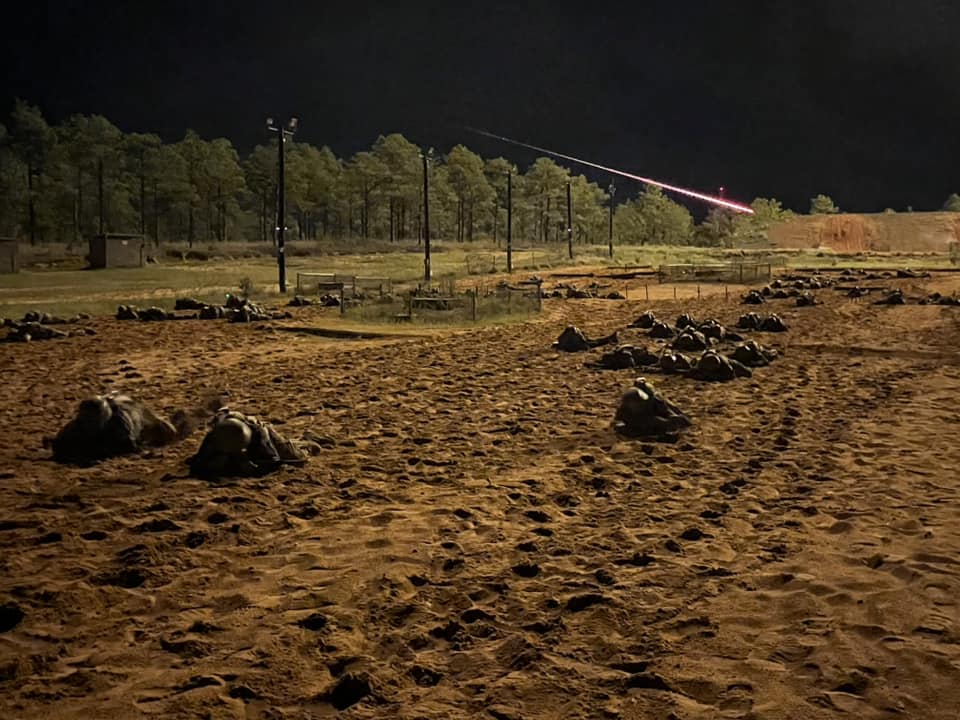
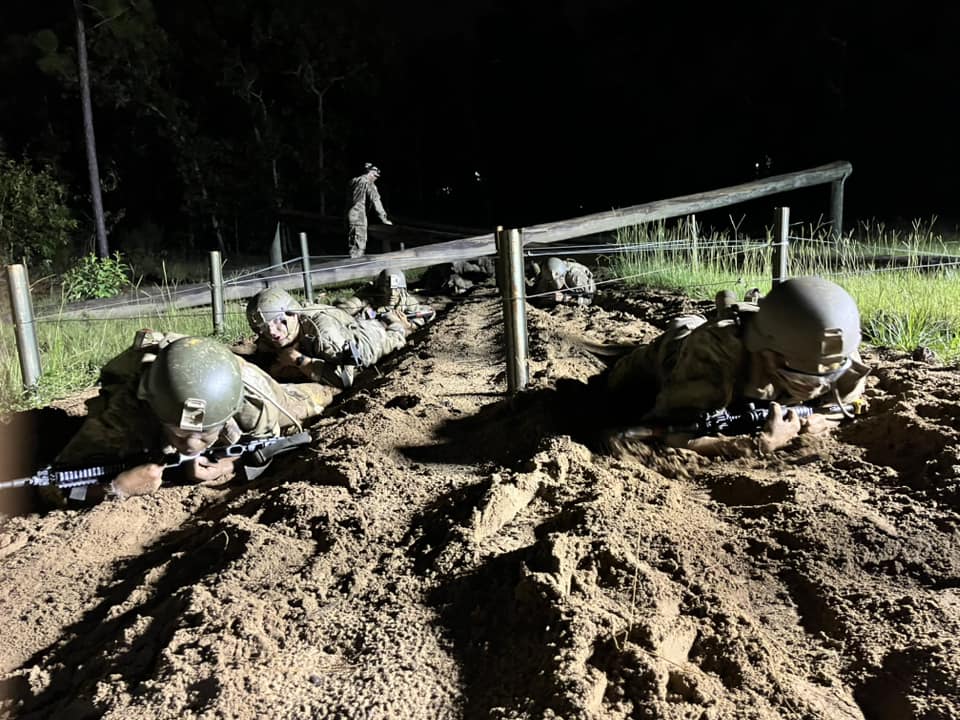
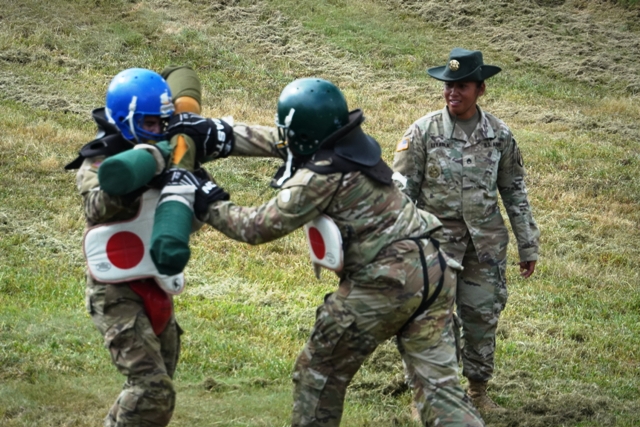
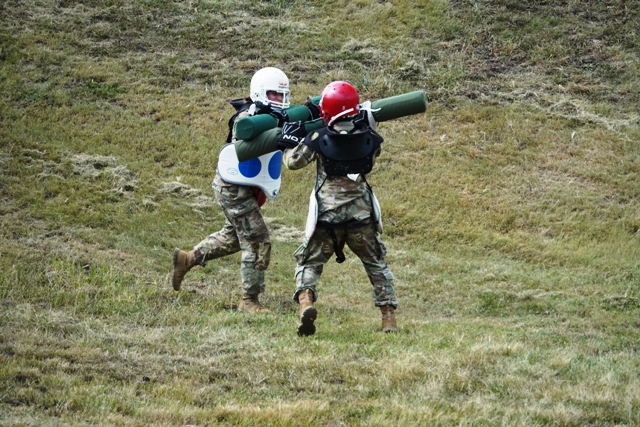
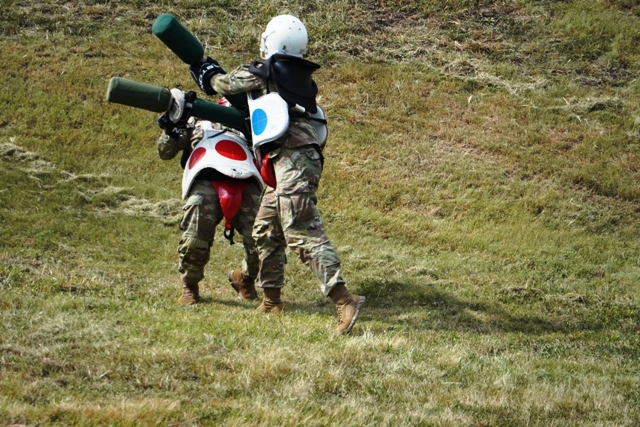
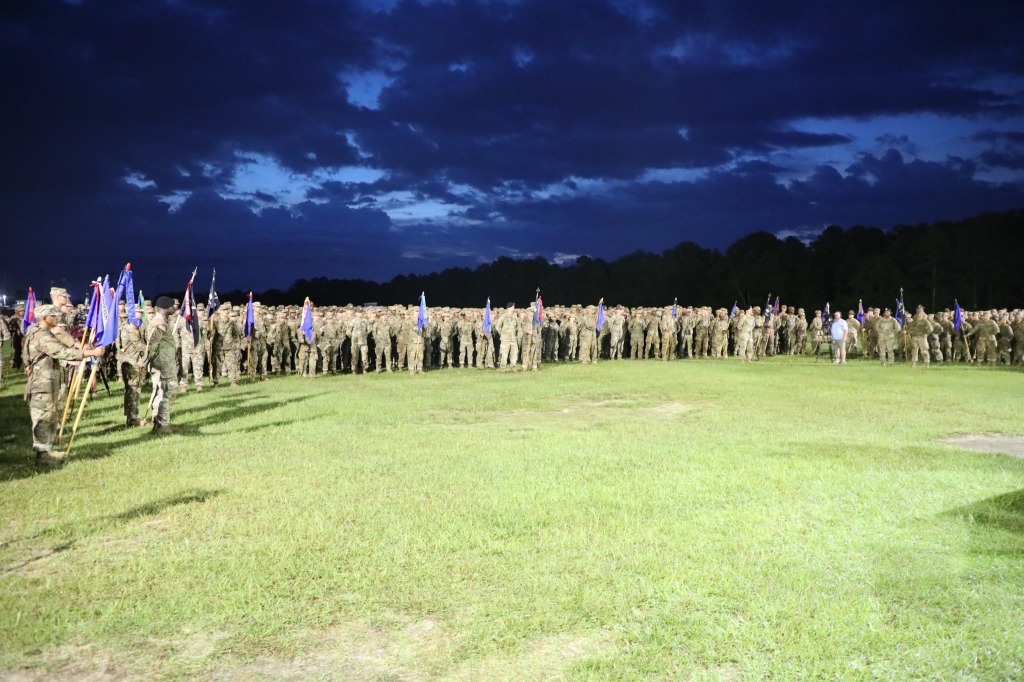
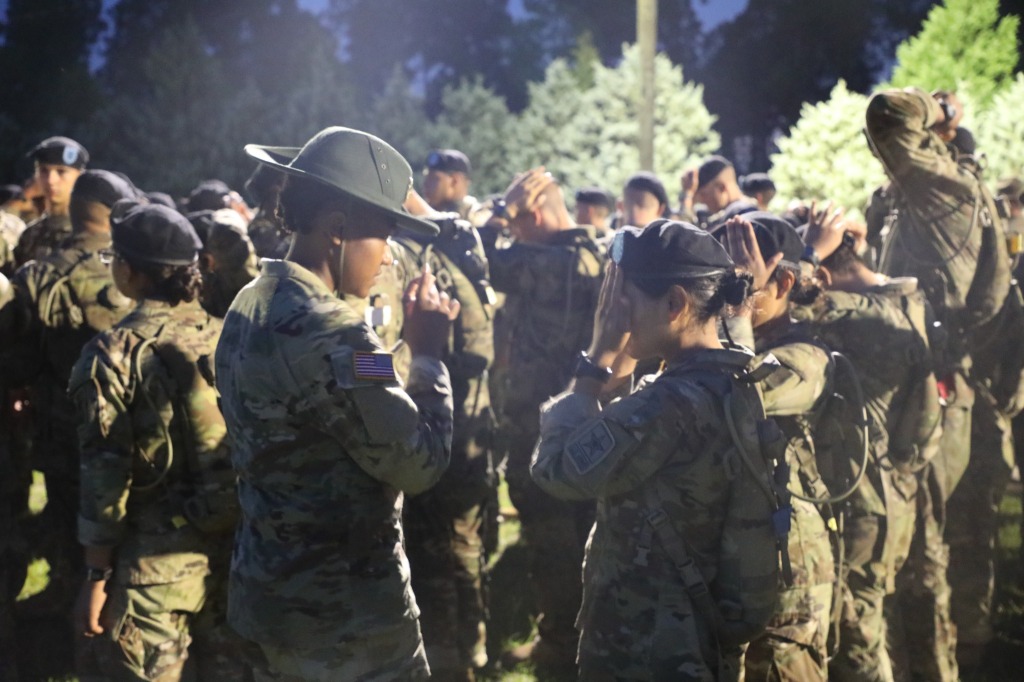
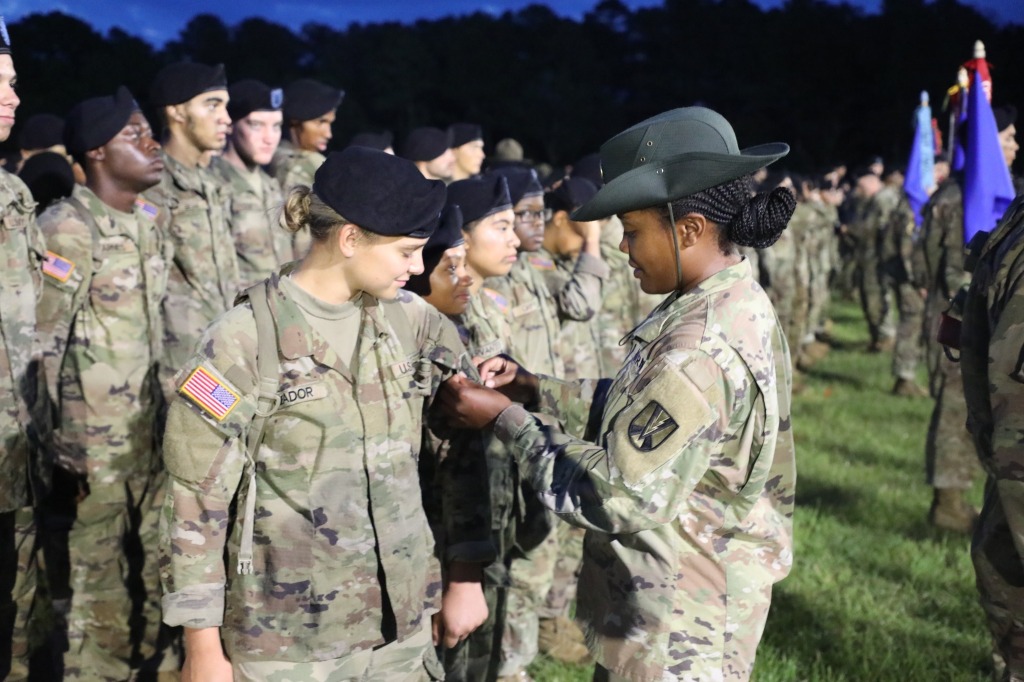
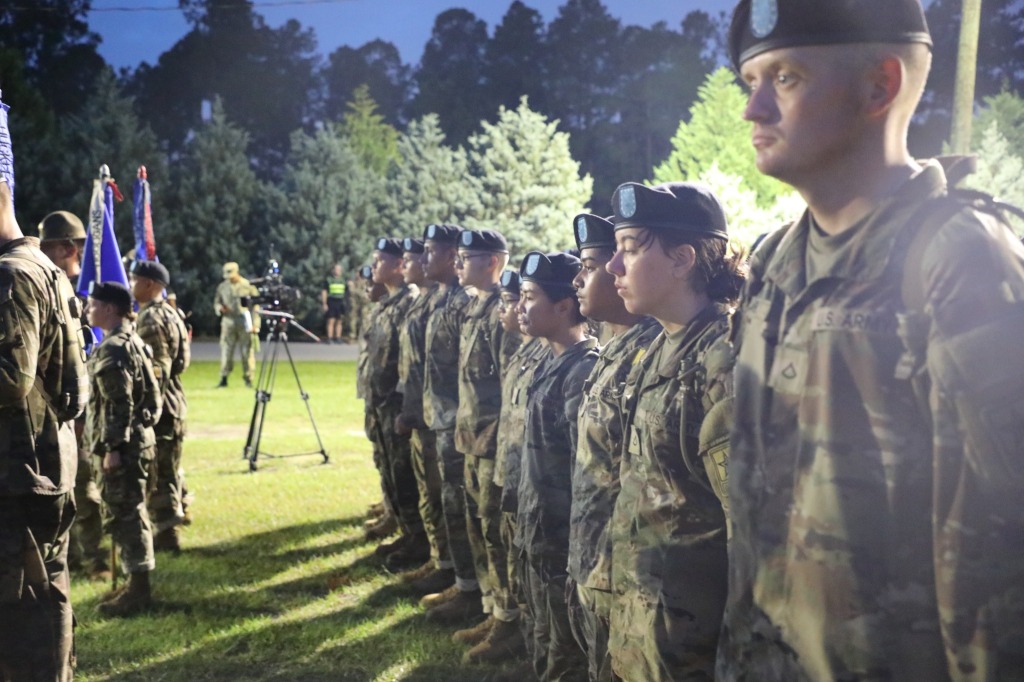
GRADUATION!
